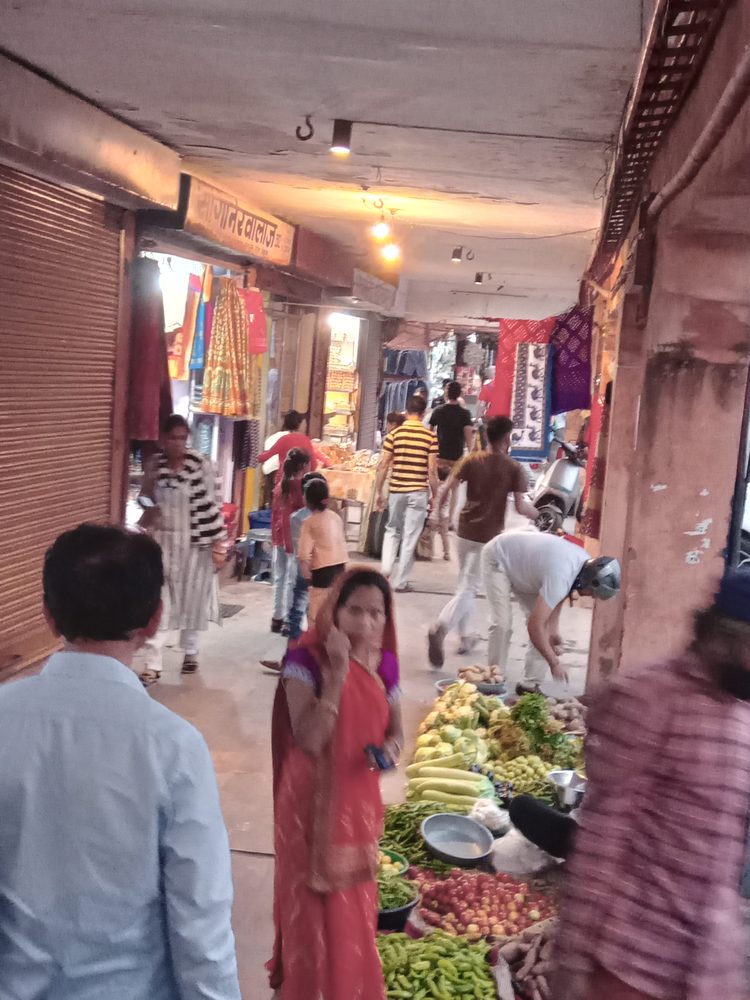 In the early evening, we went on an adventure!
In the early evening, we went on an adventure!
Welcome!... but please note... this page is a Work In Progress!
The text presented thus started life as the itinerary provided by Odysseys Unlimited. I've tweaked it here and there to incorporate material from the excellent additional itinerary we were given upon arrival in Delhi. Any times given are either from that second itinerary, or note made by me while on the trip. Our tour directors made a few changes to even the second itinerary, to respond to circumstances, take advantage of unexpected opportunities. They asked what our preference would be, and all of the changes made very good sense to me. Those changes sometimes must have required work "behind the scenes"... rearranging transport, for instance. But that was handled seamlessly by our tour directors or Odysseys Elves. It was brilliant.
At the moment, you will notice thatso far most of the text below was created by Odysseys Unlimited. I hope to redress that balance in due course! But the excellent itinerary is a) reliable(!), and (b) a good start, a good outline for this, my trip report.
I may have failed to revise what is below to reflect small differences between the plan and what we actually did on the day.
The images are mine, apart from the Google map images and the recurring small map showing the overview of where we went, which was done by Odysseys Unlimited.
The "Day" numbers given by Odysseys Unlimited started from the day that most of the group departed the US.
For a while, until the trip report is more mature, this page will be "too big". Sorry. I will break it into multiple pages in due course.
Friday, November 3, 2023
DAY 2 (yes, "2"... "1" was leaving the USA for some of the group): Arrive Delhi- (Text of official itinerary heavily tweaked for this entry of this trip report): The bulk of the group spends the day en route from the USA to Delhi, India’s capital and second largest city. Arriving after midnight during the night of 3rd-to-4th November, the group transfers directly to the hotel.
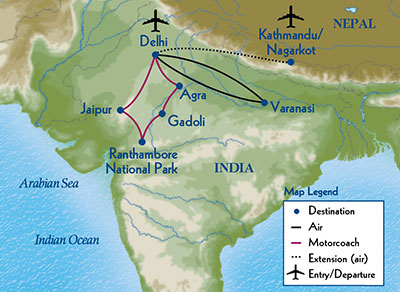
I arose in the UK on the morning of November 2, took off from Heathrow at 8pm, and next went to bed in Delhi, eve of November 3rd... when the UK was in the mid-aftrnoon of the 3rd.
I flew out of London- Non-stop with Virgin Atlantic... who took very good care of me.
As on previous trips, the flight passed over several fascinating regions.
With the excursion to Nepal at the end of the trip, the passage over the Himalayas was particualry exciting, but there were other great sights, too.
I chose a flight which arrived in Delhi early on November 3rd so that I could enjoy the peace of mind brought by that knowing a flight delay will not compromise joining a tour. In a city like Delhi, an extra week can be put to good use. Using an extra day is easy.
My hotel arranged a car to collect me from the airport; the journey to the hotel went well. The road was much improved since I was last in Delhi (2014)!
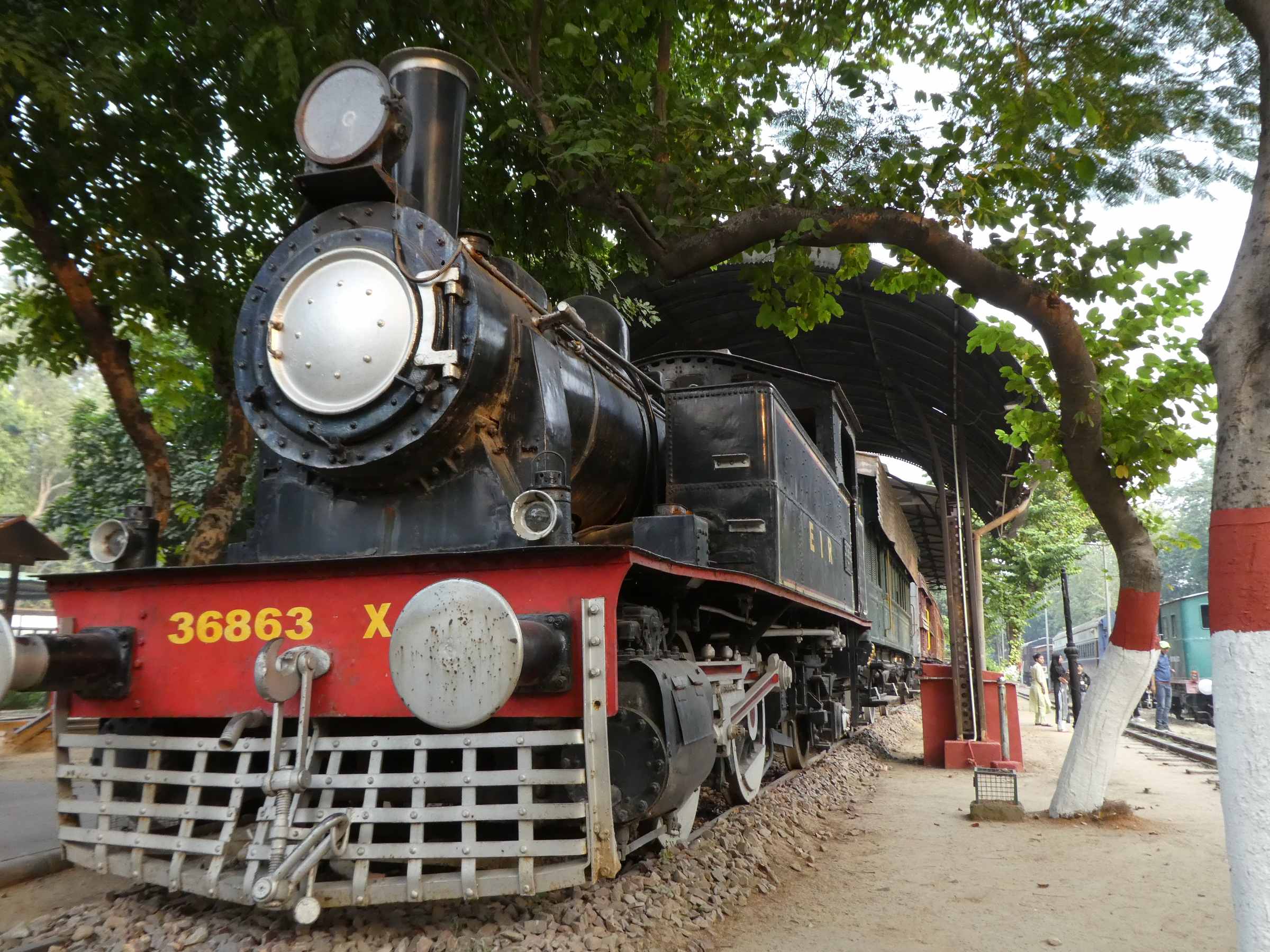
I gave myself a quiet day, but the National Railway Museum was a very easy taxi ride from my hotel, and I spent some time there in the afternoon. The railways are a huge factor in India's journey to where she is today, as I will talk about more elsewhere.
Accommodations: Taj Palace New Delhi
Saturday, November 4, 2023
DAY 3: Delhi- This morning we are at leisure before meeting with our tour director at 11:00 for a briefing on the journey ahead.
This wasn't my first meeting with our tour director. He had taken the trouble to arrange a personal "introduce ourselves" meeting the day before. I believe he did that with many of the group.
He was very impressive from beginning to end. A nice conference room was arranged for the group meeting. Important matters were covered there, and a useful start was made on the process of bonding the group together.
After the meeting, an excellent light lunch was provided for us in the same sumptous room.
Day 3 continued... We met in the lobby at 12:30, and headed out to encounter Old Delhi, capital of Muslim India between the 12th and 19th centuries.
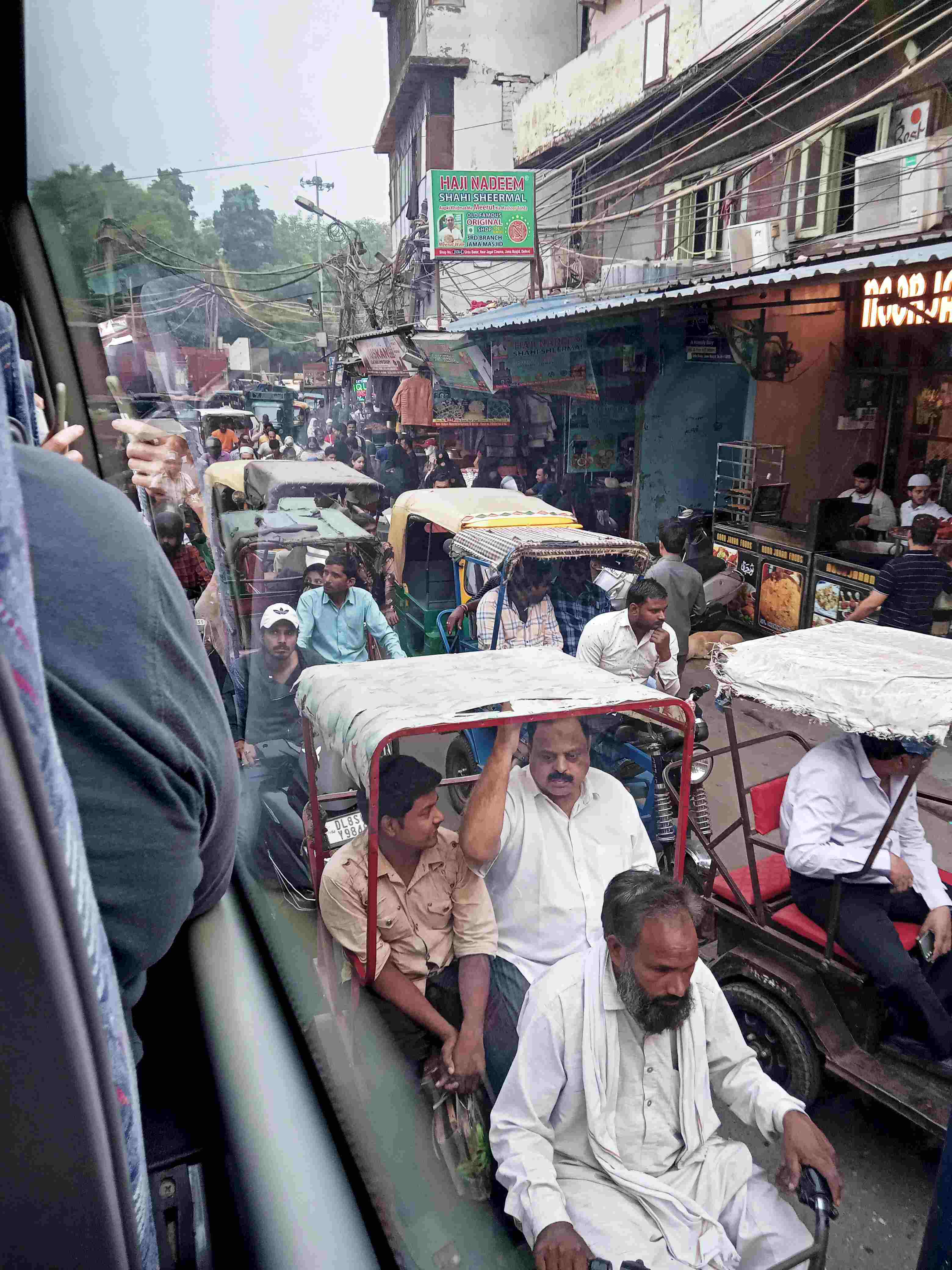
Day 3 continued... Our tour of Delhi begins with a visit to India’s largest mosque, the red sandstone and marble Jama Masjid, completed in 1656 as the last monument commissioned by Emperor Shah Jahan, builder of the Taj Mahal. (Shoes and shorts are not allowed into the Mosque, and proper coverings for women and men will be
provided before the visit)
En route, we drive past Lal Qila, the Red Fort complex of palaces considered the greatest of all Delhi’s earlier cities and today a UNESCO World Heritage Site.
Actually, our first outing began with our first experience of our wonderful coach, its driver and his assistant... and the Delhi traffic. I want to put more about all of them into this report. Consider this a placemarker for now!
(By the way, I WILL change the balance of words and pictures soon, but various things need to be established early.)
The Jama Masjid is extremely impressive, on many levels. I'd been to it before, of course, but I could happily visit it at least once a month. A special place.
This was the first of many times that we met with Indian citizens- tourists like ourselves, or families and friends out for a pleasant day. And there were worshippers using the mosque as well, but as we weren't there at the time of a service, that wasn't particualarly evident. It is a huge place, and gentle, non-judgemental tolerance is the rule in India. There was room for everyone.
Many Indian people want to meet people from abroad, and many love to have their picture taken with a foreign tourist or two. It can be a bit like being a celebrity, which is a bit odd... I'm not "anybody"... but if you go with the flow, a good time can be had by all. There's never anything pushy about this kind of encounter. Well... until others see that you are willing to be photographed. At which point you may find you have lots of customers. But it is always good natured and polite.
Ummm. The same cannot always be said of the street vendors! However, once you master the art of completely ignoring them, the problem goes away.
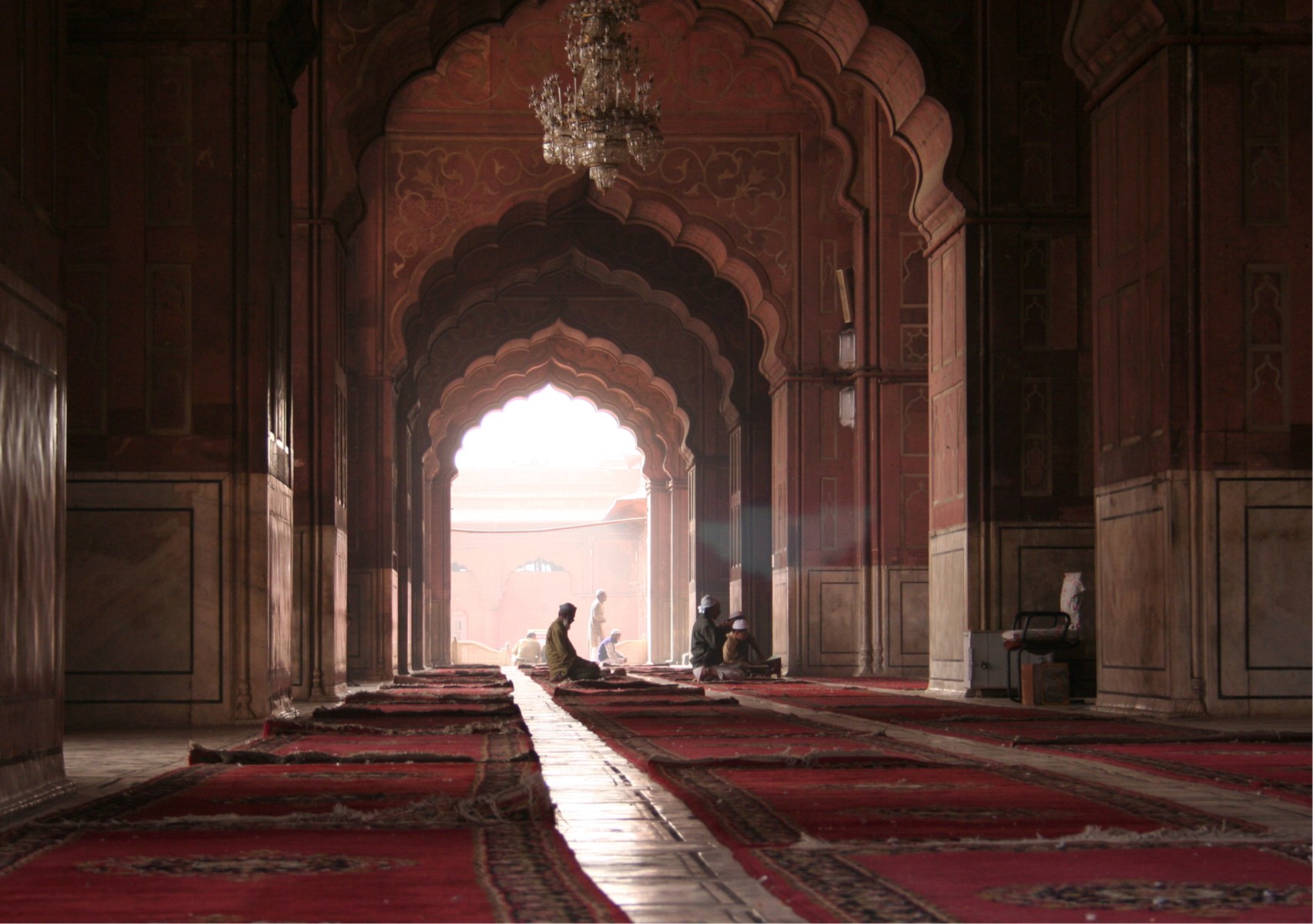
Confession: While the picture on the right is my picture, it comes from my first visit to India.
At one point I thought I'd lost many of the photos I took in the trip.
I thought that from about 25 Nov 23 to 8 Apr 24...
........... BUT I'VE FOUND THEM!!! All FOUR HUNDRED AND FORTY OF THEM!!! Whew! Hurrah" I could weep with joy!
In a moment I'll give you what I'd said previously.
Here's the first the photo I noticed was "missing". I'm thankful that I already knew it has lots of problems... but this group held the best photos of the trip until I messed up the taking of them. There's a story that goes with it, too. (That's in the footnote.)
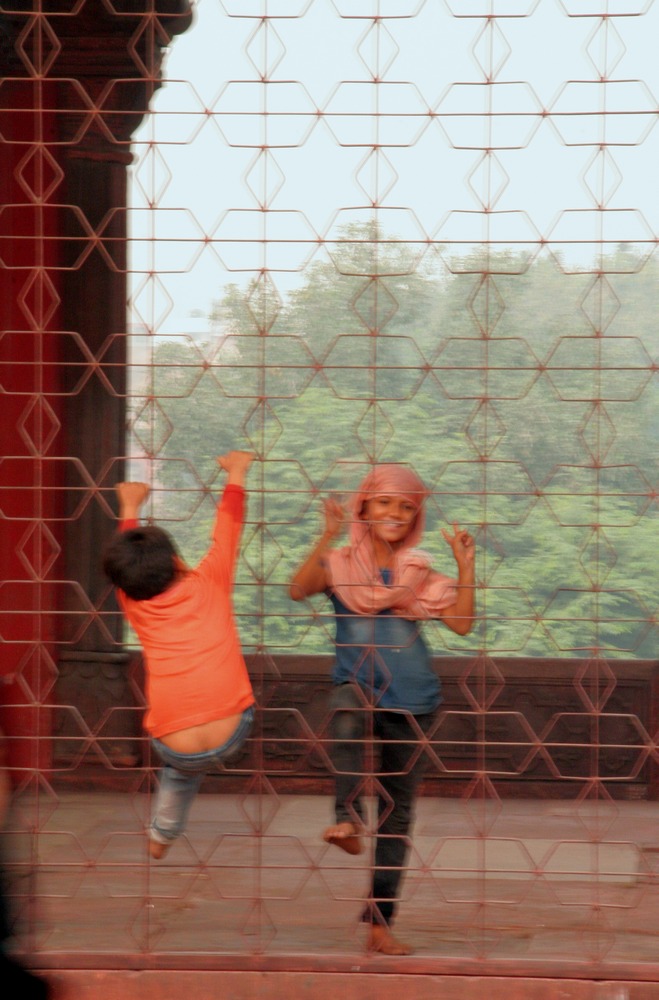
By the way... note that the child in blue is a girl. It is unusual to see street girls, and even more unusual to see tom-boys... I hope she will be a trail-blazer for more of her kind... she was a fun kid!
I'm very short of time at the moment. I'll come back and clean this up... and start posting some of the other lost photos in due course.
Sadly, I lost a bunch of photos... most of my "in Delhi" photos. The sad tale, and a little whine about being disappointed with my performance as a photographer on my 2023 trip, is told in more detail in a footnote I've provided. (I hope to produce more footnotes. They will be little bits of extra explanation for the really keen... and places where I'll put things *I* want to remember, but you might not find riveting.)
I initially thought that it was only this block of photos that I lost, but I've subsequently become aware of other gaps. I wish I knew how it happened!
In the case of the lost photos footnote, there's a longer discussion of my meeting with two stick-insect street kids... one of them a tomboy girl- not common in India. She was 10 years old, if that. As we were boarding our coach, she reappeared, trying to sell stuff. She quickly realized that I wasn't going to buy, but then started a game of pretending I might, playing at very aggressive selling. I took a chance... which I got away with!... and borrowed a very substantial stick (5 feet long, two inches thick?) from someone in the crowd... and "attacked" the waif with it. Happily, she fell about laughing. I am so sorry not to have any photo of her, especially the one discussed in the footnote. Oh well. the glass was well more than half full, overall.
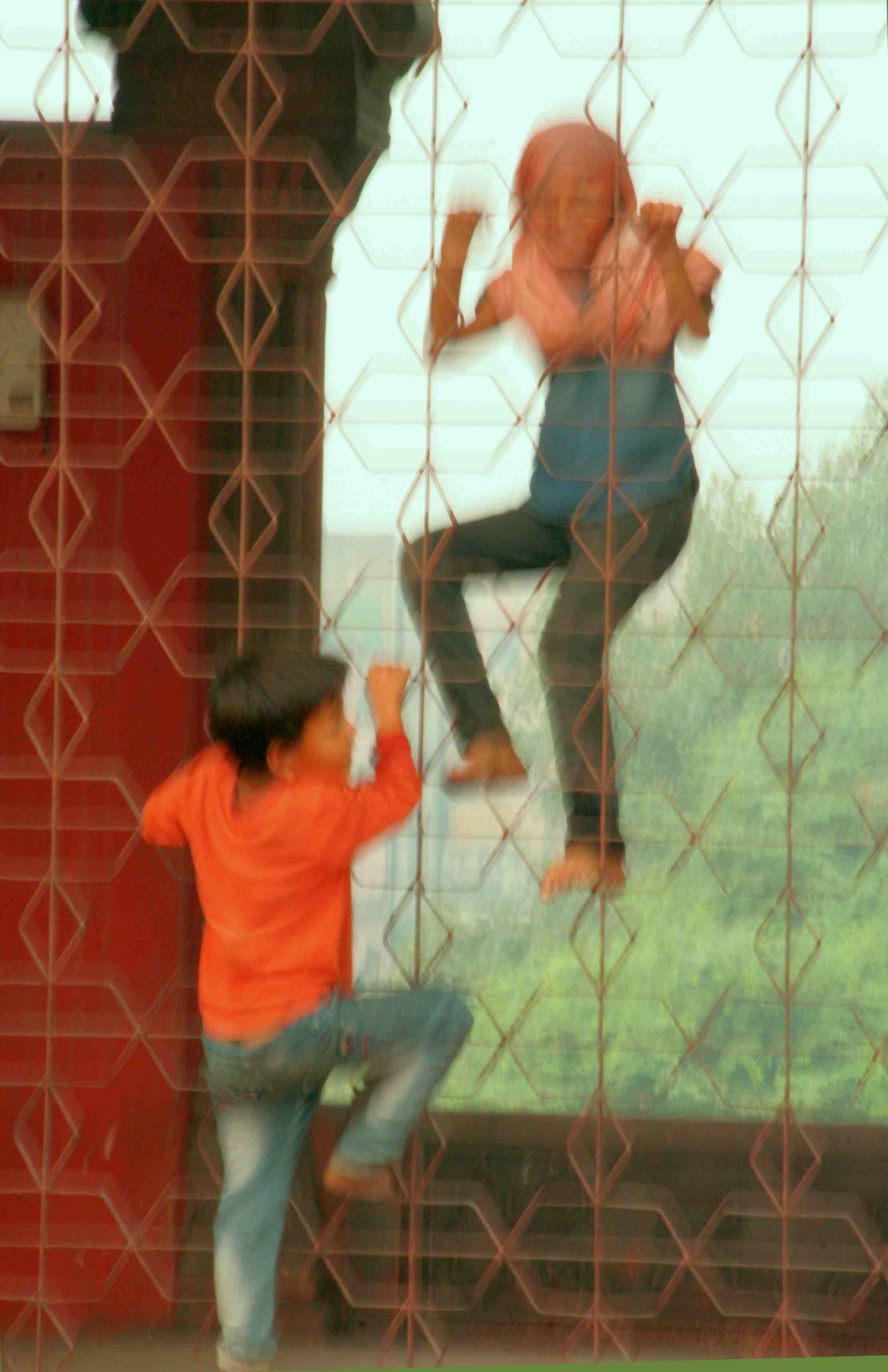
Our excellent tour director... (have I applied that adjective to him before?)... had a very welcome answer to the problem of street traders: He would select samples of the wares on offer, bring the on the bus as we were departing a stop. Those who wanted this or that could buy it. Those who didn't were spared the hard sell. And the street traders didn't go away empty handed.
The quality of what was on sale was of course variable... but usually the few pennies being asked for a trinket were well below its value. It was seldom rubbish.
Day 3 continued... From the Jama Masjid, we ride rickshaws through bustling and colorful Chandni Chowk market, one of Delhi’s oldest and busiest, and where Mughal emperors once shopped.
This needs a comment! It was wonderful. I've done it before, and didn't begrudge doing it again for those who hadn't... but found it much more fun than I'd anticipated.
Day 3 continued... We finish the day's sight-seeing with Raj Ghat, the Mahatma Gandhi Memorial consisting of a simple black marble slab honoring India’s beloved leader. The political and spiritual leader of India’s independence movement, Gandhi was renowned for his advocacy of civil disobedience as a form of nonviolent resistance.
It was special, at the end of our first day, to experience tranquility of the gardens, the respect being shown for the memory of the Mahatma.
The Raj Ghat, Ghandi, and India's relationship with her memories of Ghandi need at least one photo and some discussion. It will come! But I'm trying to get highlights written up first. There will be many gaps, for some time to come. And again sadly, few of my photos of this part of the trip survived.
Day 3 continued... After the Raj Ghat, we return to our hotel and in the evening enjoy a welcome dinner at the hotel's Loya restaurant tonight.
Accommodations: Taj Palace New Delhi
Meals: Breakfast, Dinner
Sunday, November 5, 2023
DAY 4: Delhi- We have another day to discover Delhi, India’s energetic capital which has been inhabited continuously since the 6th century BCE. At 573 square miles and boasting some 25 million inhabitants, Delhi prides itself both on its rich history and vibrant contemporary culture.
We begin today with a trip to Qutb Minar, one of Delhi’s most visited and striking monuments. Sultan Qutb al-Din Aibak laid the foundation for the monument after defeating the last Hindu Kingdom in 1200 CE. With a height of 240 feet, this red stone tower ranks as the highest brick minaret in the world.
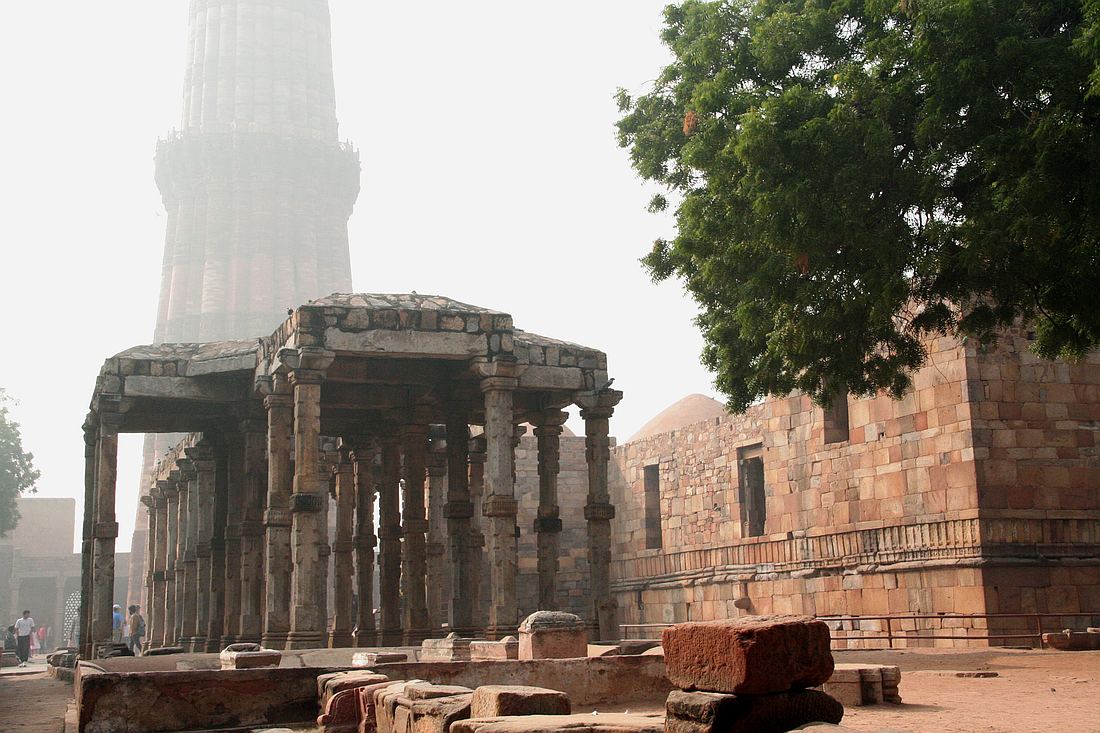
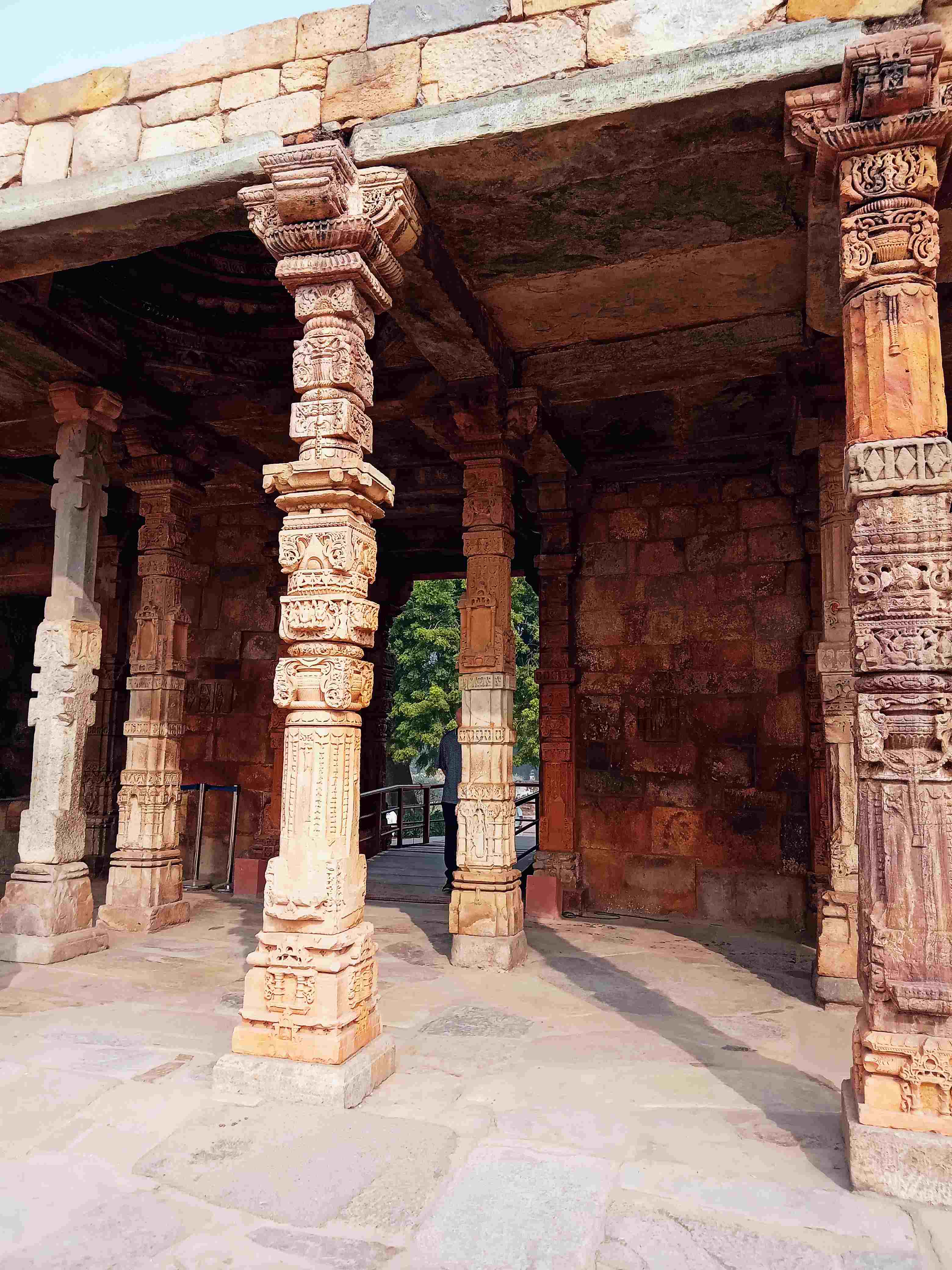
The complex holding the Qutb Minar deserves a page of its own. The minaret is... perhaps... the "headline" feature, but the iron pillar (not shown here) is a strong contender. And then there are the ruins of what was a vast mosque. (Also not shown here.) What IS shown above, beside the minaret is "small" thing, brought to our attention by our excellent tour director...
The builders of the site were not too proud to re-use artwork from earlier traditions. If you look closely at the pillars you will see elements from at least four periods, and at least two faiths.
Day 4 continued... Next, we pass by India Gate, the majestic 137-foot high arch that stands over an eternal flame to honor the 90,000 Indian soldiers who died fighting alongside the British during World War I and the Afghan wars. We then drive closer to the President's house.
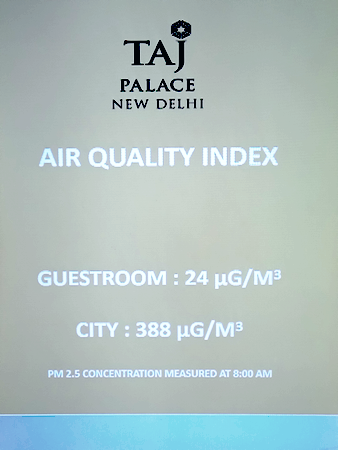
The deterioration in the air quality since my last visit was shocking. We could not see even a faint outline of the presidential palace from the India Gate.(The image shows the display in our hotel lobby- Pariculate matter: Outside air 388 µg/m3 // Guest rooms 24 µg/m3.
The "Afghan wars" mentioned in the description of the gate, by the way, were not the recent ones where the locals objected first to the Soviets, and then to USA troops, but the older Afghan wars, when the Afghans were objecting to the British colonial ambitions. Fly over Afghanistan going to or from Delhi, and look at the terrain surrounding the flat bits. You will understand that outsiders will only "conquer" Afghanistan by a complete genocide.
Day 4 continued... Following lunch at a local restaurant, we visit a Sikh gurdwara (temple).
At the beautiful Bangla Sahib gurdwara...
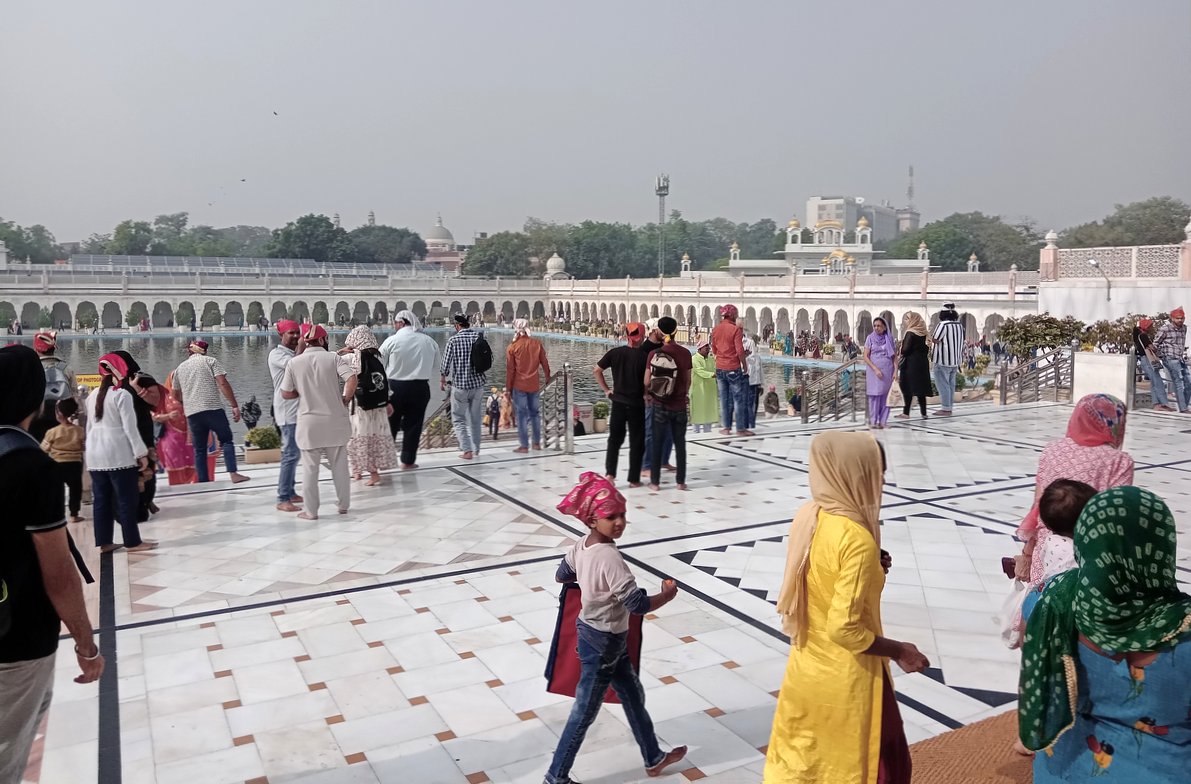
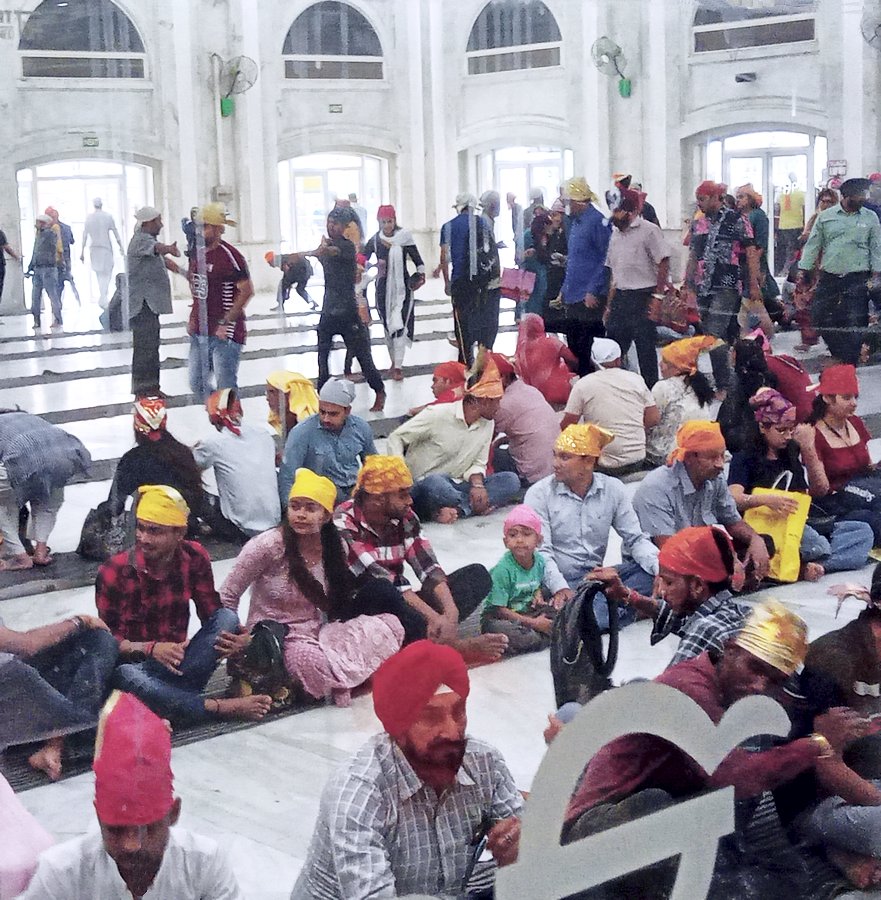
...besides learning more about this important faith, we also witnessed one of the free meal services provided at religious houses of all faiths. This one was serving 20,000 meals per day. All of the work done by volunteers. The meals continued thorough the time of Covid. I'll have more... much more!... to say about the meals! (It isn't just the Sikhs who offer them by the way.) And I have some photos to add to this account. Wait 'til you see the pots the rice is cooked in!
One thing I had not been aware of: People from every tier of society partake of these meals. A "learning experience" for the children of families who do not need the free food. And other more complex things which I can't explain properly.
Providing the meal is, of course, good karma. Another subject that isn't simple.
Day 4 continued... Next we will be able to learn more about Gandhi at the Gandhi Smriti (or “Gandhi Remembrance”), a museum located in the building where this Indian icon spent his last days before being assassinated.
The building was, back then, a private home where Ghandi lodged when in Delhi. Daily, he led evening prayers in the extensive garden. It was during these prayers that he was killed. He had been working hard all day, someone said of the next task, "Oh, leave that for the morrow. You've done enough today." He said, "I might not be here tomorrow."
After a very long stuggle to win independence for the people of India, and contribute enormously to the creation the modern nation, he was killed when the country was only six months old.
Killed by a fellow Hindu, who was enraged that Paskistan (East and West, i.e. the 2023 Pakistan and Bangladesh) might receive money from Indian coffers. (He thought murders of Hindus by Pakistanis arsing from the upheavals of Partition disqualified them. He was conveniently forgetting the Hindu murders of Pakistanis. The money was already agreed by the relevant governments; arrangements were in place. It was a done deal.)
In some places, the assassin would have been torn to pieces by the large crowd assembled for prayers. Or had a fatal accident while "in custody".
In this case, he had a full trial. Was found guilty. And hung. (Capital punishment is still part of the system... and used once or twice a year in the world's most populous nation. (China, of course, has nearly as many people... but after that, can you name... preferably in order, with some knowledge of their sizes... the next most populous nations? The next (after China) 5 countries together do not have as many people as India or China. If you leave out the third most populous nation, it takes the next seven nations to equal either of them.) (Can you name the 5 nations other than India and China which have more than 1.9 billion people? (in order?)) (Answer further down the page!)
And yet India, with about 1/3rd of the area that the USA has, has vast open spaces, very sparsely populated. Even though India has more than 4x the population the USA has. (If it would amuse you to look at this some more, you can go to...
https://en.wikipedia.org/wiki/List_of_countries_and_dependencies_by_population
... and...
https://en.wikipedia.org/wiki/List_of_countries_and_dependencies_by_area
(All of that triggered by "one or two executions per year!)
Getting back to the Ghandi Smriti...
The excellent material about him and his times elevated the museum far above just a ghoulish "see where he died" carney show.
The relationship between the people of India today and the legacy of Ghandi is very complex. I won't pretend to have a good grasp of it, beyond that, but if you would understand India, you need to include it.
There were parallels between this museum and the also excellent National Civil Rights Museum in Memphis, TN, USA, on the site of Martin Luther King's assassination.
Day 4 continued... We return to the hotel mid-afternoon and have the remainder of the afternoon and evening for exploration (or relaxation) and dinner on our own. Our hotel has a variety of restaurants, and our tour director will also be available to provide recommendations.
Our hotels, by the way, were universally outstanding... but also delightfully varied. (I plan to do more on the subject.)
Accommodations: Taj Palace New Delhi
Meals: Breakfast, Lunch
==================================Monday, November 6, 2023

Arose in Delhi, went to bed in Jaipur.
Our day started in Delhi, but as early as was reasonable, we set out in the splendid coach that was to be our "home" for many days, in order to arrive in Jaipur by the day's end.
The start was moved up from the original plan... an important holiday was drawing neigh, and our tour director and the driver wisely asked us to depart earlier... which probably saved us a lot of time. We were clear of the worst roads before they seized up.
The driver and his assistant could not have been better hosts to us. I particularly appreciated the great deal of time spent keeping the windows immaculate, so that photography from the coach could give the best possible results.
DAY 5: Delhi/Jaipur- We depart Delhi this morning and travel southwest by motorcoach on the day-long journey to Jaipur, stopping en route for lunch.
I'd already been to India twice before the trip reported here.
When a friend brought this trip to my attention, I was delighted to find that it mostly involved placed I had not been before... including Rajasthan. Someday I hope to go more deeply into Rajasthan, but Jaipur was very satisfactory.
While Jaipur is not fully into the desert region, the climate (dry), ecology, economy and terrain were, as expected, very different from places I'd been before in India.
I especially enjoyed the very serious hills. Not quite mountains, to my taste, but pretty close. In places was almost like being in Colorado, with rugged hills instead of big mountains.
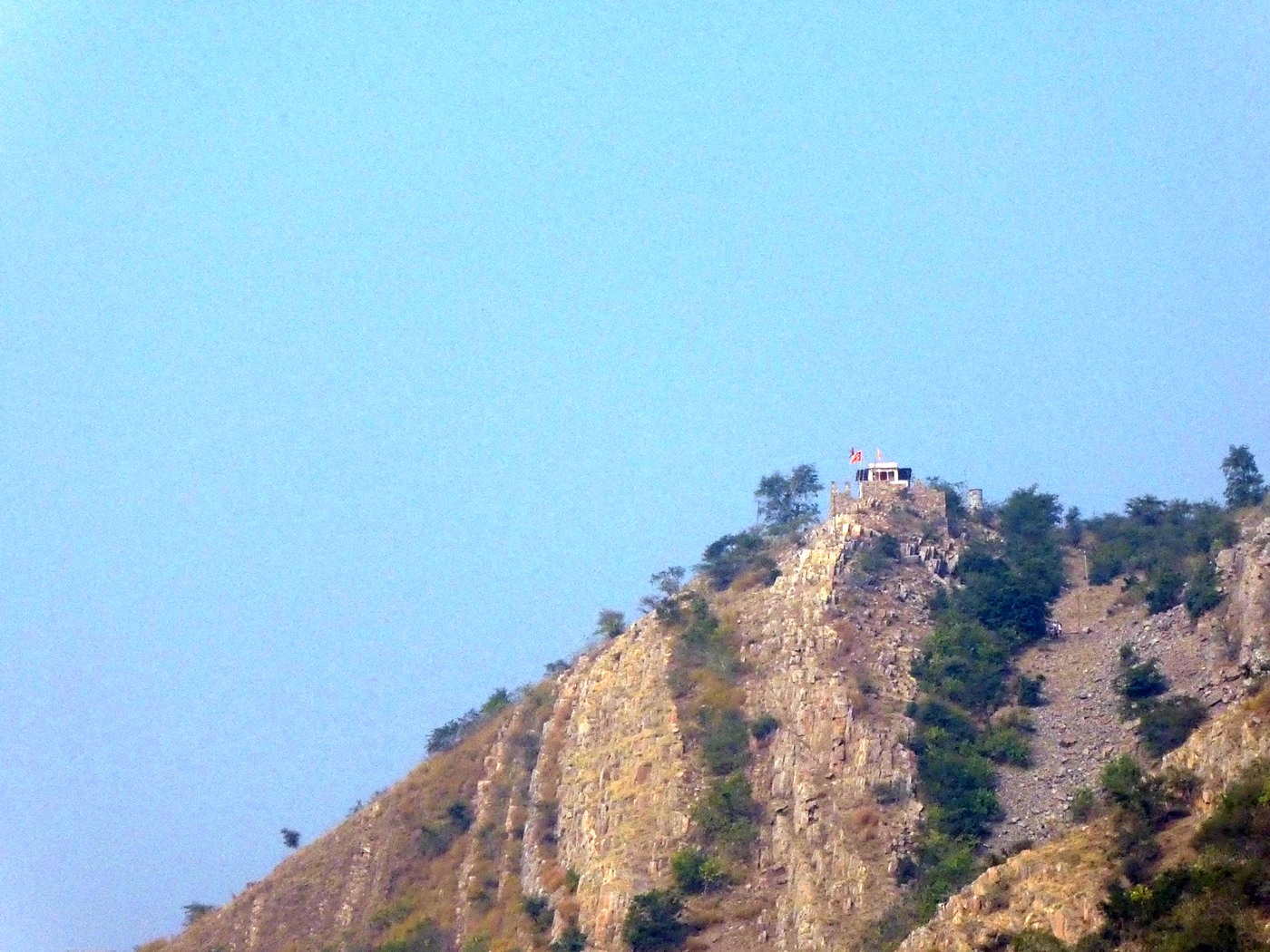
Someday, I hope to visit Jhodpur- further west, deep in the desert. But Jaipur was a very satisfactory first taste of Rajasthan!
Day 5 continued... Jaipur is one of the great cities of the Rajput – an Indian cultural caste associated with warriorhood and great courage in battle. We reach Jaipur late this afternoon.
The day was skilfully paced, and didn't seem long. This was a welcome feature of Odysseys Unlimited's organisation of our tour which I noticed several times.
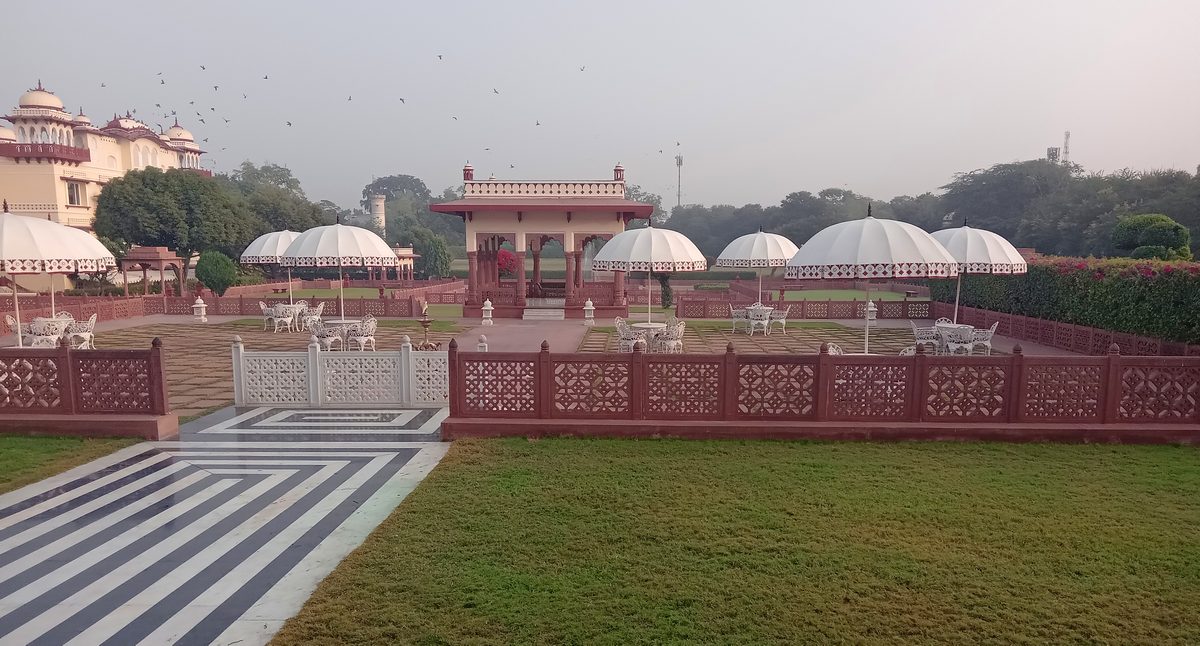
The hotel buldings and grounds were beautiful.
 In the early evening, we went on an adventure!
In the early evening, we went on an adventure!
Our excellent tour director took the twelve of us into the thick of the markets in town, on foot. (We went to the edge of the markets in our coach, and were collected by it later.) We crossed busy roads, Indian style. We were in dense crowds. No one got lost! It was great fun, and we spent time among the ordinary people, sharing their daily lives. It was one of the highlights of the trip for me.
There was excitement in the air, as it was nearly Devali, but I think the bustle and energy was what we could have experienced almost any night. Alas... this is another time where some photos went missing. The photo I do have, and have used here shows a "not very busy" arcade.
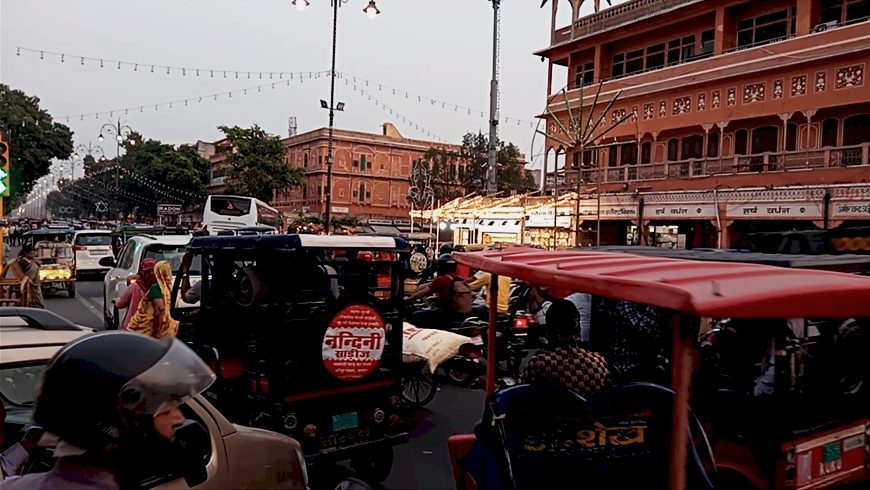
Our day ended with some delightful, very professionally performed, traditional dancing in the literally palacial grounds of our hotel, the Taj Jai Mahal Palace.
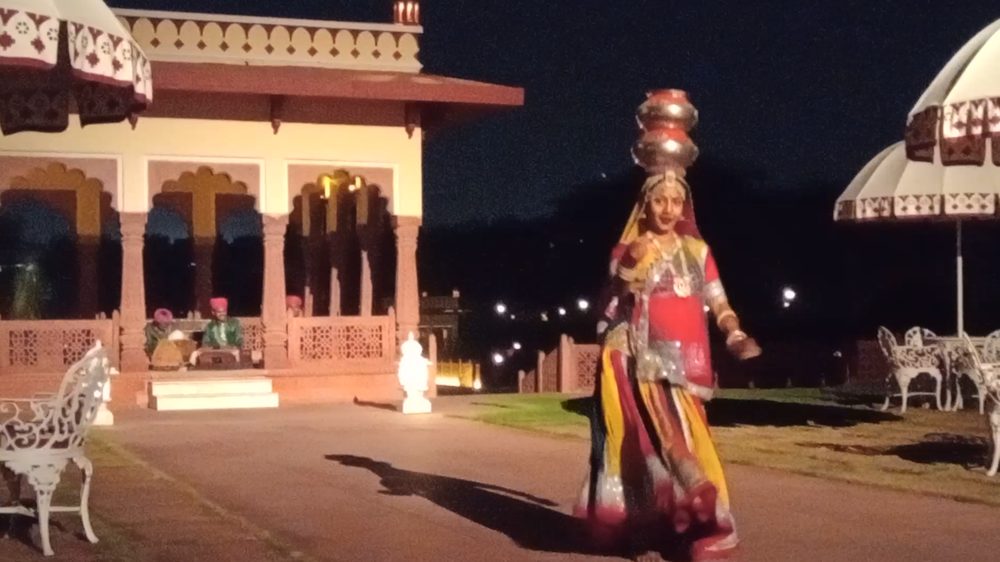
It dates from 1745, is, the web tells me "Indo-Saracenic" architecture. It has acres of gorgeous Mughal gardens. In the past, it was been the residence of three Prime Ministers of the princely state of Jaipur.
A remarkable aristocratic woman, wife of a not insignificant Maharaja of Jaipur, lived there. (He lived 1912-1970; she lived 1919-2009) She did Good Things for people and the nation. And coped admirably with starting life as a royal, but living to see the end of that system of government. (Admittedly, though she lost her rank, she remained extremely wealthy.).
She was also extremely beautiful.
(Going back to the question about populations... In billions...
(You knew all of that! (I didn't... I asked Wikipedia.)
Accommodations: Jai Mahal Palace (Taj)
Meals: Breakfast, Lunch, Dinner
Tuesday, November 7, 2023
WHAT we did on the day is set out clearly enough in the following, even if the WHEN is a bit confused at the moment.
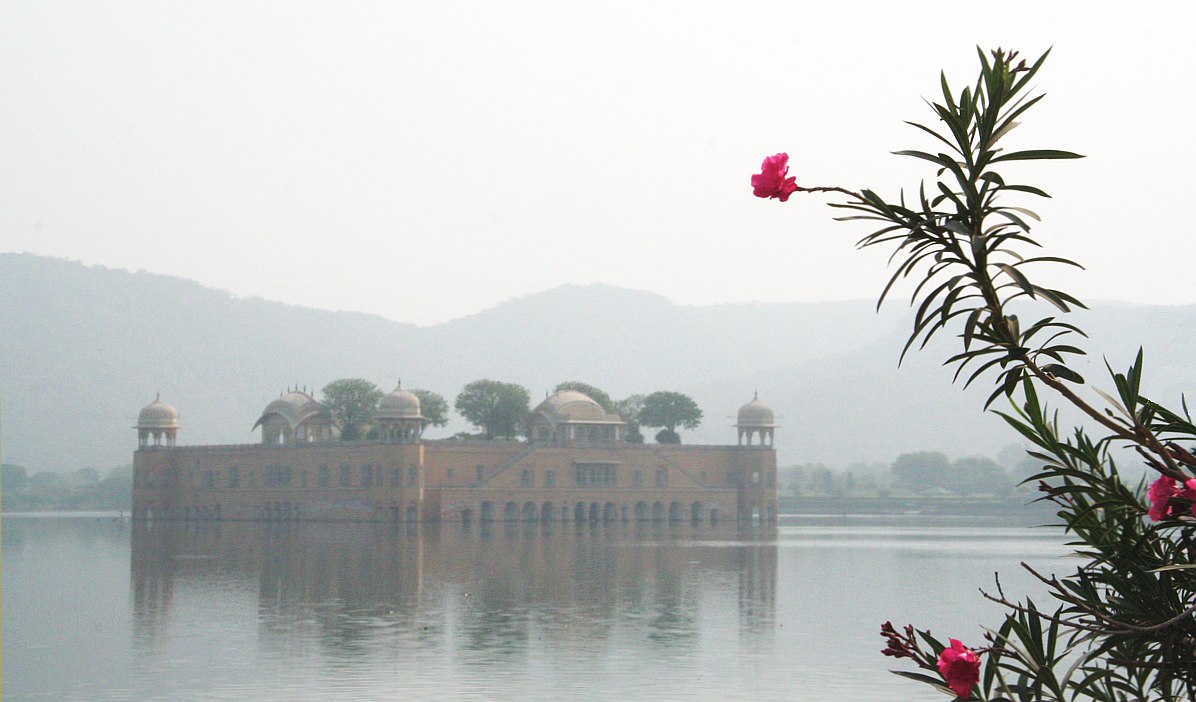
The following was certainly on the 7th. From when we were driving back from the AmberFort? In valley between there and Jaipur? (Yes! Thank you, Google maps. 26.9577, 75.8495... the Jal Mahal (built c. 1699)... and all that, since "Yes!", took less than 5 minutes!)(It was taken 6:06 UTC)
DAY 6: Jaipur- Jaipur was the home of India’s legendary Hindu warriors, whose historic forts, palaces, and gardens lend a timeless quality to this storied region.
Jaipur is called the “Pink City” for its buildings of rose-hued sandstone, the UNESCO World Heritage site of Jaipur retains the exquisite symmetry of its original construction, as well as the eight historic gates that protected the city centuries ago.
Day 6 continued... MUCH OF THE TEXT FOR DAY 6 LIKE THIS IS STILL AS GIVEN TO US BY Odysseys UnLiminted. I NEED TO EDIT IT. We did the things listed, but not in the order given at the moment.
We stop first today at Hawa Mahal, the elaborately carved “Palace of the Winds,” whose pink sandstone façade allowed the ladies of the court to view the streets of the city from behind its 953 small windows – and also allowed cooling breezes to enter.
Rough, and not "for certain" actual sequence: 1) Visit to Amber Palace (there at least 10:10-10:36. (Was certainly longer, but I have photos with those times) 2) Lunch at Bardari 13:16. 3) Jantar Mantar 14:19-14:22. 4) I was in a tuk-tuk... of to buy computer I think.(Made note about "pcJai" at 11:07)
Day 6 continued... We visit the City Palace, former residence of the Maharajas of Jaipur, built in the shape of the city itself and now converted to a museum that houses the rulers’ magnificent art collections.
Day 6 continued... We visit the City Palace, former residence of the Maharajas of Jaipur, built in the shape of the city itself and now converted to a museum that houses the rulers’ magnificent art collections.
Day 6 pp later itinerary... 8:30: Depart hotel for the visit to the Amber Fort, followed by a photo stop at the Hawa Mahal.
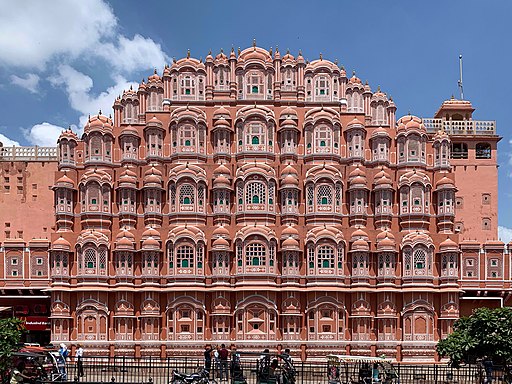
This photo is from Wikipedia. I took one... but it was among the ones lost :-(
It shows the facade of the Hawa Mahal, the "Palace of the Winds", shown in the photo is part of a street of joined up buildings in the center of the city. It had a fairy-tale air about it. It was built in 1799. (I'd particularly recommend an excursion via the link provided above, which takes you to the Hawa Mahal's Wikipedia page. It should open in a new tab. (You can set your browser to switch to that automatically, which is handy if you haven't already made that setting.) Close the new tab and your find yourself back here. Neat, yes?)
Day 6 pp later itinerary... 12:00: Lunch in the Baradari Restaurant, City Palace.
Day 6 pp later itinerary... 1:30: Visit Jantar Mantar Observatory and the City Palace
Day 6 pp later itinerary... 5:00: Return to the Hotel, or visit the V B Gemns for shopping (optional)
I had my "independent shopping" for new computer in this time slot! Quite an adventure. I'll try to write up soon!
Day 6 continued... After lunch at a local restaurant, we visit Amber Fort, a UNESCO World Heritage Site built by the Kachhawah Rajputs as their capital from 1037 to 1728 and considered the pinnacle of Rajput architecture. We tour the unoccupied citadel, approaching by jeep to admire the fresco-covered portal, the impressive room of mirrors, walls of jewel-encrusted marble, and the royal apartments offering beautiful panoramic views of the surrounding valleys.
Late this afternoon we return to our hotel; dinner tonight is on our own. The hotel houses several restaurants and our tour director will be happy to offer further recommendations.
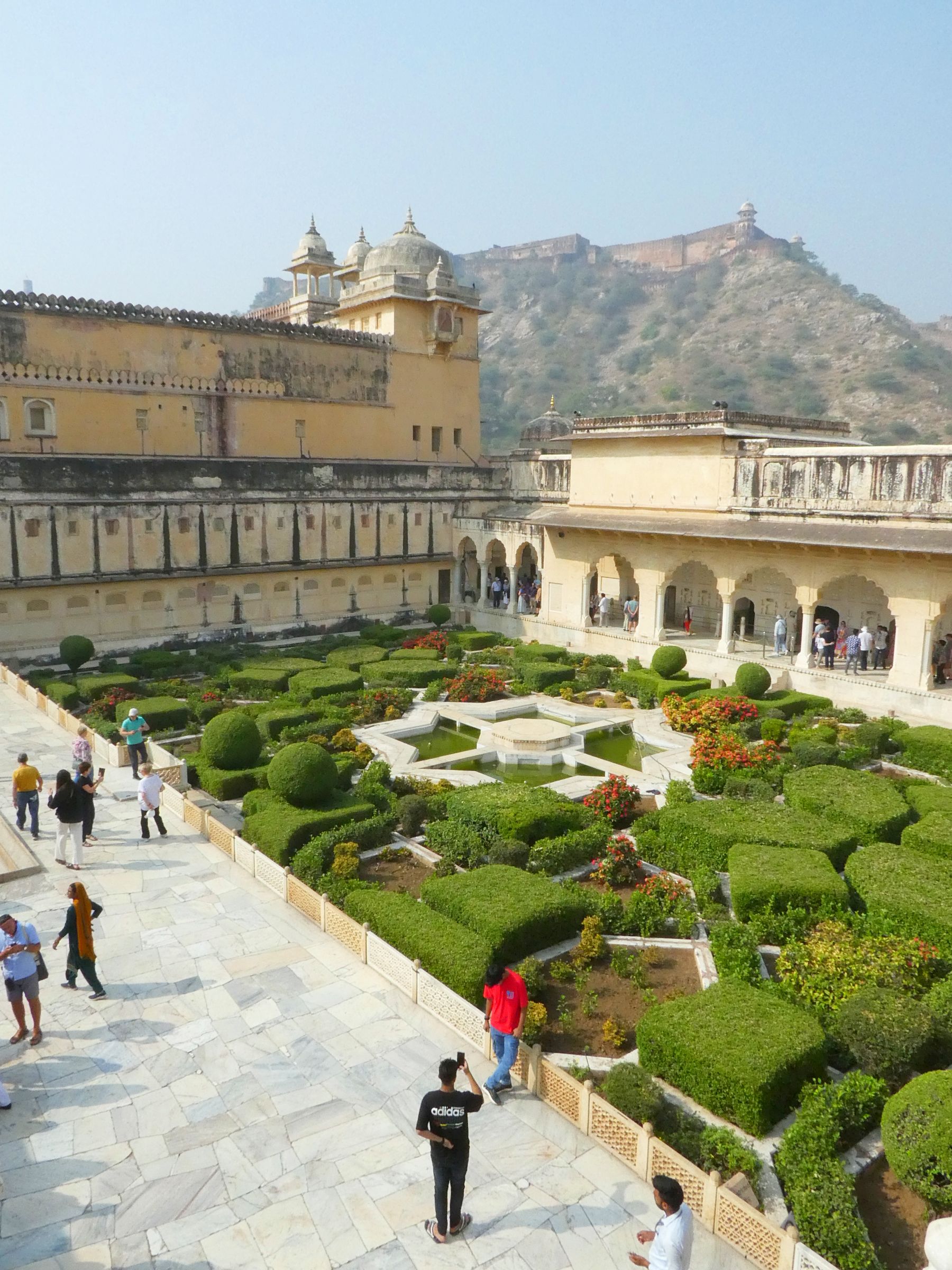
(We went up to the fort by jeep as there was no way our coach could have negotiated the track!)
In the days when the fort was the center of Jaipur, when the Raja left or returned, it was in a procession of elephants, which must have made a very impressive sight trudging down or up the hill, and going through the great gate of the great courtyard in the lower fortress/ city. Our tour director told this, and many other, tales very effectively.
The main subject of the photo is the Amber Palace. In the background, on the higher peak, you can see Jaigarh Fort, to which the occupants of the Palace could withdraw, in the unlikely event that the Palace defenses seemed unlikely to hold. (The Palace is on a (relatively!) "minor" bump on the flanks of the very substantial "hill"... small mountain?... that the fort is at the top of. The fort is about 400m above the palace.)
There is a defensive wall... think medieval castle... around the two of them... and an underground passage between them!
The Amber Palace and Jaigarh Fort were the seat of government for many years... but as times changed, climbing the hill became "old", and, in military terms, no longer necessary.
In 1727, the modern city of Jaipur was founded. I suspect people lived thereabouts before 1727, but in 1727 an energetic maharajah created one of India's earliest planned cities there, and when it was ready, moved down from the Amber Palace.
Jantar Mantar- Sawai Raja Jai Singh's observatory. I was very excited by the prospect of a visit to this.
(P.S.: Yes... this section is too big, and too poorly edited. I will, in due course, split it out to a subordinate page. But please... bear with me? I're really like it if I succeed in getting you as excited about this site that we visited... but I'll need you to make an effort?)
Sadly, but unsurprisingly, we only paid a short visit. I didn't even get to stand near the great "sundial" which can tell the time to... some sources say "about 20", others say "2 seconds". Apparently the shadow moves about a millimeter per second.(pp Wikipedia.) It was still wonderful to at least see the observatory.
Sawai Raja Jai Singh built it while he ruled the Kingdom of Amber from the last day of 1699, when he was 11, and his father died. Sawai Raja Jai Singh ruled until he died age 54 in 1743.
Besides building this observatory, he founded the city of Jaipur c. 1730. It the first planned city in India. (Paris underwent its comprehensive reforms and remodeling, making the "planned" city of today in the late 1660s. But of course that was a re-structuring of a long existing city.) I'm sure there was some kind of settlement at the site of Jaipur before Sawai Raja Jai Singh's planned city, but given that the administrative center of the kingdom was being moved down from the Amber Palace/ Jaigarh Fort, I suspect that little of the previous settlement survived.
He was "only" ruler in the Kingdom of Amber... but he arranged for similar observatories to be built at Delhi, Mathura, Varanasi, and Ujjain. The one at Delhi is no longer functional and the one at Mathura disappeared a long time ago, but the others are still around. We got a glipse of the one in Varanasi.
Remember that "India" was not one nation until recently. It was a region covered by many kingdoms. (Admittedly, most of the kingdoms were under the thumb of various empires most of the time... but, as long as he paid his taxes, and perhaps supplied soldiers from time to time, in his own district, the king, shah, maharajah... he top man had various names... but, bottom line, he was still "Sir!". (Having cast all that in the masculine, I should at least acknowledge that it wasn't unknown for a ruler to be female... long before Ms Ghandi.)
Wikipedia asserts that he "is remembered as the most enlightened king of 18th-century India even to this date."
Going back to the Jantar_Mantar observatory...
On the left, below, my picture of the "small" sundial. With so many being lost, I'm delighted this survived, to show you the form of the BIG sundial. The one I longed to go over to, enjoy. But the group wasn't into the importance of the place, and we were only there a very short time. Ah well... at least I saw it and have a photograph. It would have been fun to see the shadow moving.
In the photo on the left below, the camera is facing north. It is just a little past noon. The "stairway into the sky" is very carefully dimensioned. And the two "arms" either side, below it, curving upwards are carefully marked off, like a ruler.
Do you see the shadow of the "stairway" ("gnomen") quite close to the stairway, on the right hand (eastern) side? Where the shadow falls depends, of course, on the sun's position in the sky. The scientists working at the observatory used the "ruler markings" to record where the shadow fell whenever they took a reading from the sundial. (In the morning, the shadow falls on the "arm" to the left (west) of the gnomen.)
Why the complex shapes? Why is the angle of the gnomen important? Surely, there's going to be a shadow somewhere beside almost anything!?
Those shapes, that angle, make the readings you get from this instrument "connect" easily to the movement of the heavenly bodies.
The big triangular "thing" (the "gnomen") is 27 meters (73 feet) high... about the same as a seven story building. the diameter of the circle that the scale is part of: 35m (115 ft).
Ah well... when I do my trip to Jhodpur, I can go via Jaipur!
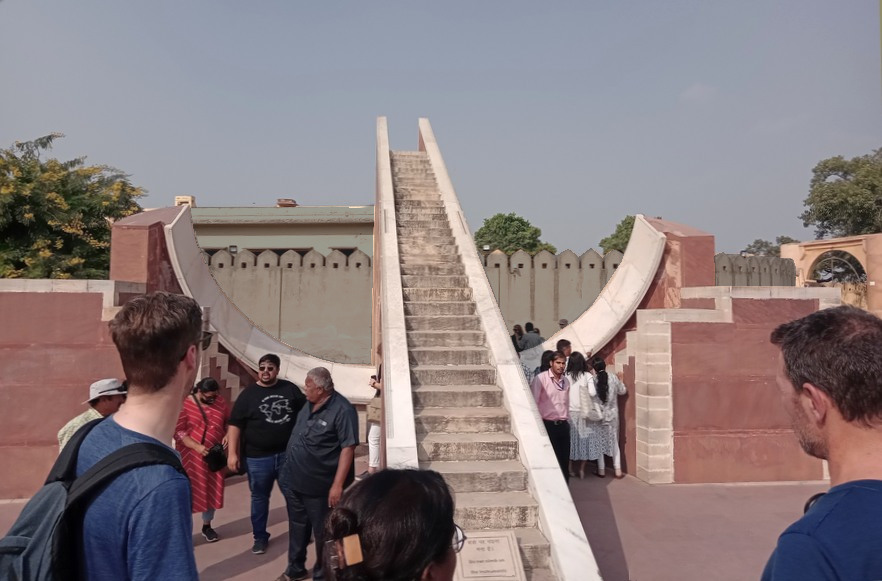
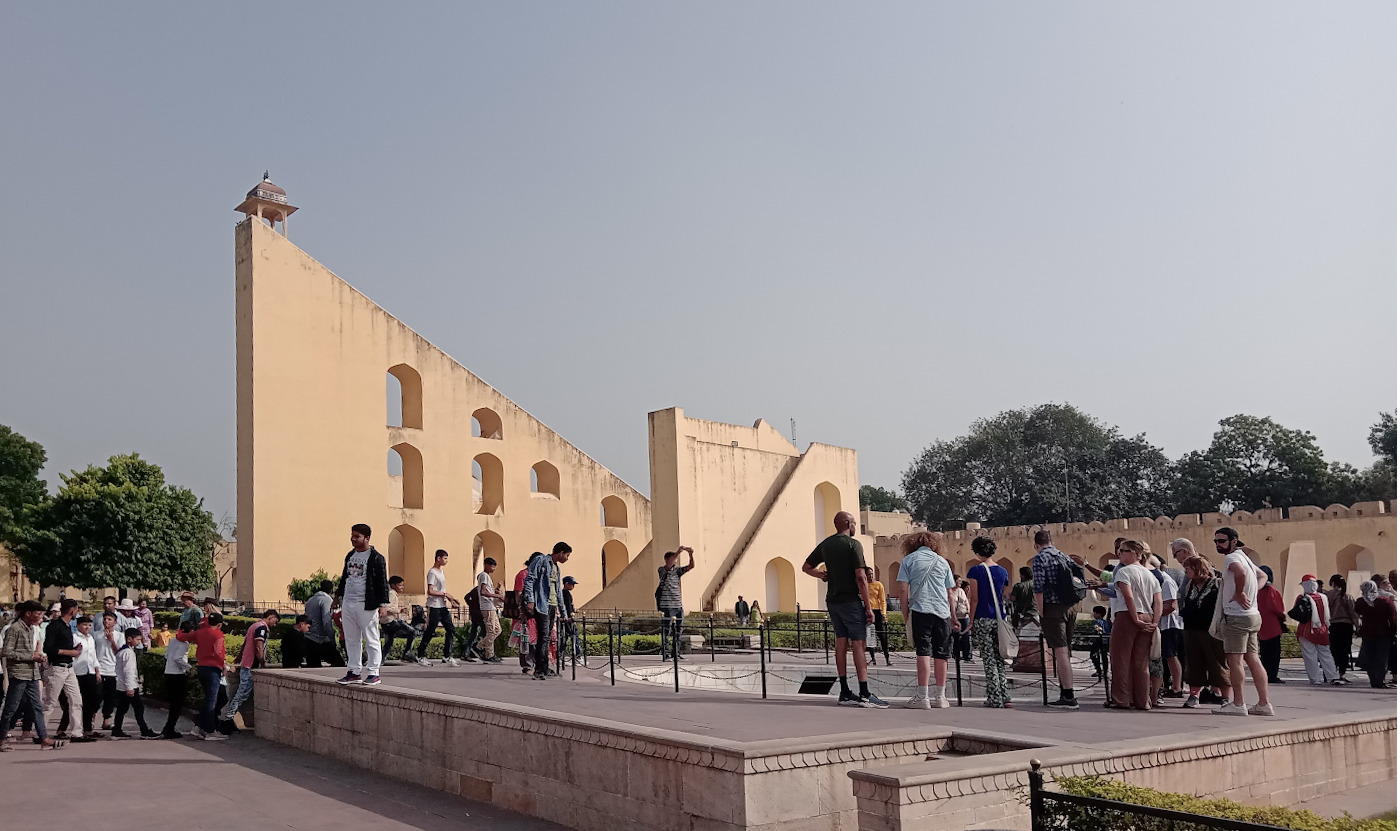
Here's a Google aerial to convey the complexity of the site...
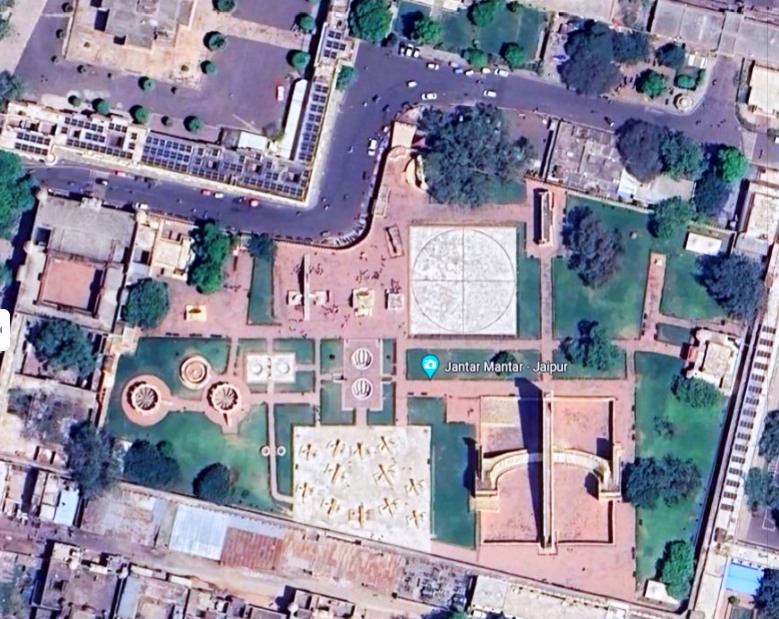
As a child, I thought of astronomy as learning about what it would be like on the surface of the moon, mars, venus.
But for most of the history of science, answering those questions was impossible. Astronomy was about the detail of what you could see in the sky. Where was the sun, the moon? Where would they be/ have been on other dates, at other times. And the same questions were asked about the tiny pin-pricks of light... planets and stars.
Many people in India set great store by astrology and horoscopes. Which means you need to know where various heavenly bodies were or will be. Hence the building of observatories.
To this day, it is not unusual for parents to play a large role in the choosing of thier children's life partners. And in many cases, an astrologer will be consulted. If the potential couple do not match on thirty two astrological parameters, their beauty, their wealth, their affection for one another will, in some cases, be moot.
(Many of the "facts" I am giving you in this come from our execellent tour director.)
DAY 7: Jaipur/Sanganer- This morning we set off at 8:30,startin our day with a visit to the Birla Mandir, a modern Hindu temple made of pure white marble that enshrines Lord Vishnu and counts as one of Jaipur’s most popular attractions.
Day 7 continued...We then went out to the suburb of Sanganer (7 miles) to watch villagers use centuries-old techniques to make things that made people's lives better...
(Journeys in the towns in our coach were always interesting... there were always things to see, and usually local people anxious to exchange a smile and a wave.) (Even the long hauls between cities were enjoyable, for the sight-seeing en route.)
(Here begins a batch of notes on specific workshops/ studios/ factories we visited that day...)
Day 7 continued... traditional block printing...
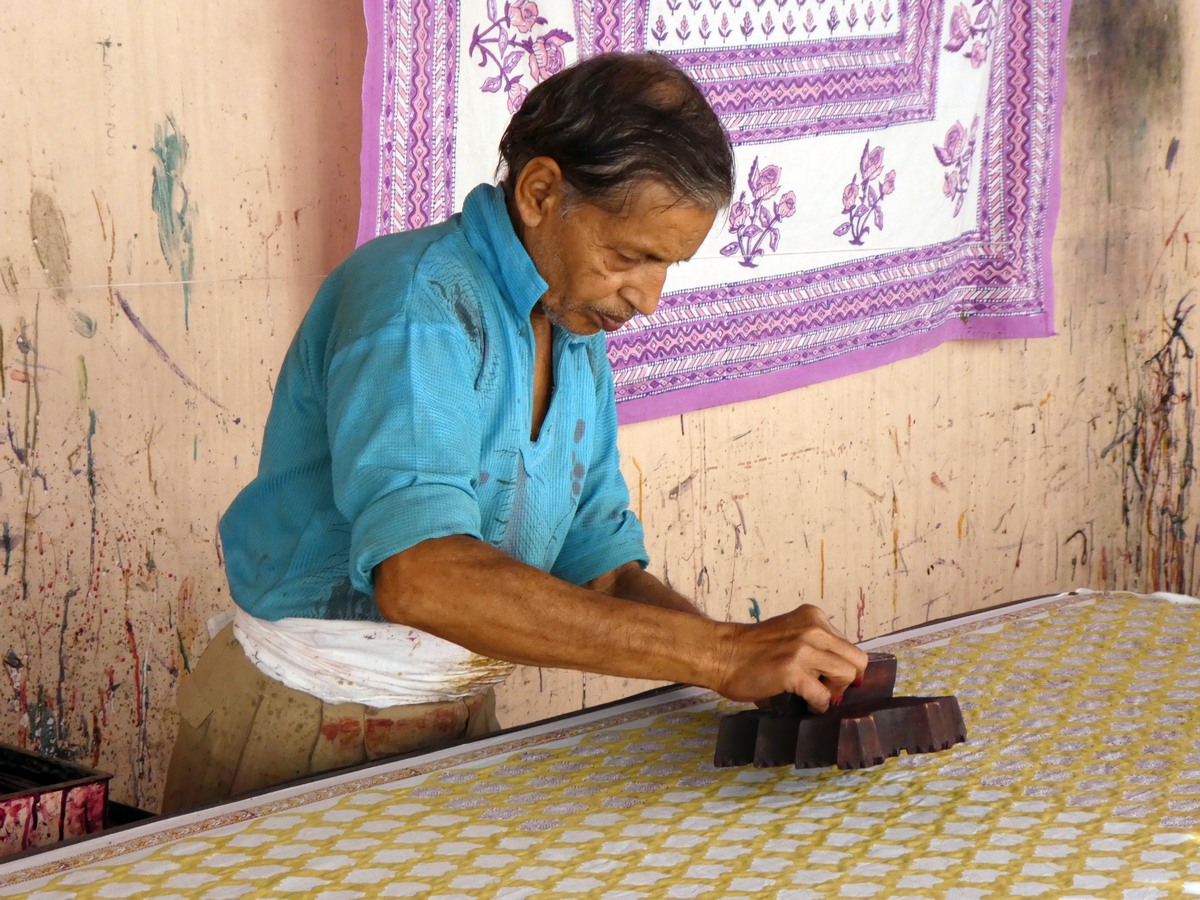
Look closely... The artisan is working from our right to our left. The sheet of fabric has already been printed with the yellow block. He is now, small bit by small bit, overprinting the yellow with a second color.
The artisan's hand must have been harmed over a lifetime of doing this? (Forensic anthropologists can tell archaeologists what trade a skeleton pursued in some cases. Archers. Blacksmiths. Metal punch operators.)
... Several colors per sheet of fabric, many sheets per day.... FOR YEARS.
Stretching across the table to reach bits in the middle of the sheet would, I suspect, also be hard on the back.
A- I deeply admire this man's fortitude.
B- I appreciate being born to an easier life.
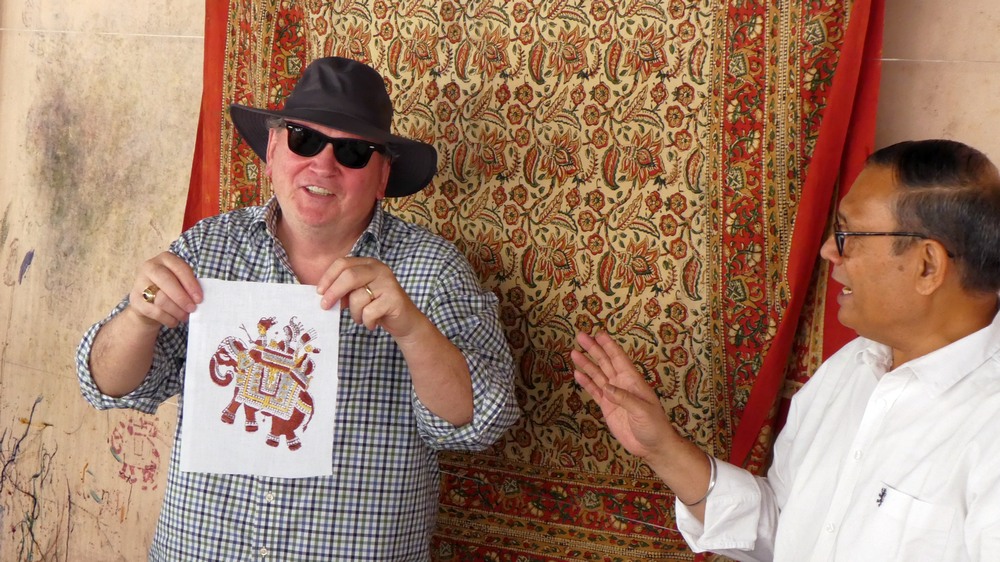
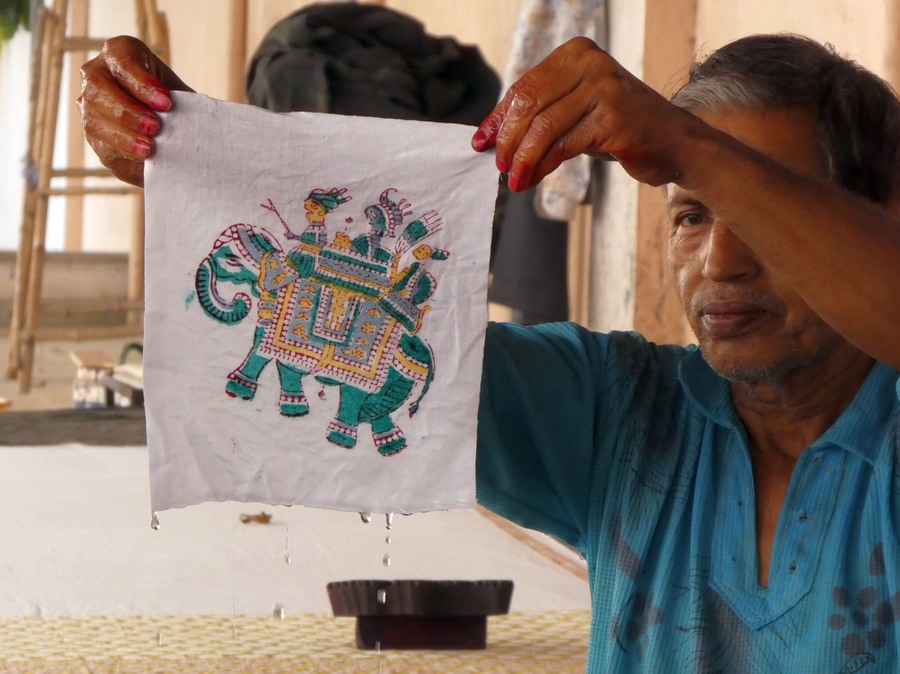
Put color on a fabric is not as easy as it seems. Even if you can find some colored chemicals to use, they must be put "into" the fabric in a way that isn't reversible. Oh, and it would be nice if they didn't fade.
In many cases, including the dyes used in the block printing, you apply something that is of one color, then wet the fabric with the right chemical, and the colored chemical is bound to the fabric.
In the course of that, the color of the bound chemical can change. Quite dramatically. We had a demonstration of the effect, as you can see above, if you look closely at the colors in the small square of fabric. Also note the finished product in the background of the left hand picture. All done with small blocks. Yikes.
Day 7 continued... handmade paper goods...
World Paper, Inc. (http://worldpaperusa.com/handmade-paper-note-cards.htm)
Day 7 continued... the distinctive blue pottery of Sanganer..., which we see the artisans paint freehand...
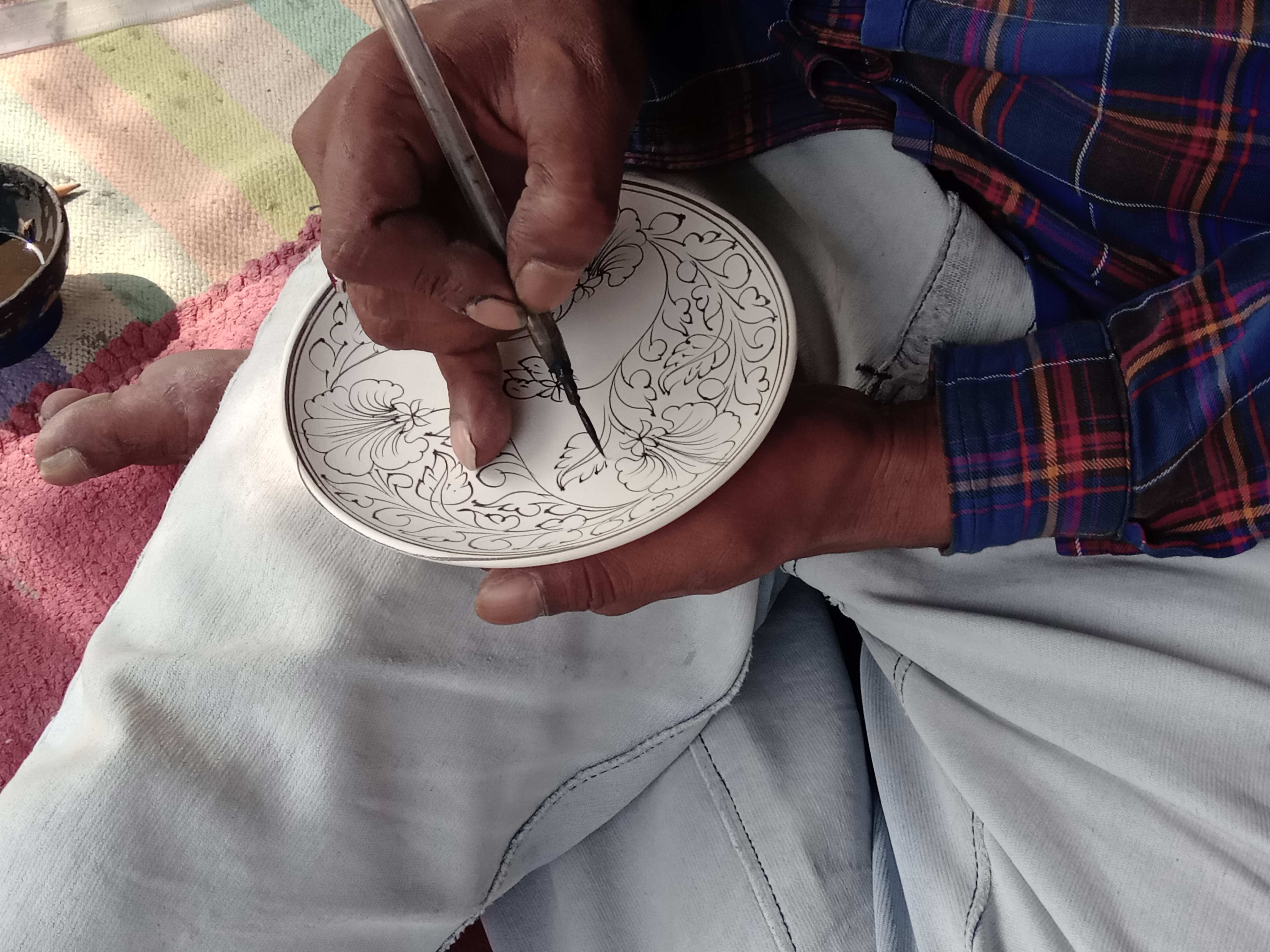
I've done pottery, and I've seen other ceramics workshops, i.e. a splendid one in Morrocco. But the Sanganer/ Jaipur blue pottery was something almost entirely new to me.
These ceramics are created from something that isn't like clays I've seen before. (Wikipedia goes so far as to say "No clay is used". (The article gives further details of what is used.) They are created, mainly, from marble dust. (It is no coincidence that the trade arose here- it is a major center for marble carving.)
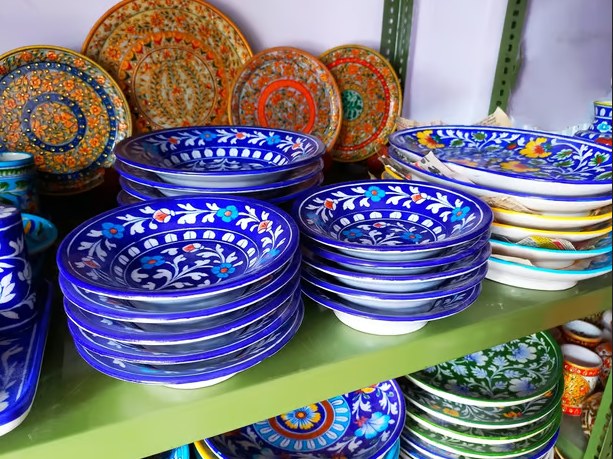
The clay is extremely craftsperson-unfriendly. It binds to itself poorly. An unfired damp saucer could easily just crumble, if not supported until it had dried. And it is still extra fragile then. Only after firing is the result hard.
This workshop was an exception to the very dolorous pattern we saw almost everywhere... middle-aged and elderly artisans following a traditional craft that has been around for many, many years, with not many changes. With no youngsters in the workshop to carry the knowledge and skills onward.
At the shop we visited, there was a very switched on young lady... daughter of the owner... who seemed able and willing to do almost any task performed by anyone, and seemed committed to carrying on. The business was also very clever in finding a wide variety of objects that could be made. This was another moment when a bunch of my photos are missing alas. The sample of blue pottery wares came from the web.
Hurrah!
Day 7 continued... and finally, carpets!...
------------------
It might seem that we had a awful lot of exposure to traditional arts and manufacture for one day... but for me at least, it wasn't a "long" day at all. Each place we visited was very different from the others. At each, the presentation of what was going on was superb.
Day 7 continued... After some time at leisure this afternoon, tonight we are dinner guests of a multigenerational Rajasthan family in their home. This provides a fascinating window on Indian life and an opportunity to witness up close the traditional society from which India is transitioning into a more urban lifestyle.
Accommodations: Jai Mahal Palace (Taj)
Meals: Breakfast, Dinner
==================================================Thursday, November 9, 2023

Arose in Jaipur, went to bed on edge of Rathambore National Park.
Once again, we set out as early as was sensible, to move to a new base of operations.
DAY 8: Jaipur/Ranthambore National Park- We leave Jaipur this morning for Ranthambore National Park.
It was a longish drive, but we were passing through interesting countryside, and had our usual pleasant stop at one of the many plazas providing food to travellers.
We left about 8:30, had a break 11:10-11:40, arrived at our lodge 13:00, and had a quick (but good!) buffet lunch there.
Bordering the outer fringes of the Thar Desert and the former hunting grounds of the Maharajah of Jaipur, Ranthambore is now a 512-square-mile nature preserve (one of India’s largest) that is home to diverse plant life, historic ruins, and hundreds of species of birds, reptiles, mammals, and, of course, Bengal tigers. Please note that road conditions in and around Ranthambore are poor; about two hours of our drive will be on bumpy or unpaved roads. Additionally, the canters (open, 20-seat vans) which we use for game drives provide minimal shock absorption; be prepared for very bumpy drives.
This afternoon, we take a game drive through the park, whose mission is to help preserve and protect the endangered Bengal tigers. We dine tonight at our lodge.
It was only a short drive... 15 minutes?... to the entrance to the tiger reserve. There was paperwork and queing between arriving and starting the game. "The doors opened" at specific times, and it paid to arrive a bit ahead of those time.
We were in the park, on our first game drive from about 14:15 to 17:30.
In the early evening we were show a short documentary about the park, and heard from, and asked questions of, an expert. As I recall, he was one of the park's senior administrators in the early days.
And then we rounded out the day with a good meal in our lodge.
Accommodations: Sawai Madhopur Lodge – IHCL SeleQtions (by Taj)
Meals: Breakfast, Lunch, Dinner
Friday, November 10, 2023
DAY 9: Ranthambore National Park- On today’s morning and afternoon game drives, we’re sure to see more game (though tiger and leopard sightings are not guaranteed).
One of India’s best known national parks, Ranthambore belongs to India’s groundbreaking Project Tiger, dedicated to preserving and protecting the once plentiful Royal Bengal tigers that roamed the land here. Now threatened by poachers, illegal logging, and encroaching civilization, India’s tiger population has decreased significantly; it is believed that just 74 tigers currently live in Ranthambore (a number that actually represents a net gain in the past decade or so).
Nationally, Project Tiger has seen the Bengal population in India rise to about 2,967 (the latest count in 2018) from the estimated 1,800 when the project launched in 1973.
The park’s varied landscape of beautiful lakes, lush grasslands, deep ravines, wooded valleys, and open scrub also features picturesque ruins of old fortifications and the thousand-year-old Ranthambore Fort, now a UNESCO World Heritage Site, which we stop to admire.
On the way back to the lodge, we visit an organization called Dhonk, which works with members of the Mogya tribe, a traditional hunting community. Here we see tiger conservation in action: families who once relied on poaching the big cats now have an alternative means of earning income through crafts and artwork. We enjoy our meals today at our lodge.
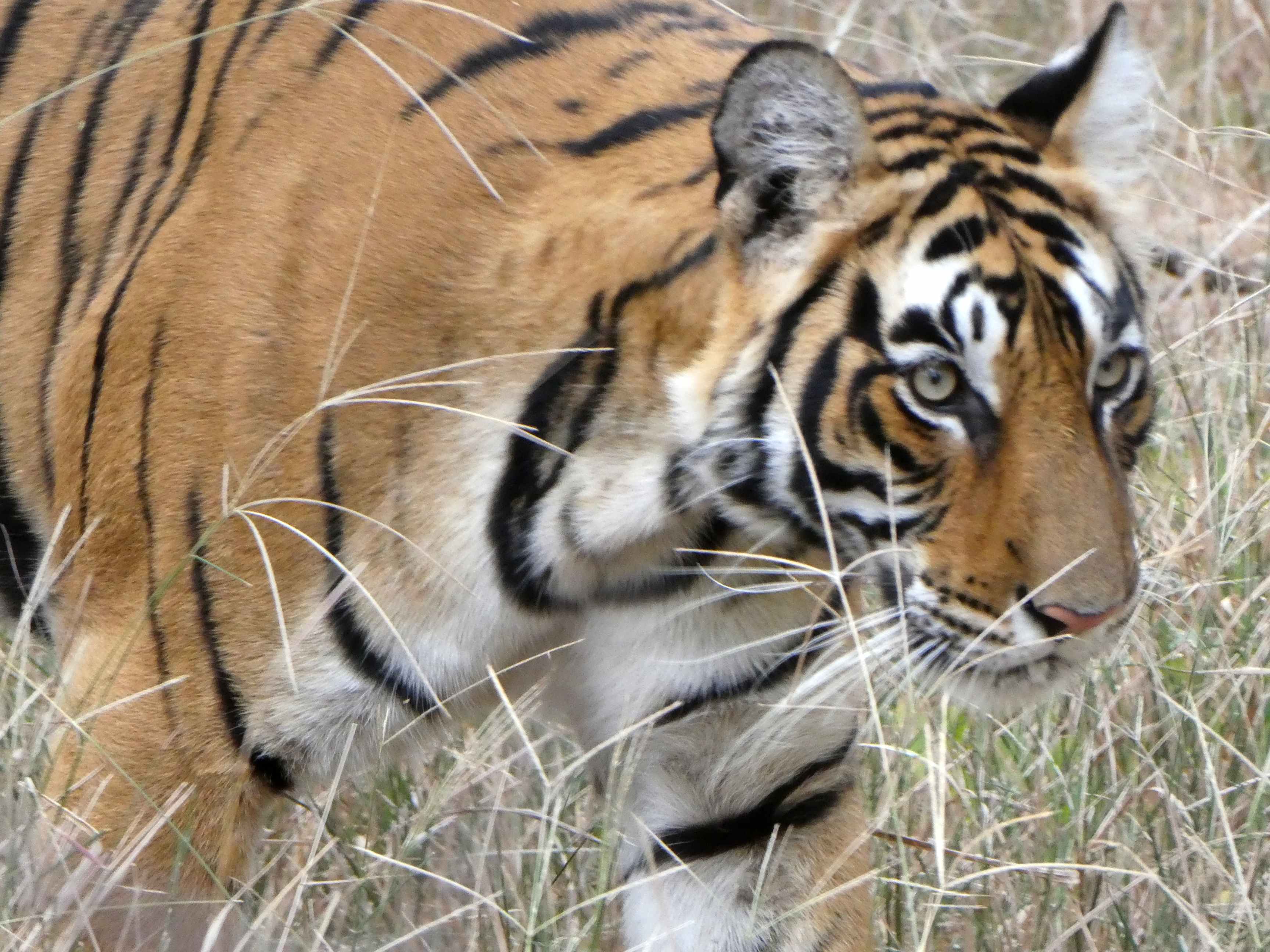
Rathambore is where tiger conservation began. It is iconic. I have seen tigers before... but I had not been to Ranthambore previously. It was special to be there.
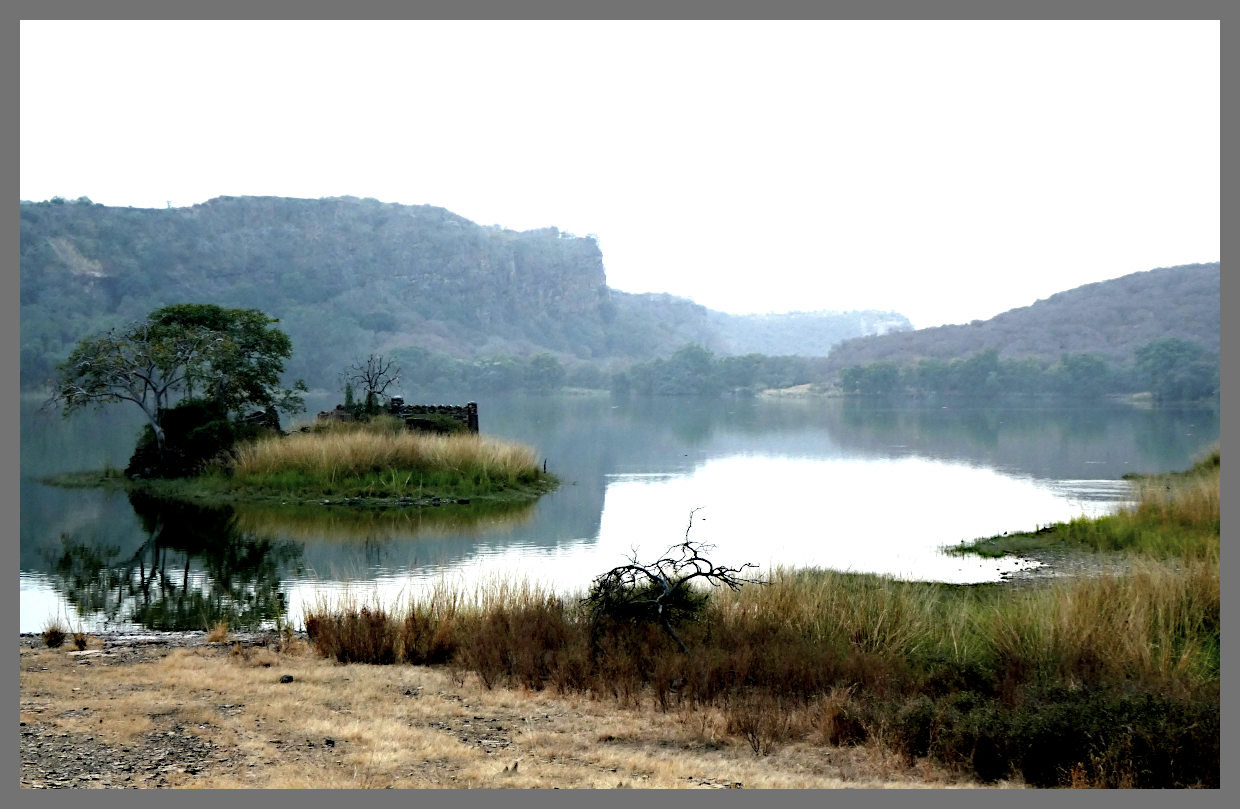
There is a major fortress up on the mesa. And various temples here and there. (I've seen numerous television programs about Rathambore and its wildlife.)
And yes, the picture of the tiger is my picture of one of the tigers we encountered. This was a young daughter of Shatti who did not as yet have a name. Infant mortality is high, and until a tiger is past the time of high mortality, they have to do with a boring number. This is "T111".
Visits to tiger preserves are not all about the tigers. And you can drive for many hours without seeing one.
But you WILL see many wonderful things along the way.
Which is better: steak or ice cream? If you've had one, would you be content to do without the other? No, me neither.
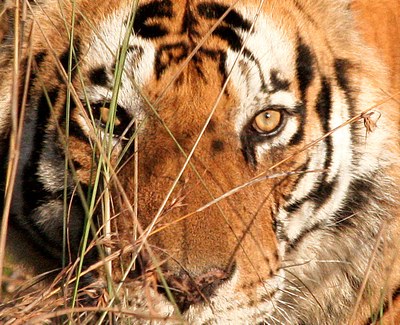
As I said, I have seen tigers before. But Rathambore was still wonderful. Would have been wonderful even if we'd seen no tigers.(A page with the full story of my other tiger encounters.)
We saw two leopards... probably a mother and a late-teenage child.
They were strolling dangerously near to where our guide had... correctly... decided that a tiger was snoozing away the day. This was in Arrowhead's territory, and she has three cubs. We didn't see the cubs, but after a long wait... which was enjoyable, if you could take a laid back attitude, we saw bits of an adult... tips of wars, top of head, before we had to go because we were pushing the limit of the time the guides are allowed to have visitors in the park. It was a fairly... energetic?.. drive to get to the gate in time.
Anyway, returning to the leopards: Happily, they realized their mistakes and decided to change course.
Karma: We only saw them because our driver moved our vehicle to make things easier for another party's vehicle!
Tigers pretty well do what they like. Including making the tourists wait a LONG time for the boon of a glipse of their glorious selves, after they've finished their snooze, thank you.
Leopards are much more vulnerable. They have to stay clear of tigers, and so they are not so easily seen.
I think our excellent, experienced local, tiger park guide got more pleasure from the rare good view of some leopards than from the limited glimpse we eventually got of that tiger! (We had a splendid encounger with "T111"... though a very good friend, also viewing tigers in India recently, with Tropical Ice, hit the jackpot... a mother playing with two mature cubs. But she was on a tiger-oriented tour, and put in many hard hours to earn that treat.) She has a very clear web page... with video clips... explaining the details of what going into the tiger parks is like. (I took the Tropical Ice Tour myself a few years ago... she left out the fact that they take the edge off of the very early morning starts with hot water bottles... which were very welcome in the chilly early hours!).
In her page, you see a "traffic jam" of vehicles. Yes... they do happen when a stationary tiger had been known to the guides for a little while... but that is NOT the usual nature of the experience. Normally, you rarely see another vehicle.
Our tour director... a man with many trips to Rathambore and others under his belt had never seen leopards before. I was very pleased for him. And it was a "good" encounter... not just a glimpse of one disappearing over a hill two miles away.
While to me it is worth every minute, tigers or no tigers, it has to be admitted that trying to see tigers involves many hours of bumping along rough tracks in indelicate vehicles... but through wonderful landscapes!
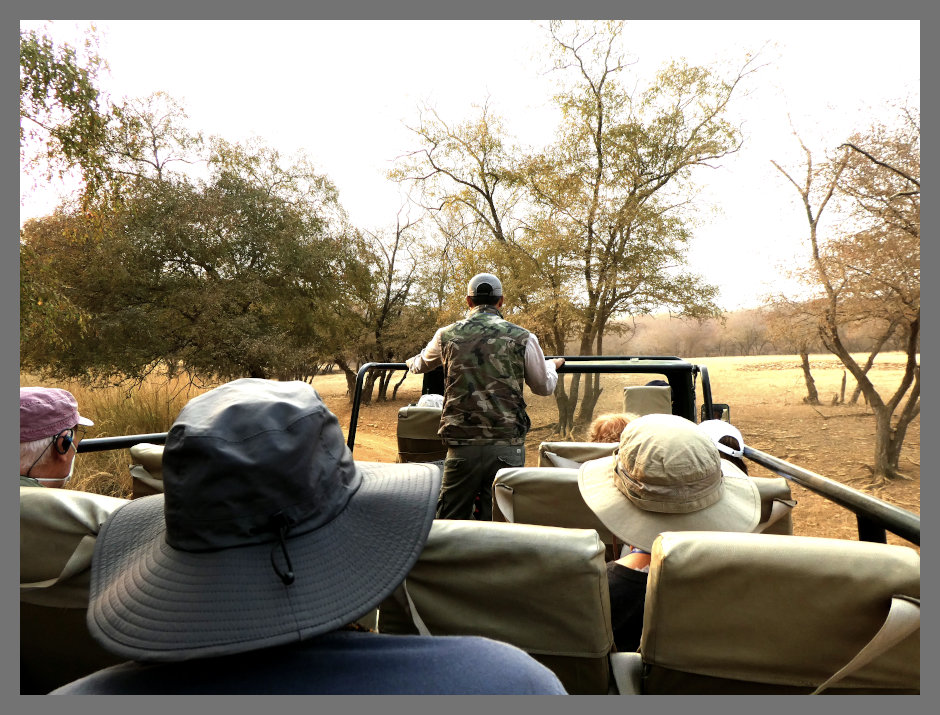
Accommodations: Sawai Madhopur Lodge – IHCL SeleQtions (by Taj)
Meals: Breakfast, Lunch, Dinner
================Saturday, November 11, 2023

Arose next to Rathambore National Park, went to bed at Clement Retreats "Dera Village", near Gadoli.
Another "relocate" day, but the drive wasn't as long as some.
DAY 10: Ranthambore/Gadoli- This morning we embark on the five-hour drive to the Dera Village Retreat, at Gadoli.
.
Day 10 continued... En route to the retreat, we visit the village of Abhaneri to witness an architectural marvel: the Chand Baori step well. To overcome the perpetual issue of water scarcity during summer months, inhabitants of northern India began constructing unique step wells in the 6th century CE to collect this necessary resource. An estimated 3,000 of these baori once gave villagers multiple routes of access to the pools of water below and provided a gathering place with respite from the heat. The 9th-century ruler King Chand built this astounding structure – one of India’s largest and most visually arresting – with 3,500 symmetrical steps on three of its sides, each descending 13 stories into the 100-foot-deep well. Ruins of an elaborately sculpted temple dedicated to Harshat Mata, Goddess of Joy and Happiness, stand opposite the step well.
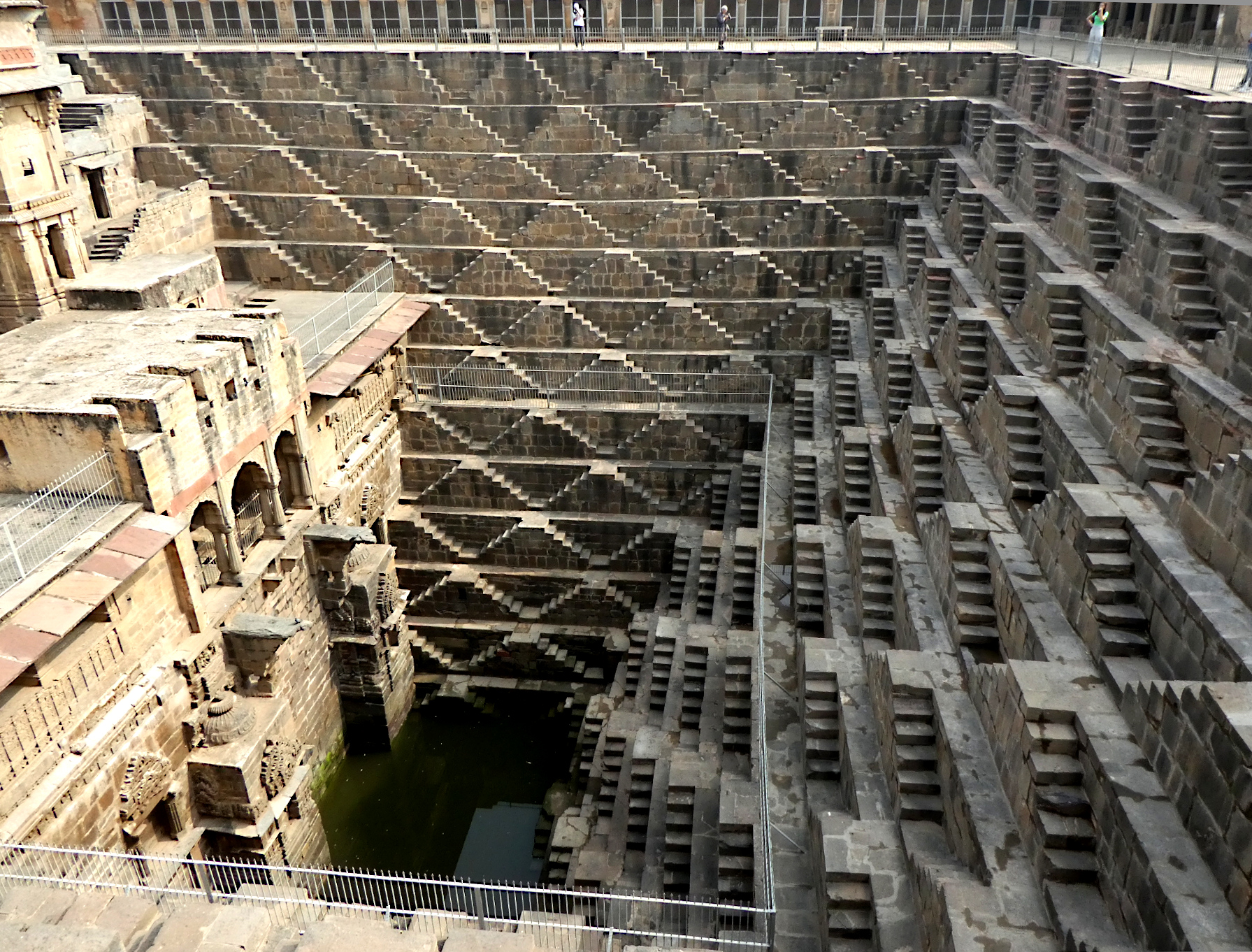
Impressed? Just before you answer, tell me- did you notice the people in the image? If not, do you want to change your previous answer?
Day 10 continued... After visiting this marvelous site (whose dramatic setup has attracted directors to shoot scenes for films such as The Fall and The Dark Knight Rises), we continue on to Dera Village Retreat.
The resort is a self-contained compound in the middle of a vast flat agricultural area with very sparse population.
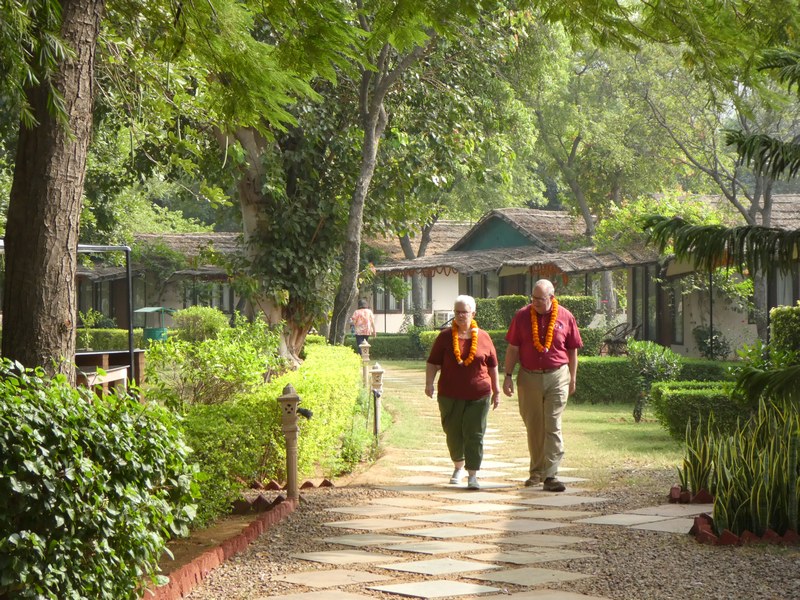
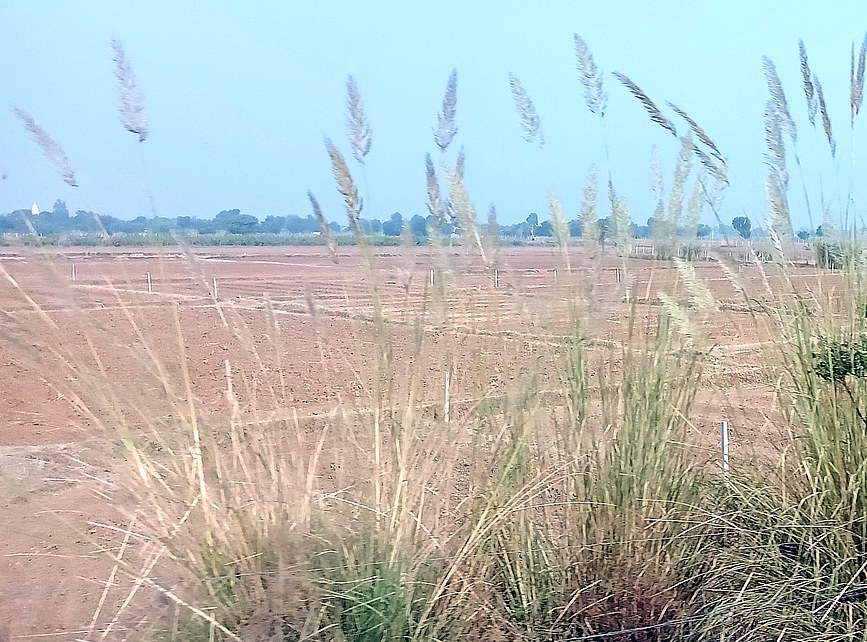
Day 10 continued... After lunch at the retreat, we set out on a camel safari (on camel cart) through the surrounding villages to visit their school, and meet the local Meena tribespeople who live in mud huts that they decorate inside with floral and animal designs. Largely an agricultural people, the Meena have maintained much of their traditional culture and customs, as we see for ourselves up close.
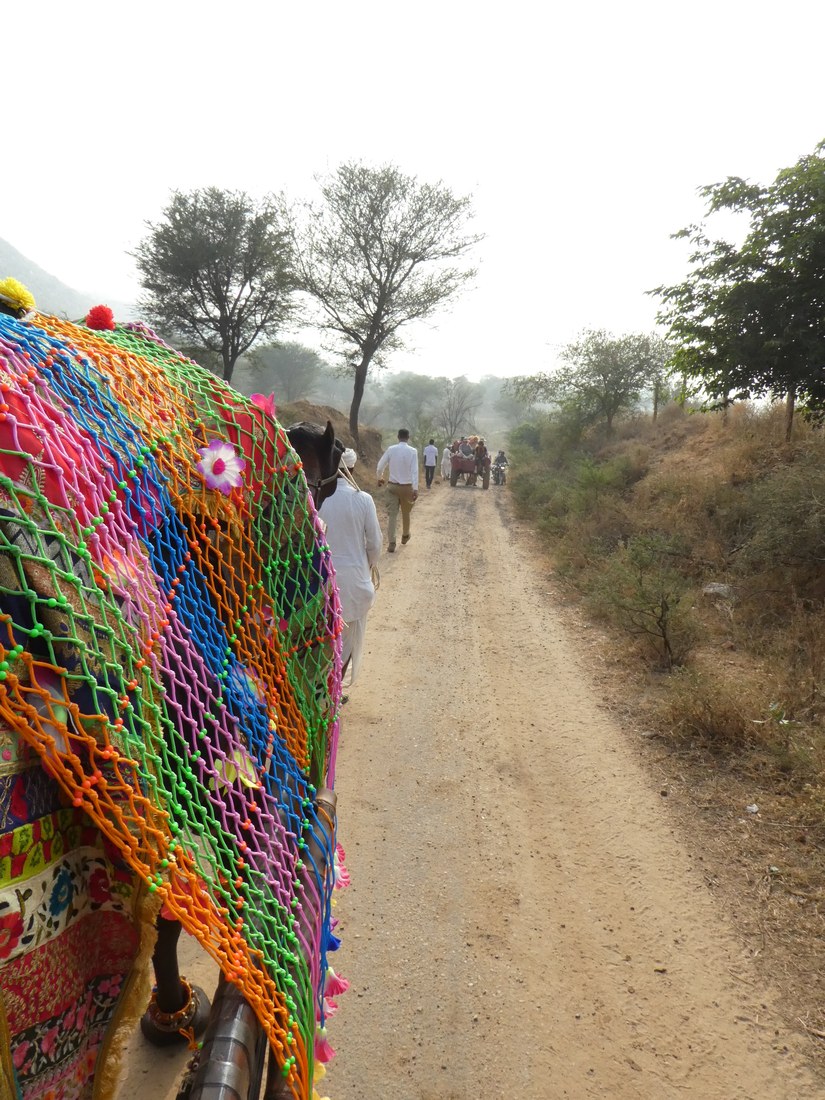
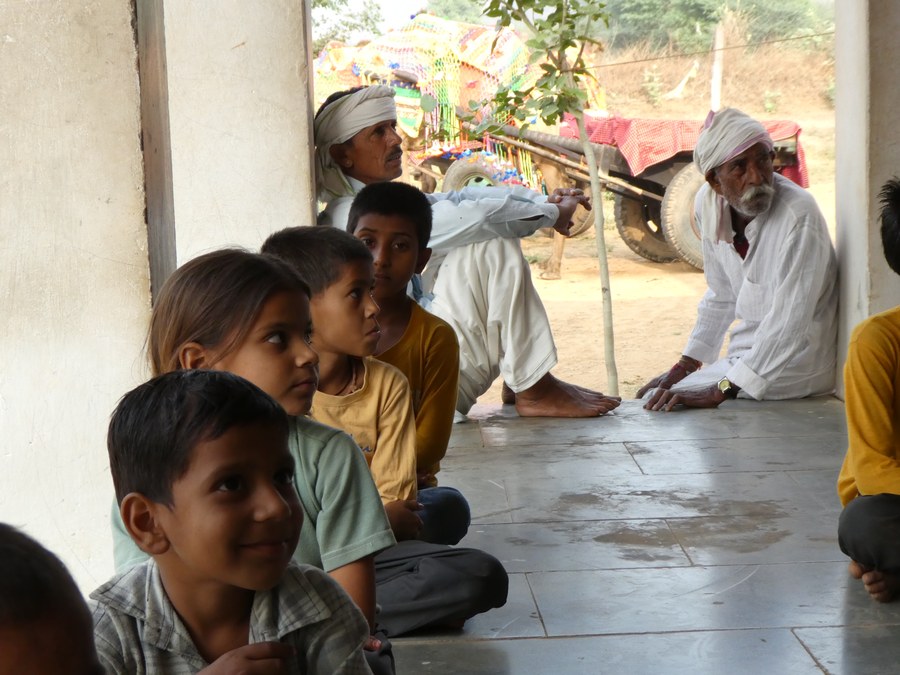
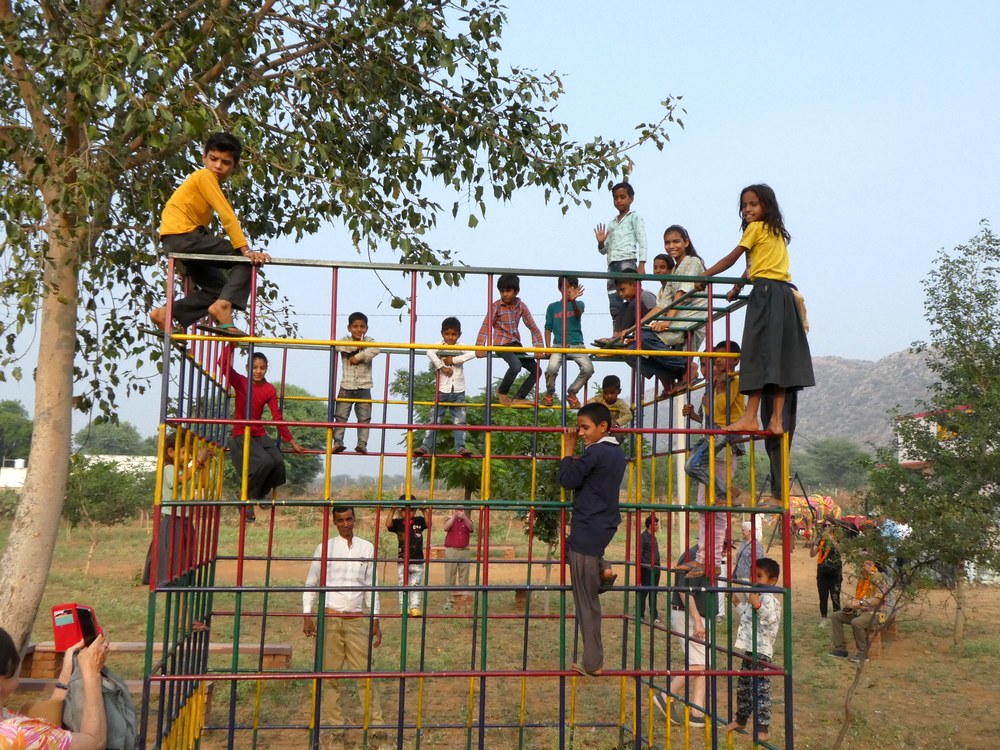
The school was in the midst of its Devali holiday... but they agreed to come along, show us what lessons were like, which was WELL beyond the call of duty, seemed to me! After the "formal" proceedings, I suggested the kids pose on the climbing frame, in the hopes of seeing some less formal behaviour.
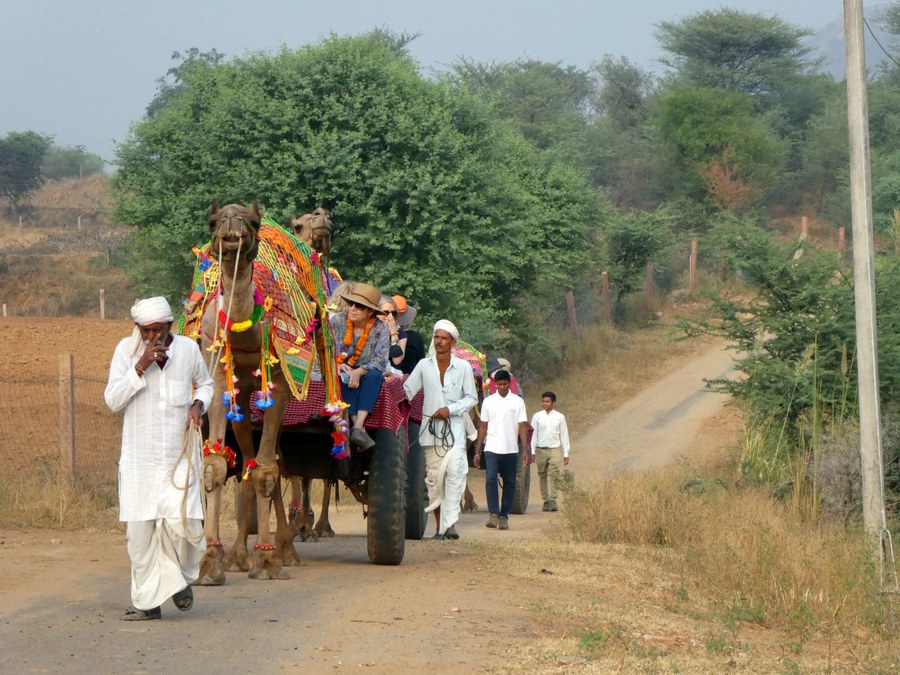
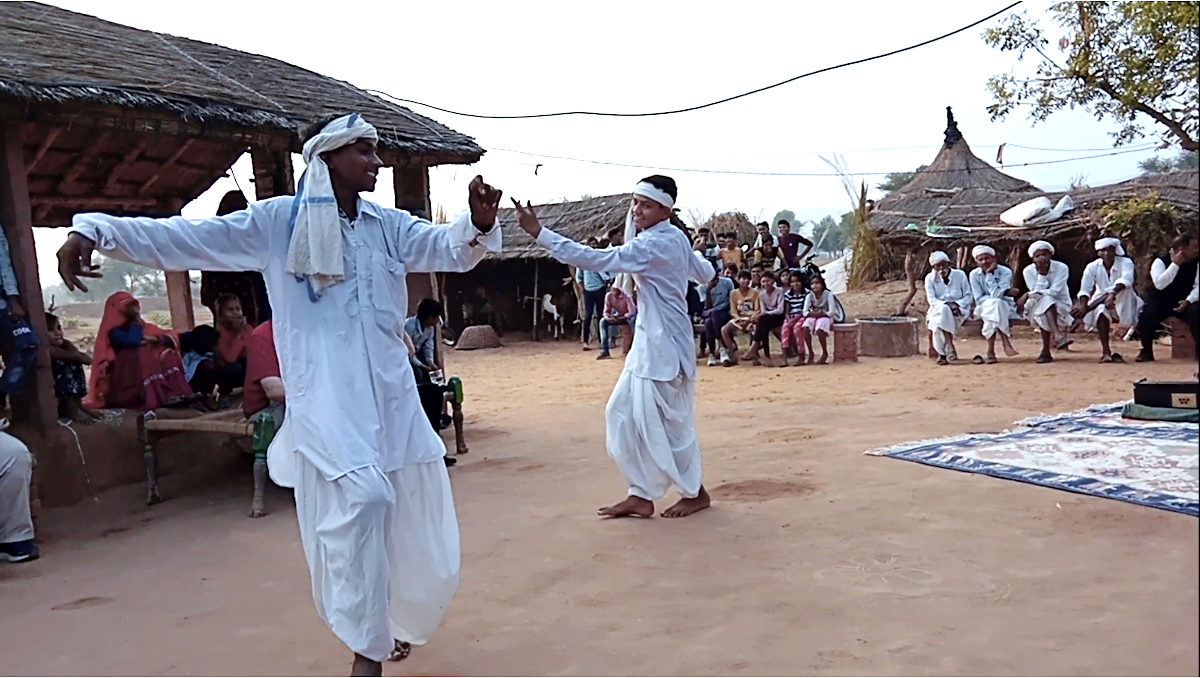
After our visit to the school, we got back on the carts pulled by the camels... more usually used to haul the harvest from the fields, I presume, and traveled a bit further, until we came to a... homestead? (An isolated collection of buildings housing, I suspect, mostly just one extended family.)
A "party" was being thrown. Partly Devali festivities. Partly just neighbors having a good time. Partly a mock "wedding feast", to entertain us. Two young lads danced as "bride and groom". One was a natural... very graceful, very in tune with the music. The other did a magnificent job of doing his best, but he clearly just didn't have the natural born "feel" for the rhythms... and he had been cast as the bride, and some of his friends were highly amused by the fact. He did a great job; I admired his willingness to have a go.
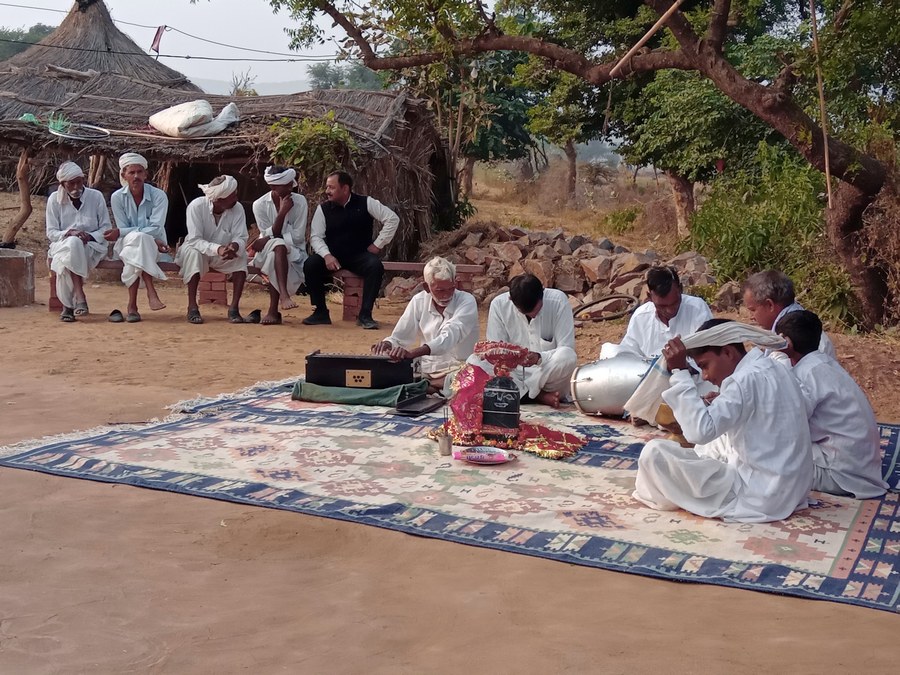
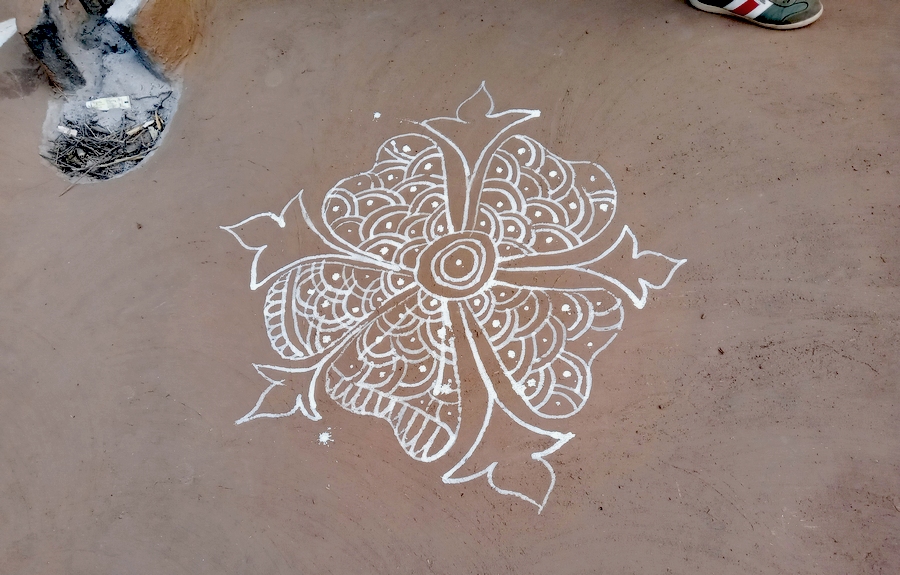
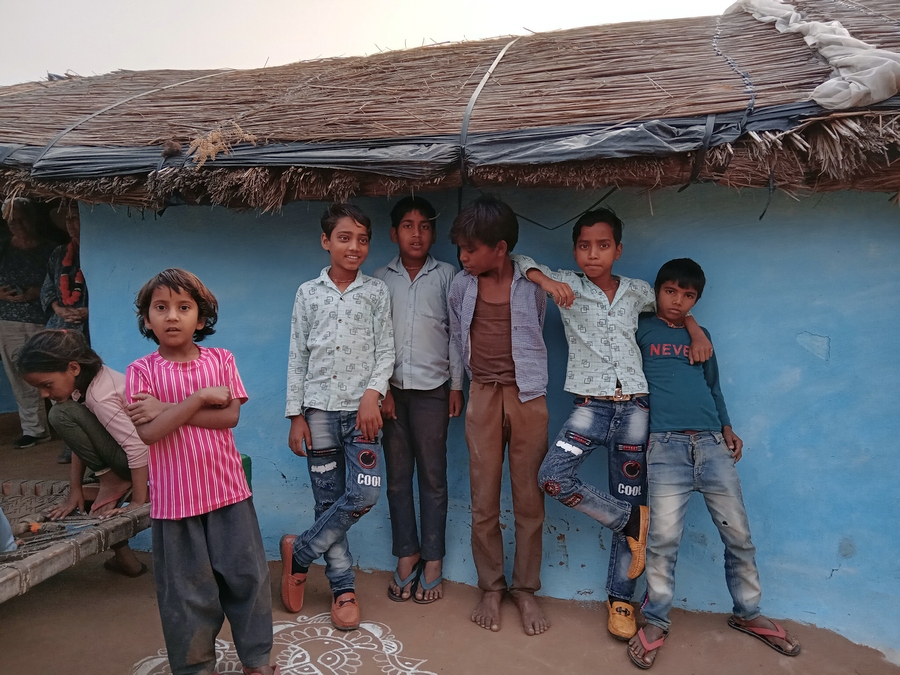

Day 10 continued... Late this afternoon we return to our lodging, where tonight we enjoy dinner accompanied by a local folk dance performance.
The standard of the music, the dance, and the way they were made an entertainment were all first class. I believe I heard that they had driven two hours to do the show for us. There was even... are you ready for this?... compulsory audience participation! And earlier in the day I'd played a little cricket, as well.
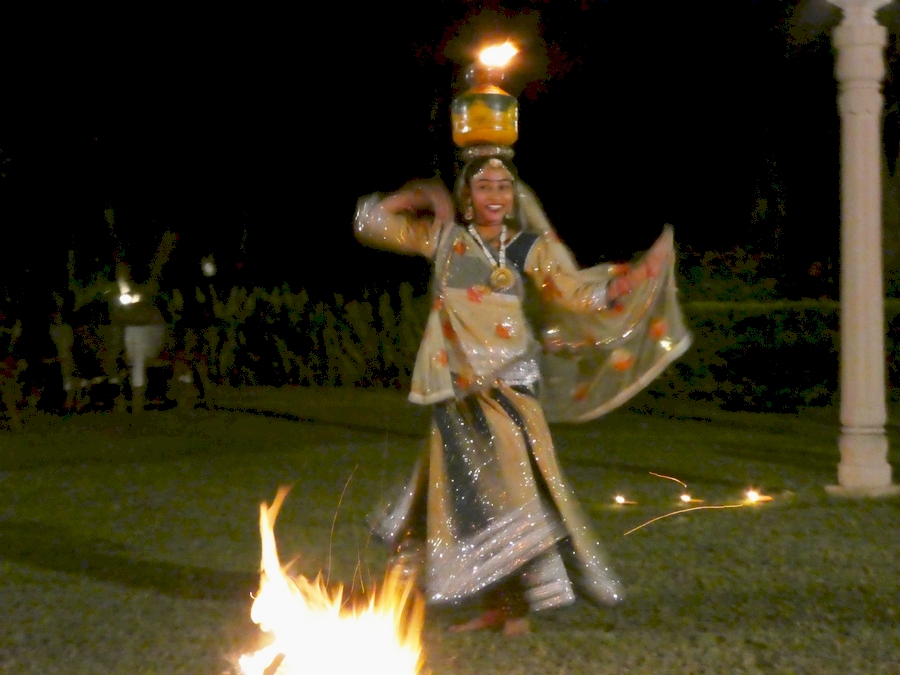
___________________
A group of jackals passed through the compound about 2am. (They are no threat to humans. Think small coyotes. Very useful scavengers. One of nature's garbage collectors.)
Accommodations: Dera Village – The Clement Retreats
Meals: Breakfast, Lunch, Dinner
=======================Sunday, November 12, 2023

Arose in Dera Village, went to bed in Agra.
We had another "relocate" day soon after the previous one, and I was tempted to put both portions of the trip on one page... but given how "big" the "brief" stops were, I have continued my practice of starting a new page for each overnight home.
DAY 11: Gadoli/Agra- Leaving Gadoli this morning we travel to Agra. After lunch on our own, we proceed to I'timād-ud-Daulah, often called the “Baby Taj,” the two-story marble mausoleum that inspired the Taj Mahal
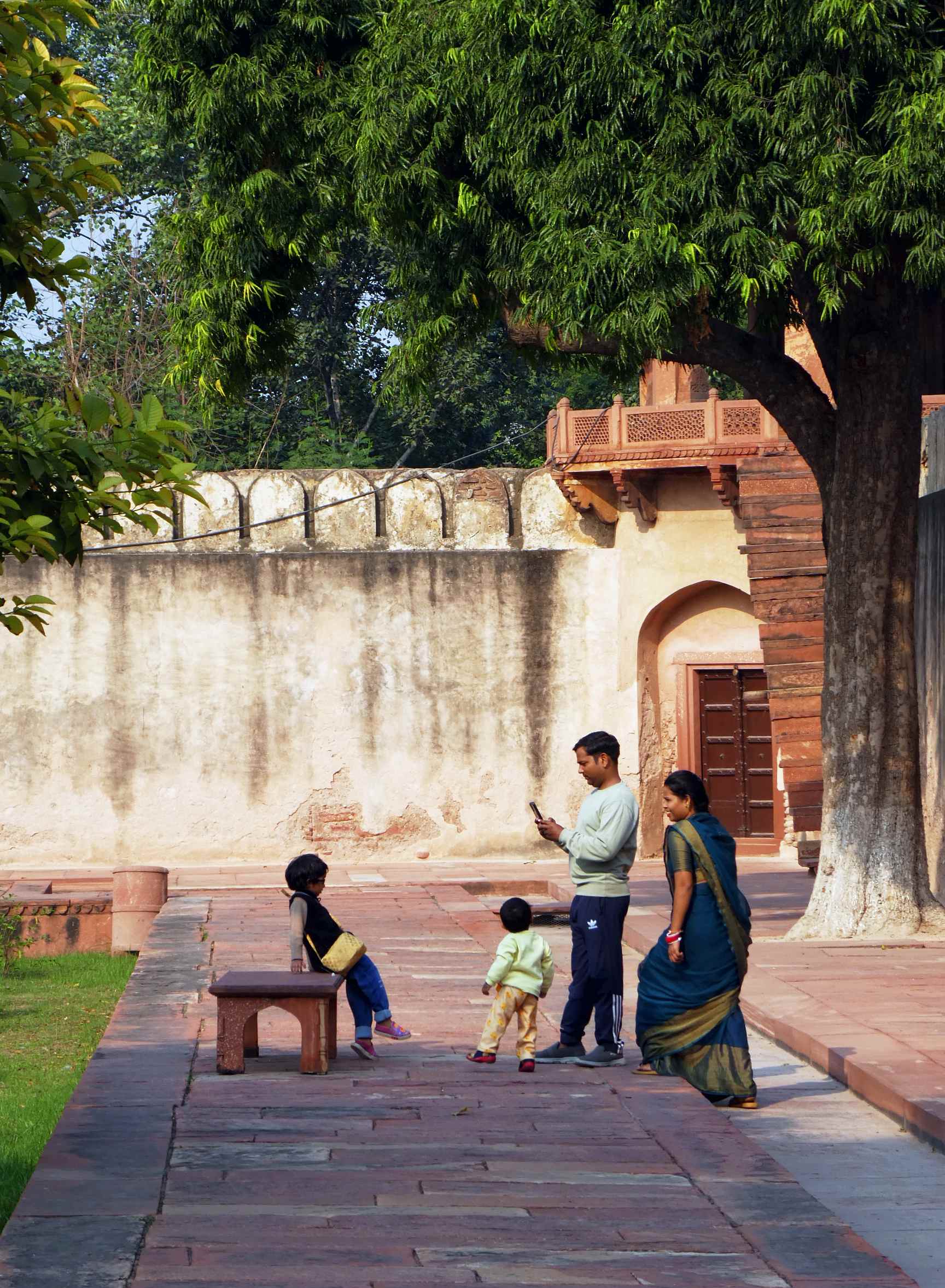
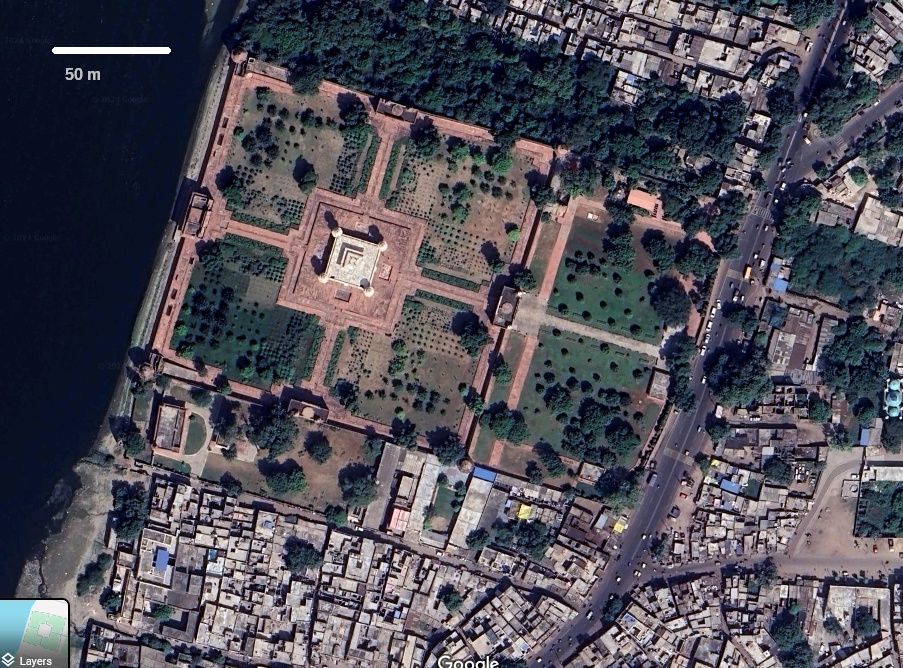
The family moment in the photo was in the grounds of the tomb of I'timād-ud-Daulah, which is a little way upstream from Taj Mahal, around a big bend in the river, on the opposite bank of the Yamuna.
The Yamuna is the second-largest tributary of the Ganges by discharge. Like the Ganges, the river is a goddess. (Of course!). Delhi is 100 miles NNE of Agra.)
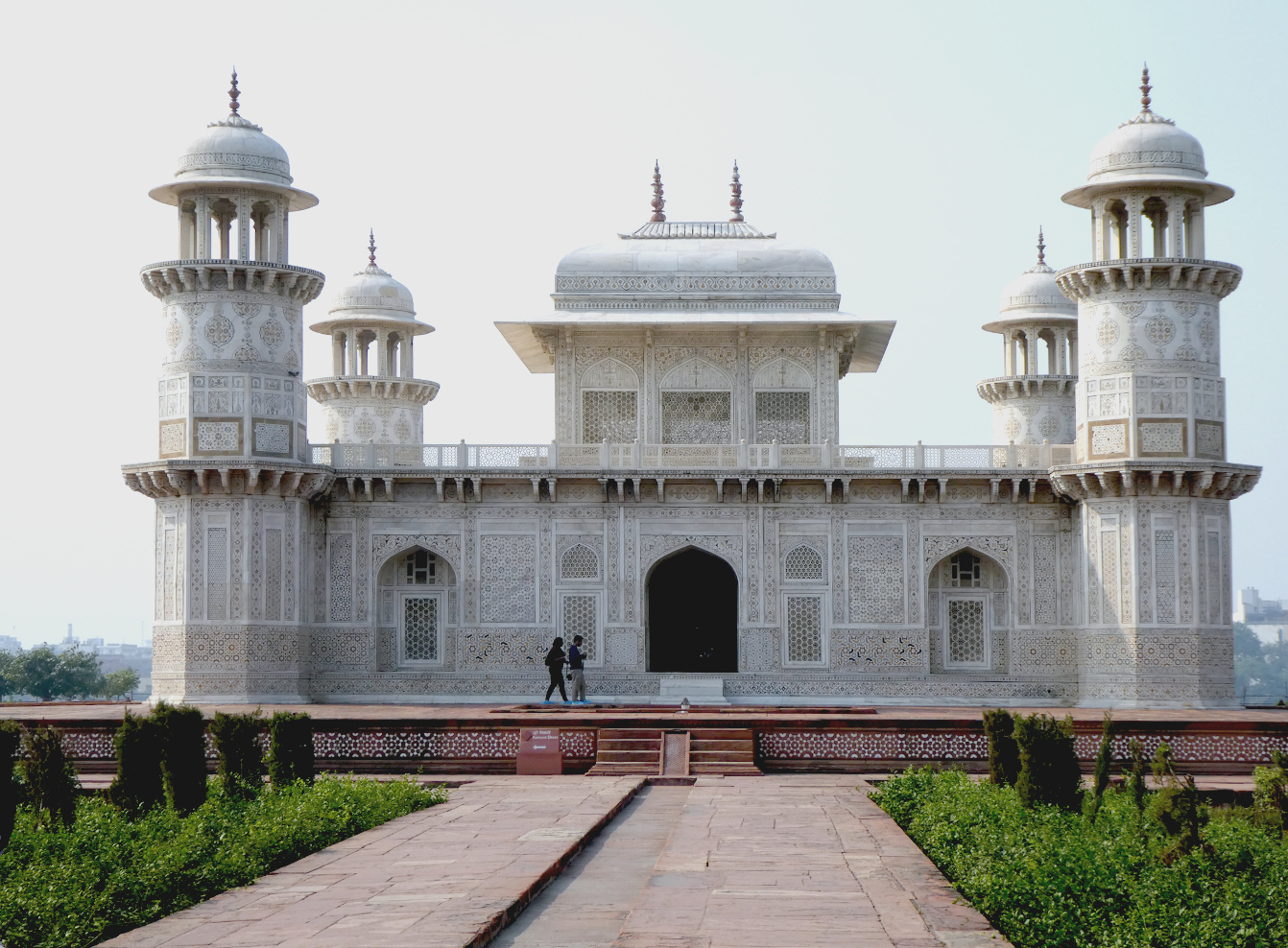
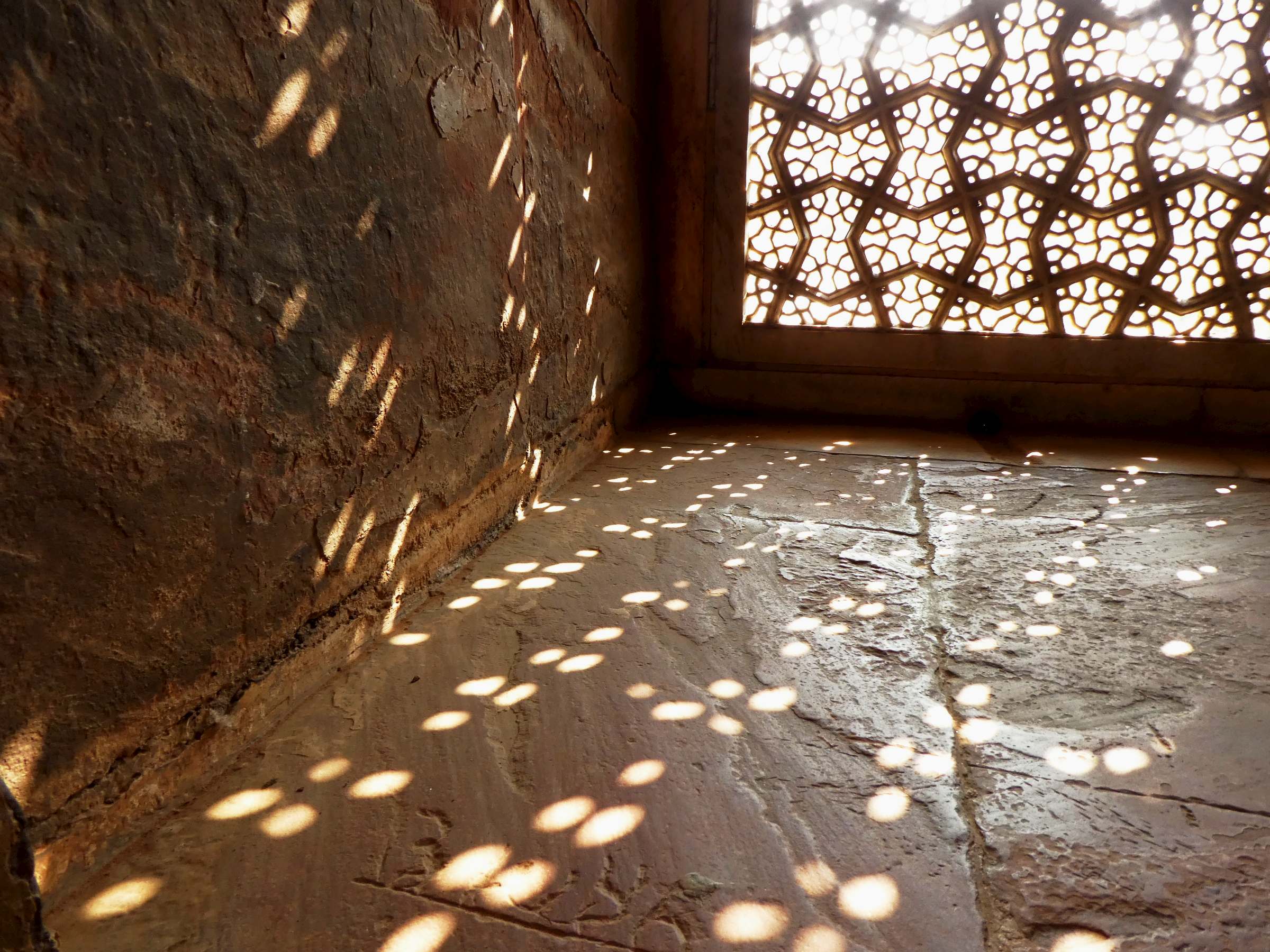
This latticework grill was carved from marble, I think. Maybe limestone. Each small opening is about 2.5 cm / 1 inch across. And there were square meters/ yards of this building material. (Similar wonders were also present in The Taj.)
Following our stop at the Itimad-ud-Daulah, we get a preview of tomorrow’s excitement as we view the Taj Mahal from Mehtab Bagh, an idyllic garden complex located directly across the Yamuna River, opposite the fabled mausoleum. Tonight, we dine together at our hotel.
Accommodations: Courtyard by Marriott Agra
Meals: Breakfast, Dinner
Monday, November 13, 2023
DAY 12: Agra- This morning we savor a travel highlight as we embark on a tour of the Taj Mahal, the magnificent tomb of white marble built by Emperor Shah Jahan in memory of his beloved wife Mumtaz, who had implored her husband to build a monument symbolizing their undying love for each other.
Some 20,000 laborers and artisans from around the world spent 22 years constructing what became Mumtaz’s mausoleum, which was begun in 1632. Along with its exquisite symmetry, the Taj features striking examples of pietra dura, a decorative art in which craftsmen embed precisely cut semi-precious stones in marble to form dazzling patterns.
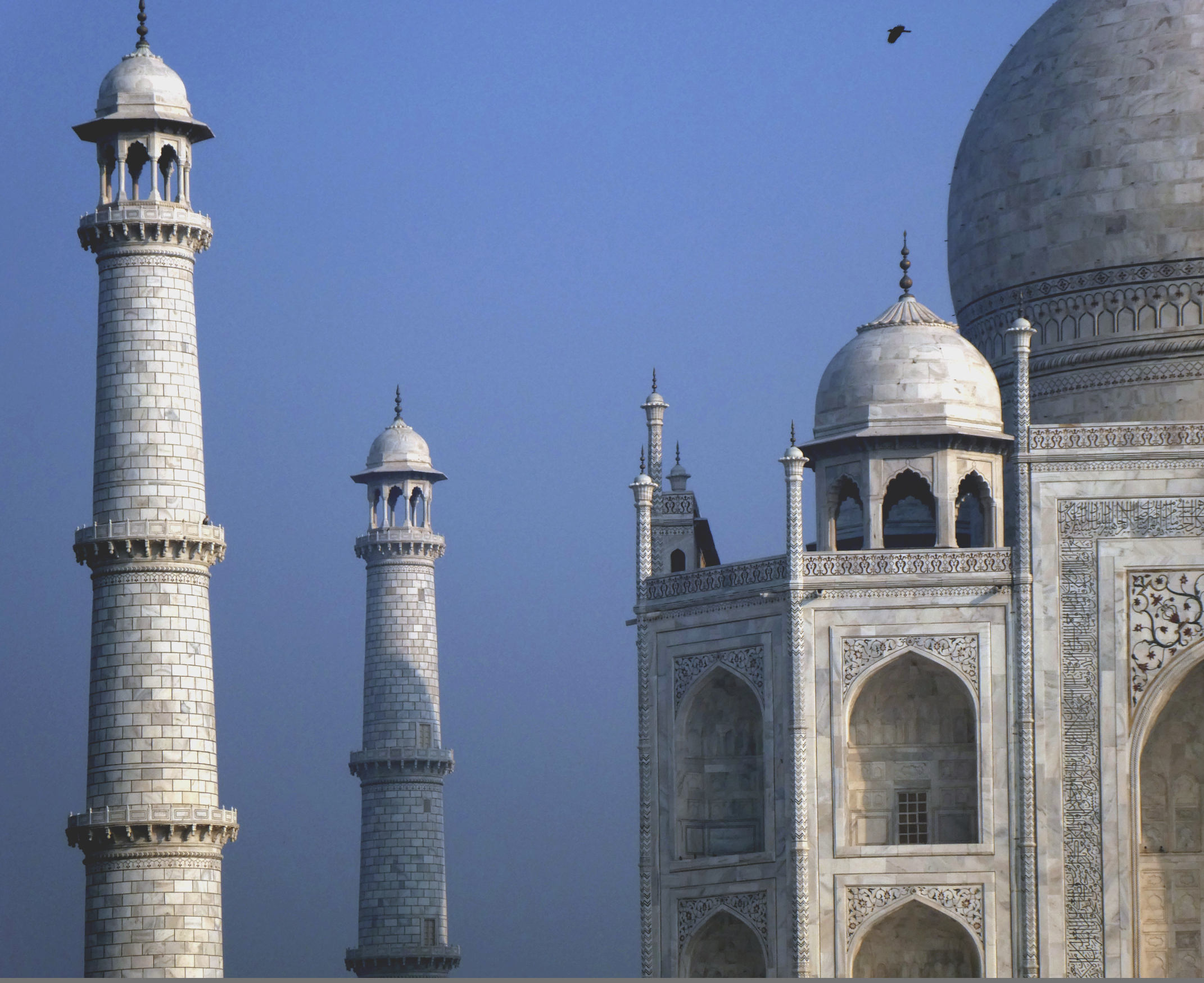
Day 12 continued... Next, we visit the imposing Red Fort of Agra, comprising fairytale palaces, two beautiful mosques, audience halls, pavilions, courtyards, and gardens, all surrounded by a massive wall, a moat, and yet another wall. Our tour here features the Hall of Public Audience and the Royal Pavilions. An architectural and strategic masterpiece, the Fort is protected as a UNESCO World Heritage Site.
In a cruel twist, Emperor Shah Jahan, builder of the Taj Mahal and whose grandfather built the original Agra Fort, was imprisoned here at the end of his life by his own son – in a room looking out on the Taj Mahal down the river
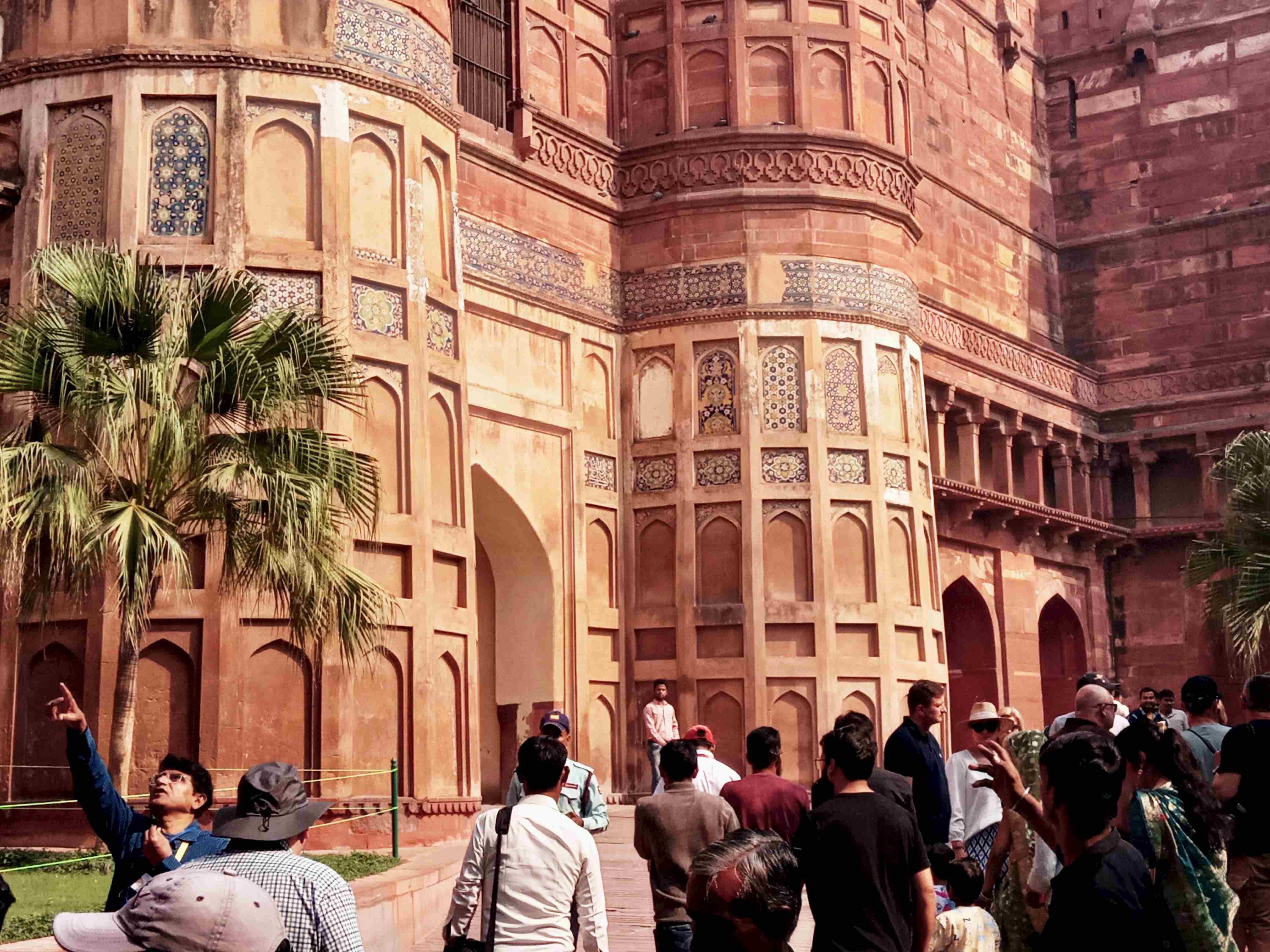
Day 12 continued... We return to our hotel following our visit to the Red Fort, then savor a highlight of another sort: an Indian cuisine cooking lesson from locals along with lunch together in their home.
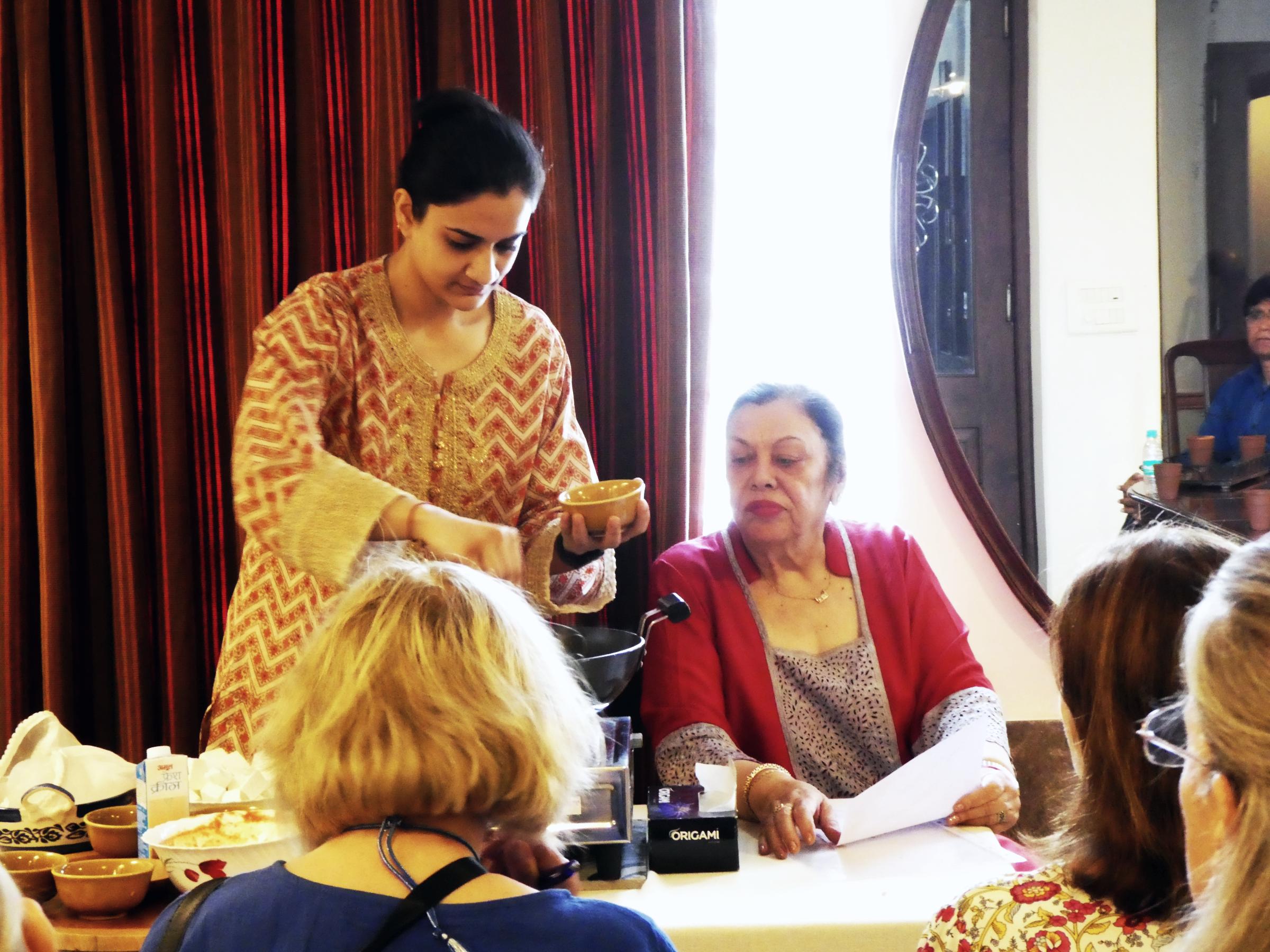
The demonstration was done by a daughter-in-law, under the watchful eye of the household's matriarch. These formidible ladies are not to be trifled with. Often very nice... but they run tight ships. And they are accoustomed to unquestioning instant obedience.
We then visited a workshop creating breath-taking pietra dura. (Extensive images to come.). I wanted to bring the following home with me so badly... but in spite of the extraordianarily low rate of pay received by the craftsmen, multiplied by the hours to make this box, even at 2p per hour, it just wasn't going to be, alas...
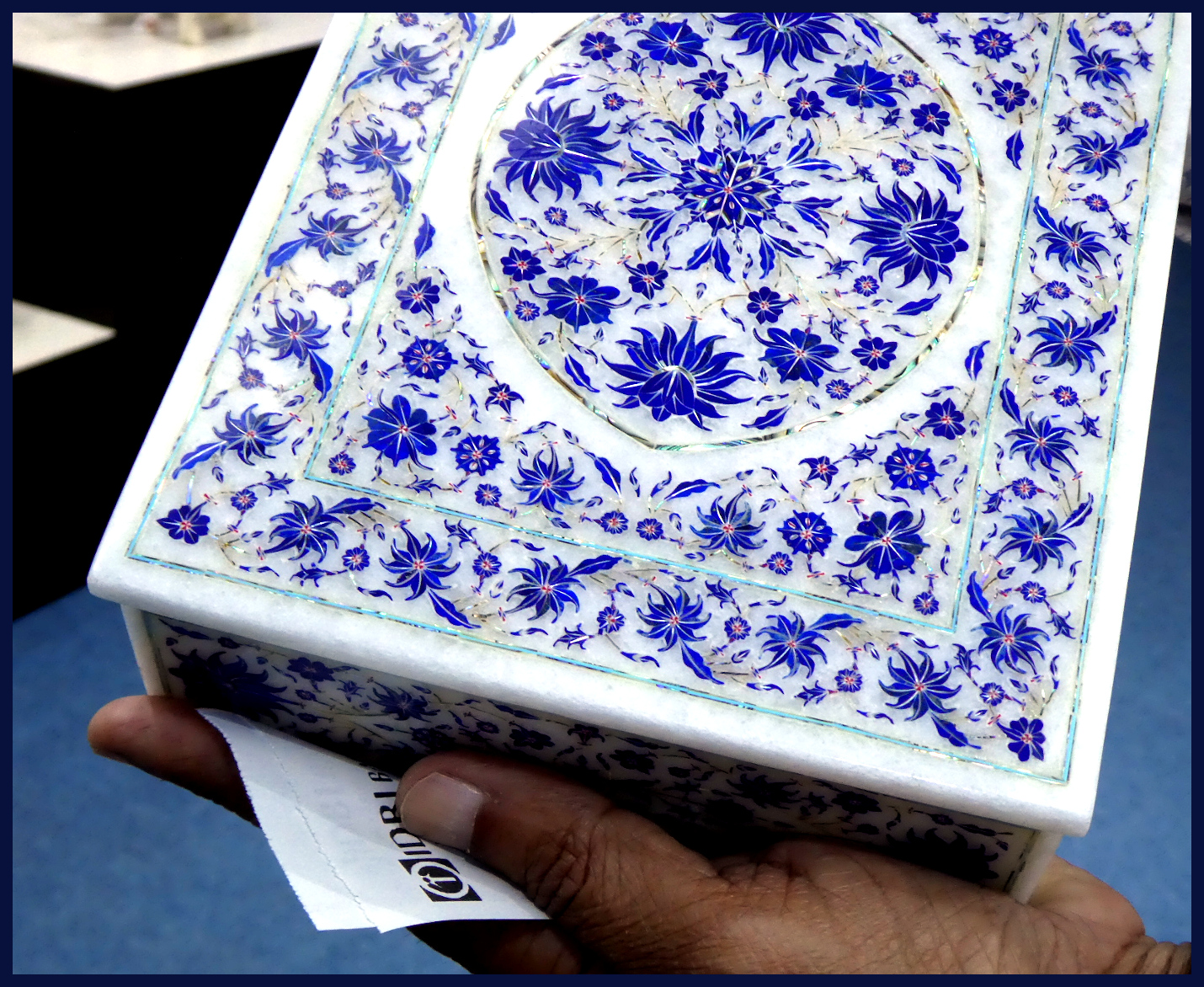
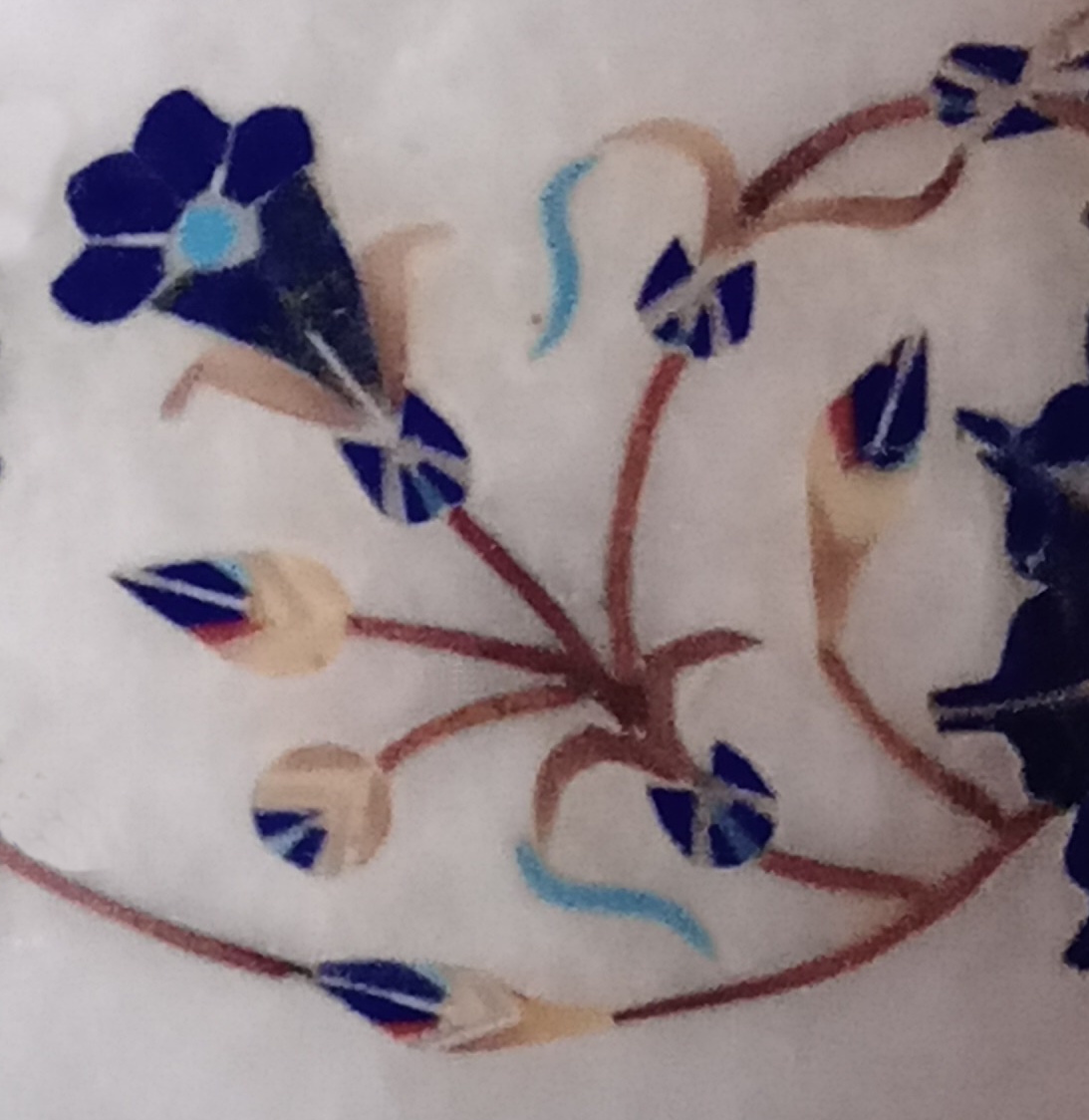
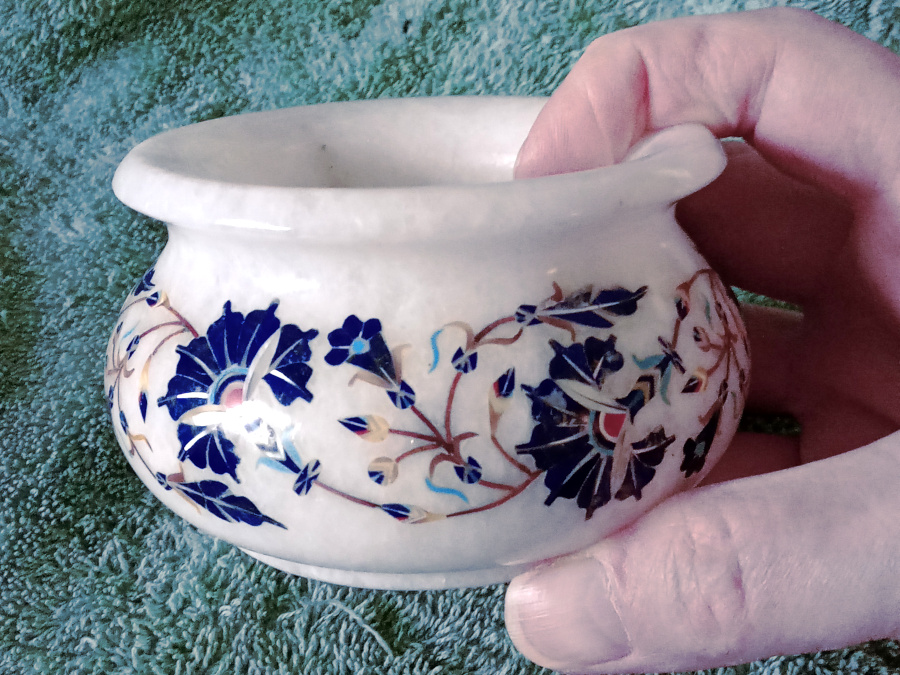
My more modest pot may not be as breath-taking, but it will serve to remind me of the wondrous art we saw. (All of the inlay art goes into a very hard marble that is a dazzling white.)
If you correctly count the tiny separate bits that make up what is shown in the detail image, you should get about seventy.
The colors in the inlay are light-fast. Table tops are a popular product of the studios. The marble and inlay aren't compromised by heat, and don't take stains. (Shipping.. of anything (inlay work, calligraphy, carpets... etc!) is always easy. If you shop at one of the places a good tour operator will take you, it is unlikey that your purchase will not arrive.) The table tops can be bought with a suitable wooden base included, flatpacked.)
Day 12 continued... The remainder of the day is at leisure; dinner tonight is on our own.
Accommodations: Courtyard by Marriott Agra
Meals: Breakfast, Lunch
=================Tuesday, November 14, 2023

Arose in Agra, went to Delhi airport, went to bed in Varanasi.
A major relocation day... but, as usual, it didn't feel like it.
DAY 13: Agra/Delhi/Varanasi- We begin our long day of travel this morning, departing by coach for Delhi where we have lunch at the airport.
Late this afternoon we board a flight to Varanasi, Hinduism’s holiest city and a center of learning, civilization, and religion since time immemorial.
Lacking in important architecture, elaborate palaces, and ancient fortresses, Varanasi nonetheless exudes an allure and mystique unlike any other Indian city, thanks to its role as a sacred place of pilgrimage. Tonight, we enjoy dinner together at our hotel.
Accommodations: Taj Ganges
Meals: Breakfast, Lunch, Dinner
Wednesday, November 15, 2023
DAY 14: Varanasi/Sarnath- Before breakfast today, those who wish can join in a private yoga session (6:30-7:30); this ancient meditation technique has been practiced in India for centuries.
After breakfast, we visit nearby Sarnath (depart 9am), where after achieving enlightenment the Buddha delivered his first sermon and founded the Sangha – the first monastic community – in the 6th century BCE. A Turkish invasion at the end of the 12th century CE left the city in ruins; it lay forgotten until the 19th century when excavation and restoration efforts began.
Day 14 continued... One of Buddhism’s four holiest sites, Sarnath draws pilgrims from the world over.
We visit Sarnath Museum, housing a superb collection of Buddhist artifacts from excavations here. Highlights include a statue of the Buddha turning the wheel of law, and the celebrated Lion Capital of Emperor Ashoka, a sculpture of four lions that once topped a column erected during the emperor’s reign which dates to 250 BCE.
The Lion Capital has been the national emblem of India since the country’s independence Its image appears on all Indian currency, passports, official seals, and government buildings.
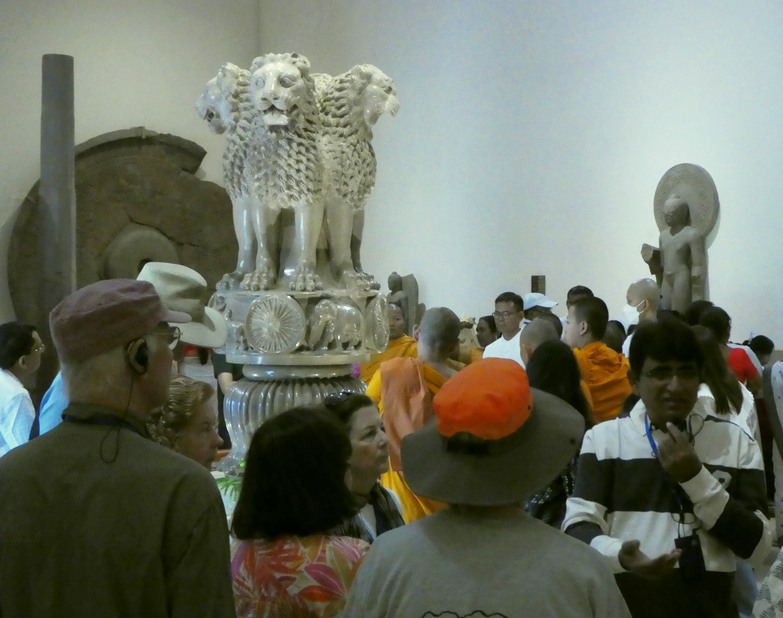
Our outstanding tour director is at the lower right, using the excellent "Whisper" system to minimize the disturbance we made for others, and maximize our enjoyment of his engaging, informative, and often amusing commentary.
Day 14 continued... Afterwards, we enjoy wandering the park (from 11:00) with some temples and stupas (monuments designed to house Buddhist relics), and archaeological remains.
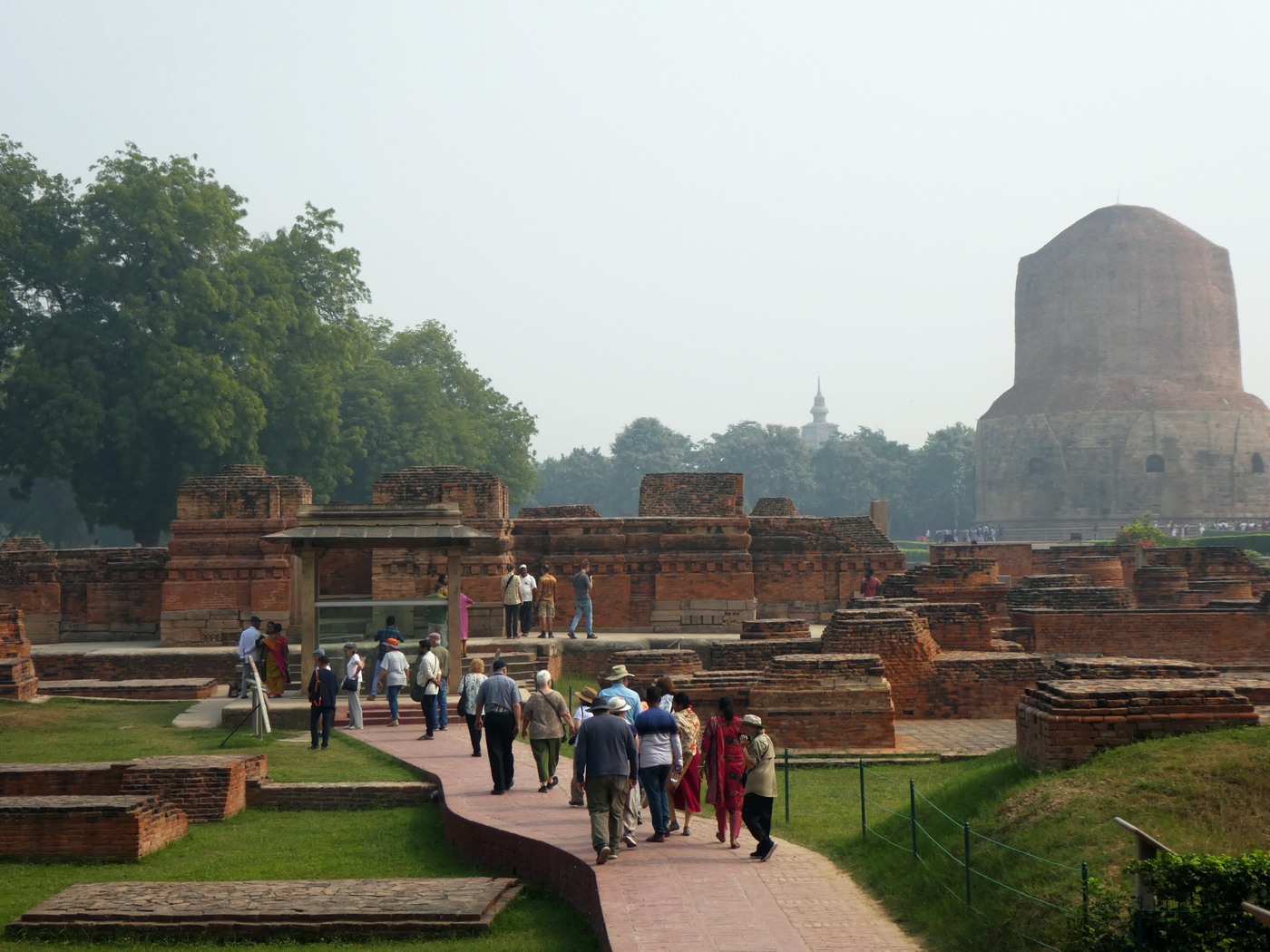
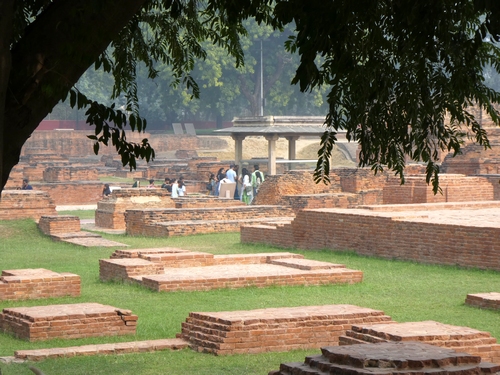
(The people on the path in the right hand picture are most of the congenial group I travelled with.)
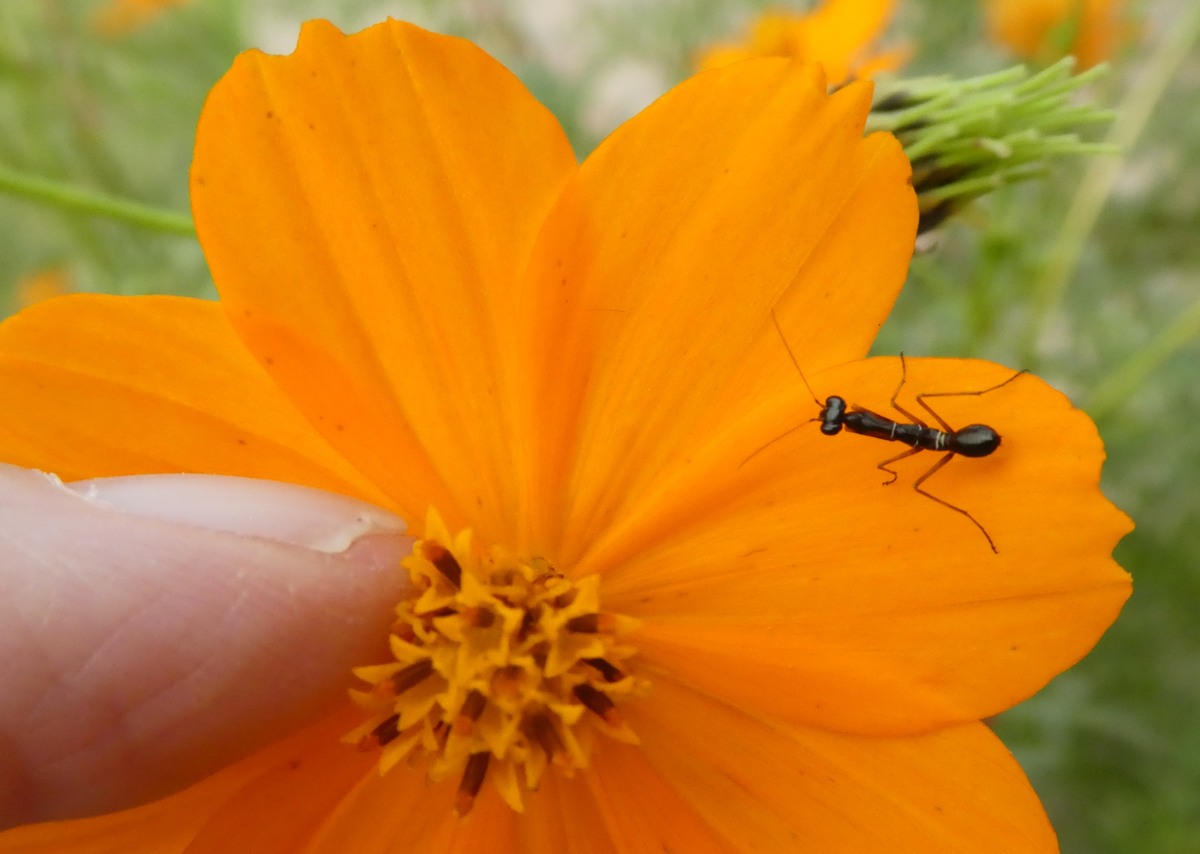
It was in the Sarnath garden that I came across this little... ant?
I think other fauna could be forgiven for thinking it was an ant, don't you?
Ah, yes...
v v (scroll down) v v v
... but...
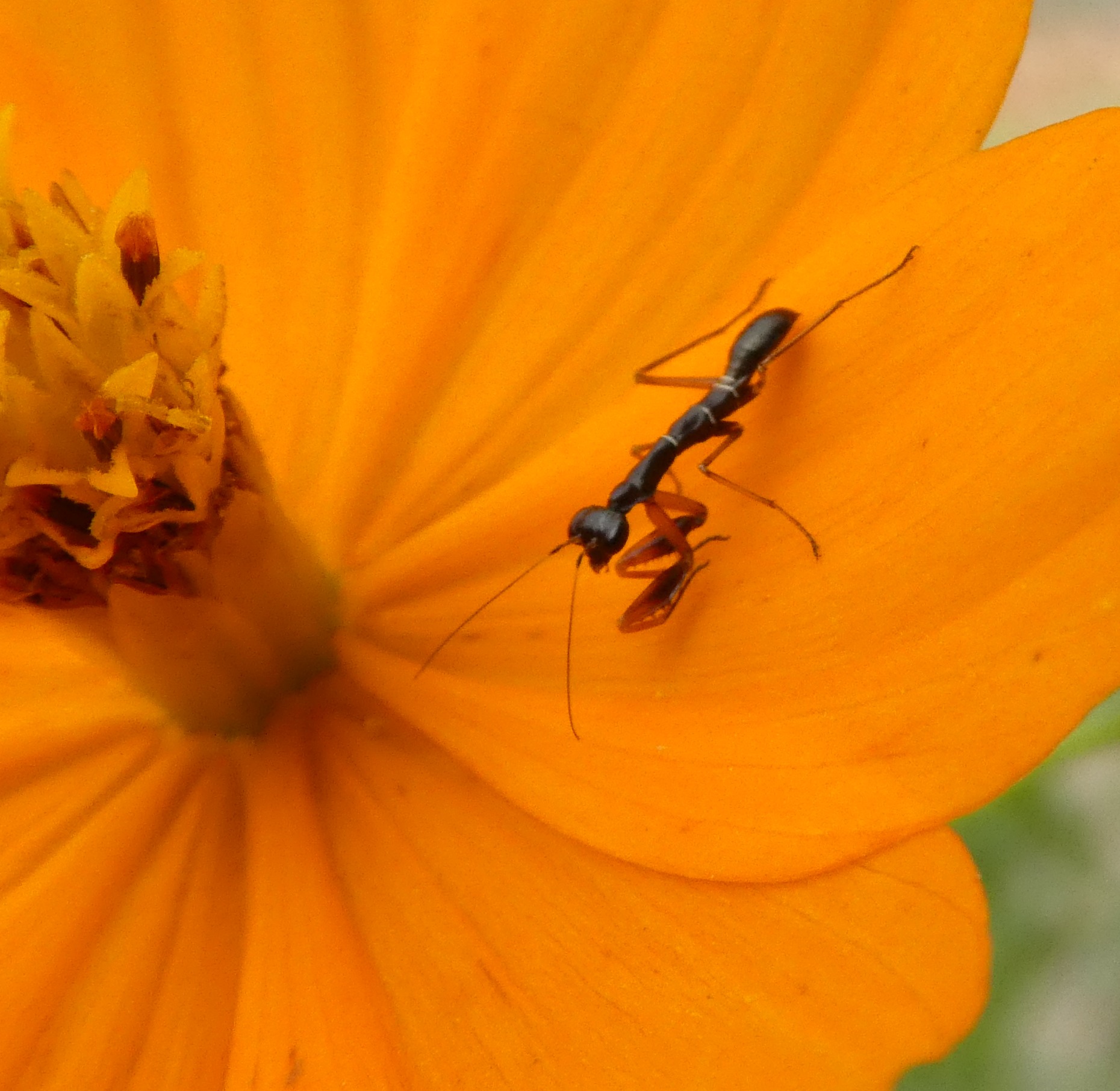
Not an ant! A mantis!... A much more dangerous creature if you are his size!
I took an unescorted stroll in the neighborhood of our hotel in the afternoon... and very pleasant it was too.
Day 14 continued... Back in Varanasi tonight, we leave the hotel at 4:30, heading off to attend a traditional aarti offering ceremony. En route, as we cruise along the Ganges, we watch as devout Hindus offer their lit lamps to the deities.
That modest little entry in the official itinerary didn't begin to hint at the extraordiary evening we had. Most of the note I made at the time just says "indescribable". But, in due course, I will try. (We also passed the cremation ghats en route to the ceremony. In a word... OVERWHELMING. But still in a good way. Even though I anticipated overwhelming experiences in the wondrous land, I was left amazed... or should I say "dazed"?
The photo was taken after we had joined the raft of boats offshore at the perfect time. We weren't "too early", but had we got there later, we would have been among the many boats "outside" of our layer. A guess at the crowd? 20,000? Many on the land, many in the boats. And this ceremony happens every evening, on the bank of the river.
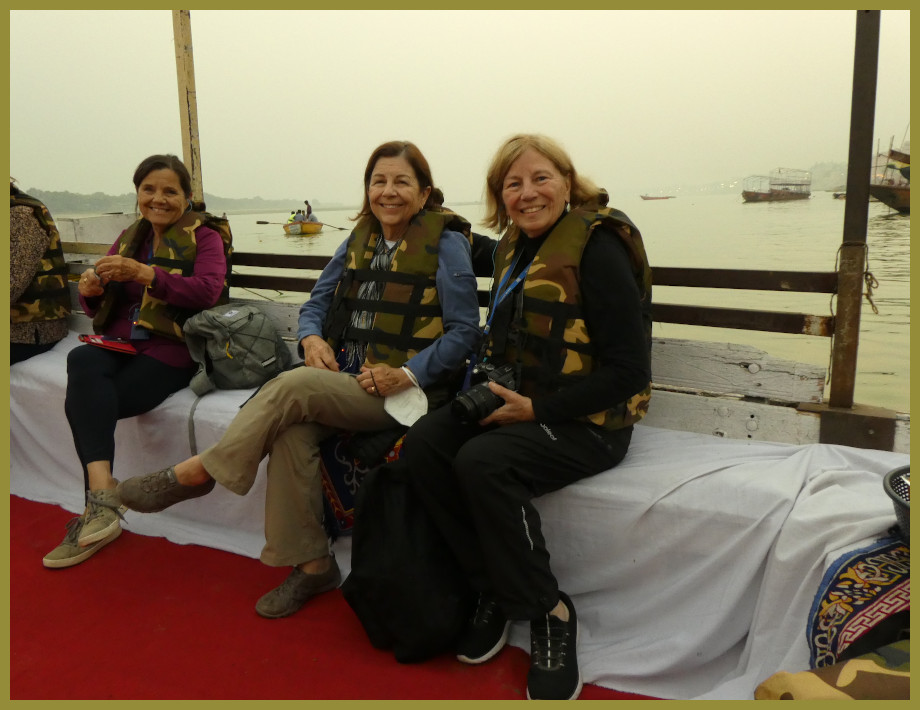
The photo shows the fine style in which we travelled to the aarti ceremony. The magical presence of the boat waiting for us at the landing stage is just one example of the scores of times the superb Odyessys Unlimited logictics manangement overcame the apparent confusion all around us.
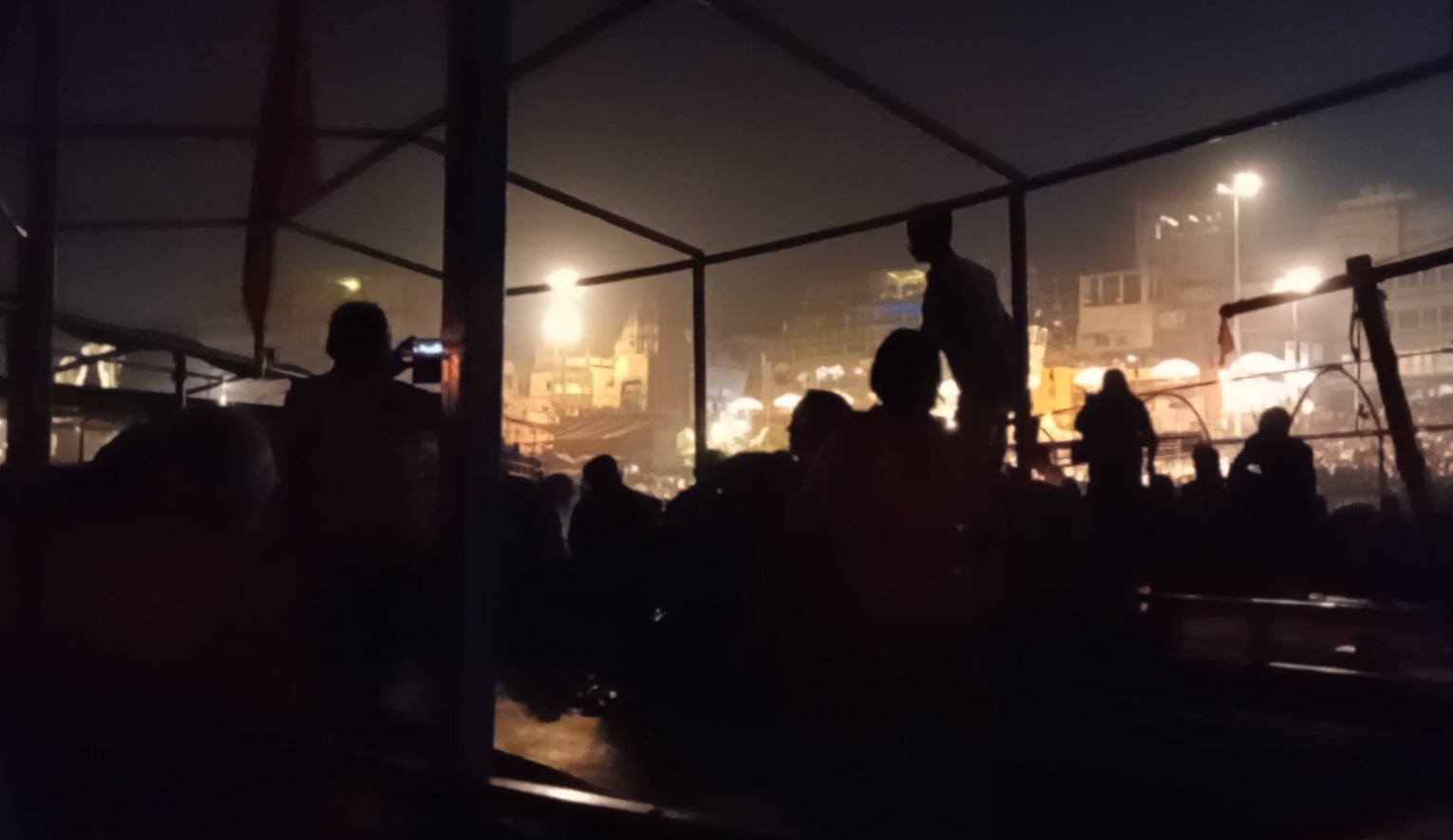
Day 14 continued... Following this moving experience, we enjoy dinner tonight at our hotel from about 8pm.
Accommodations: Taj Ganges
Meals: Breakfast, Dinner
Thursday, November 16, 2023
DAY 15: Varanasi- Early this morning we return early to the Ganges, experience the daily morning aarti.
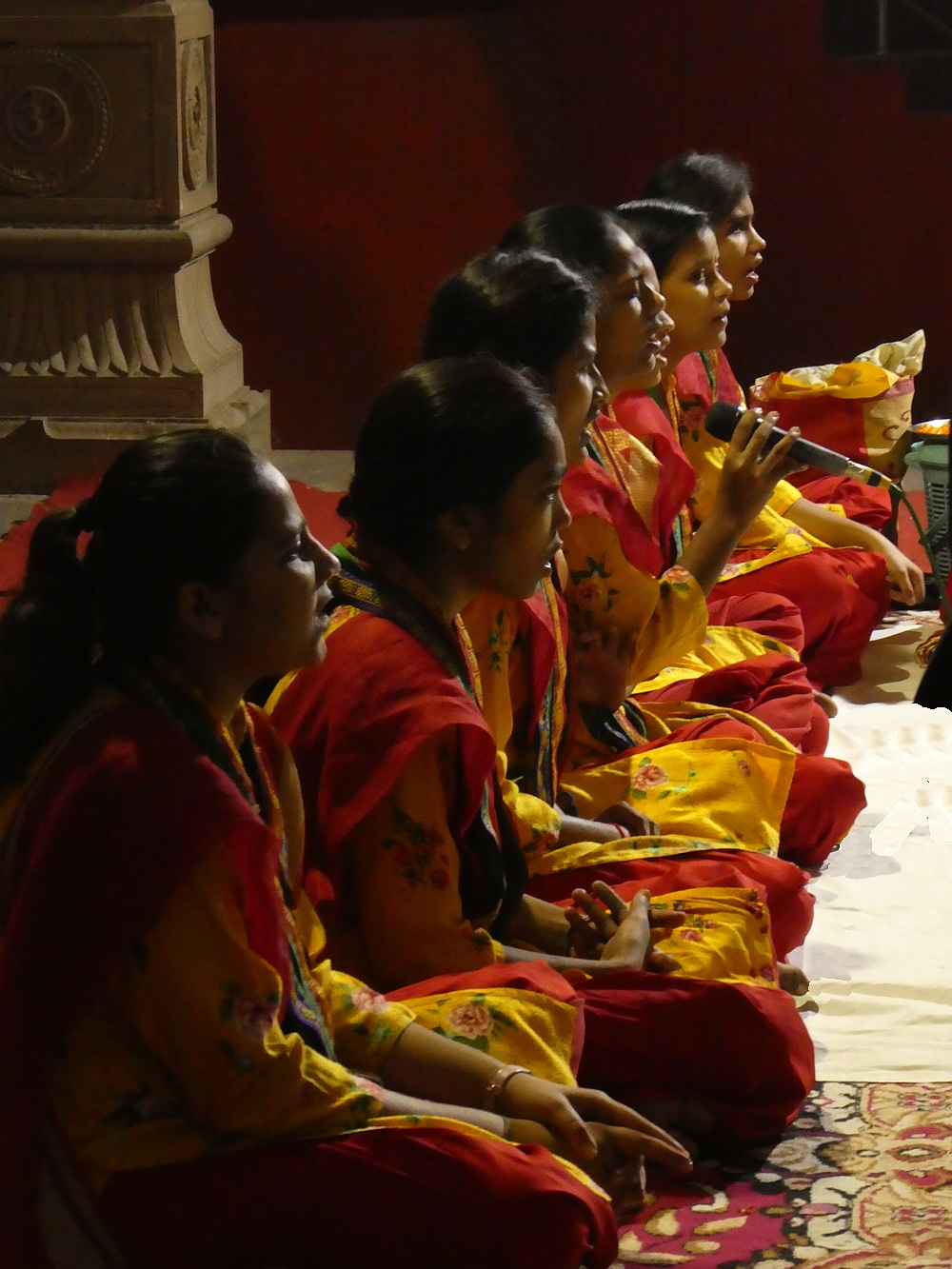
We did set out early... it was still quite dark. Very atmospheric, on the river later.
The morning aarti is not as huge as the evening devotions... but it is still big! This time we were on the shore near the heart of the action. (We watched the evening aarti.. think Superbowl!... from a boat in the river. The moring aarti could be smaller, without being small. Think Rosebowl.
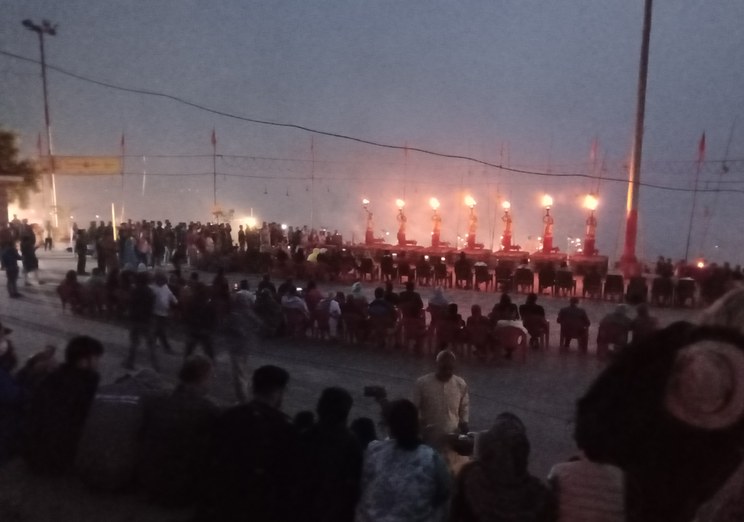
After watching the aarti, we were provided with a boat again, not the one in the image, but ours was similar. The run along the river was fablous. The light. The other boats. The things we could see along the banks of the river.
Day 15 continued... We continue in the area after the devotions...
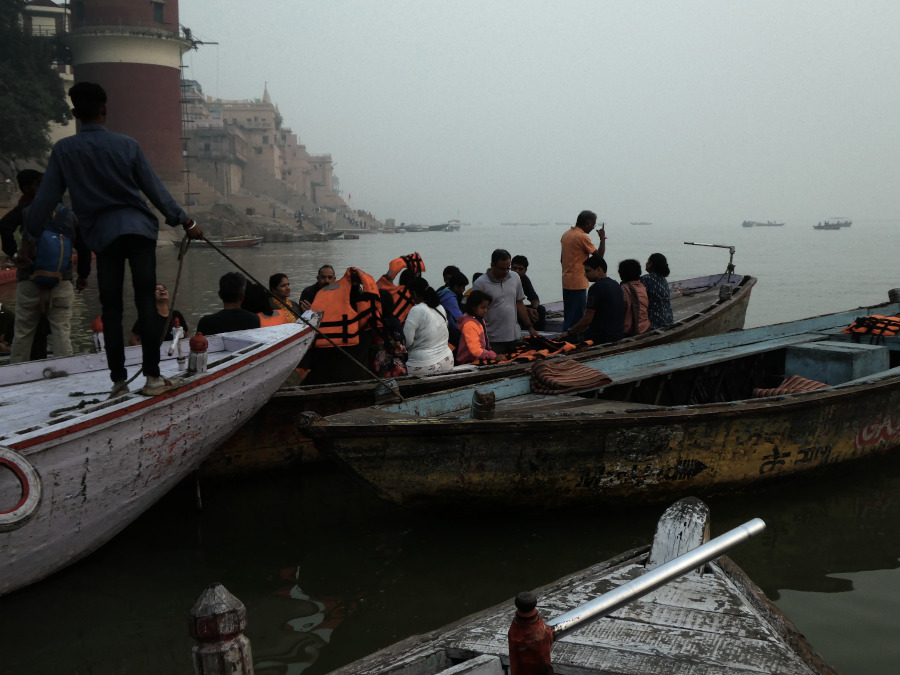
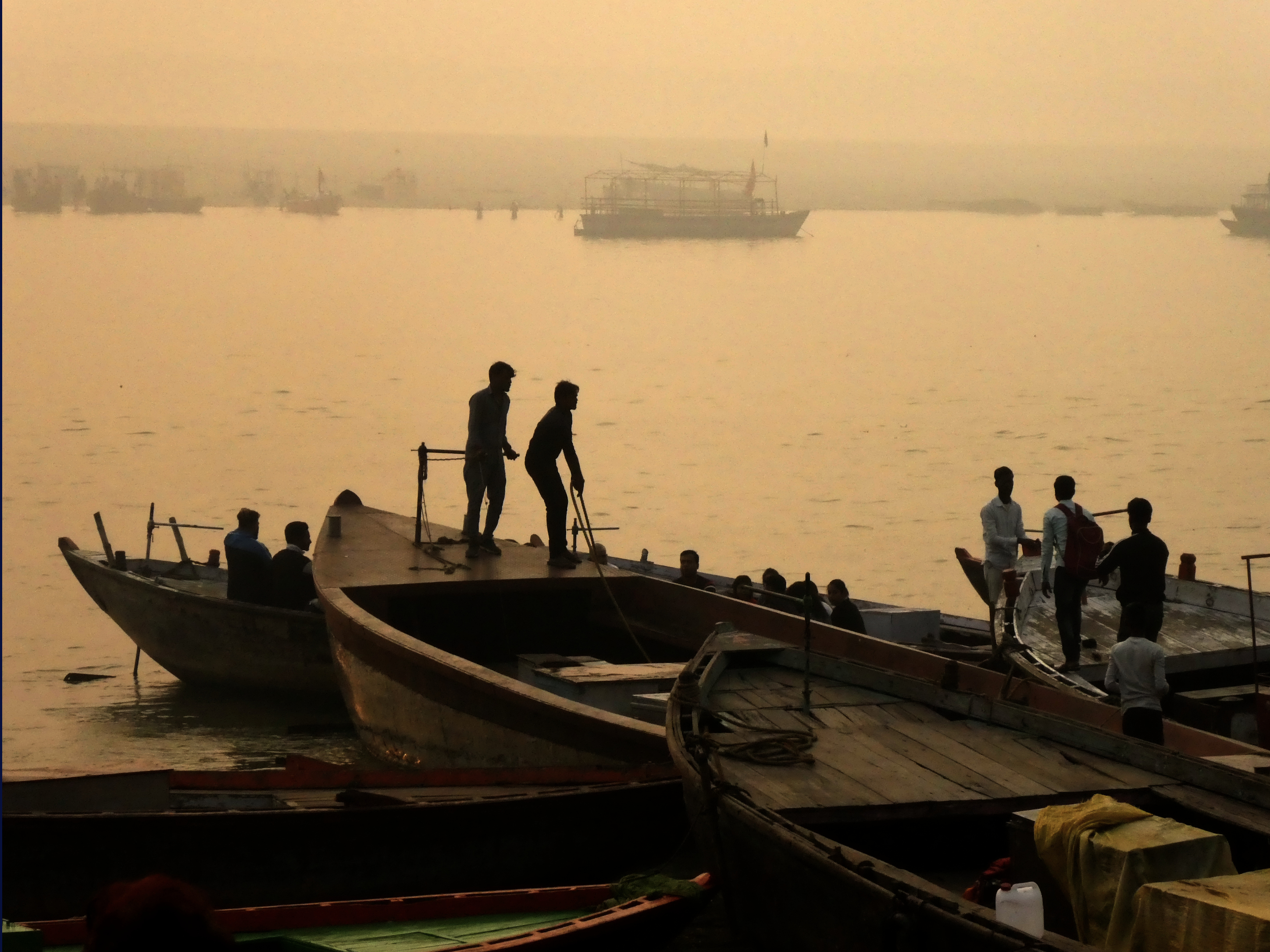
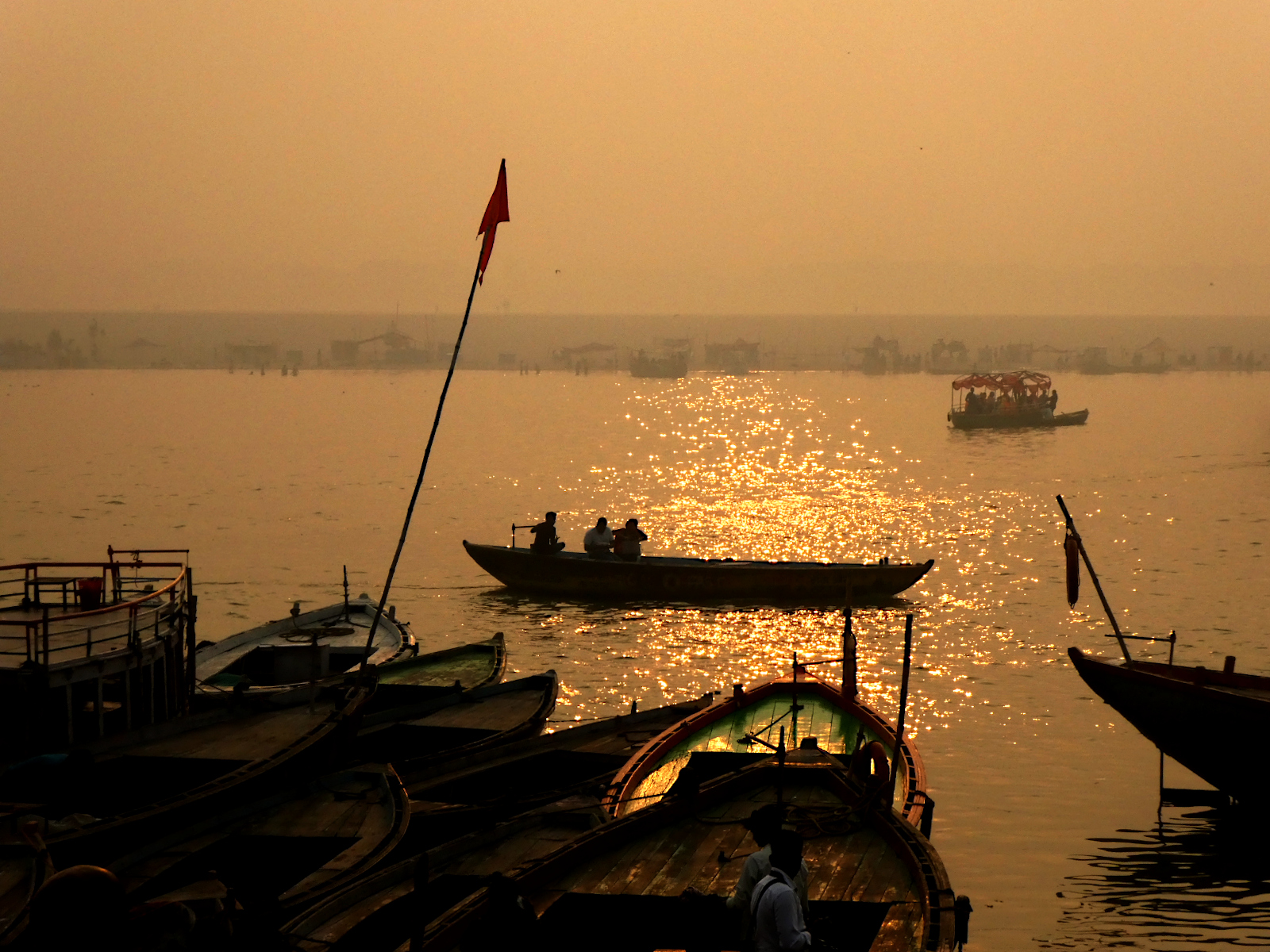
Day 15 continued... Hindus believe that bathing in the Ganges at least once in a lifetime is both a duty and a privilege; it can help lead to the forgiveness of sin and the attainment of salvation. We visit several of the important ghats by boat as we experience for ourselves the spiritual mystique of these hallowed waters. We see Hindu pilgrims perform their time-honored rites along the ghats (steps) leading to the sacred river.
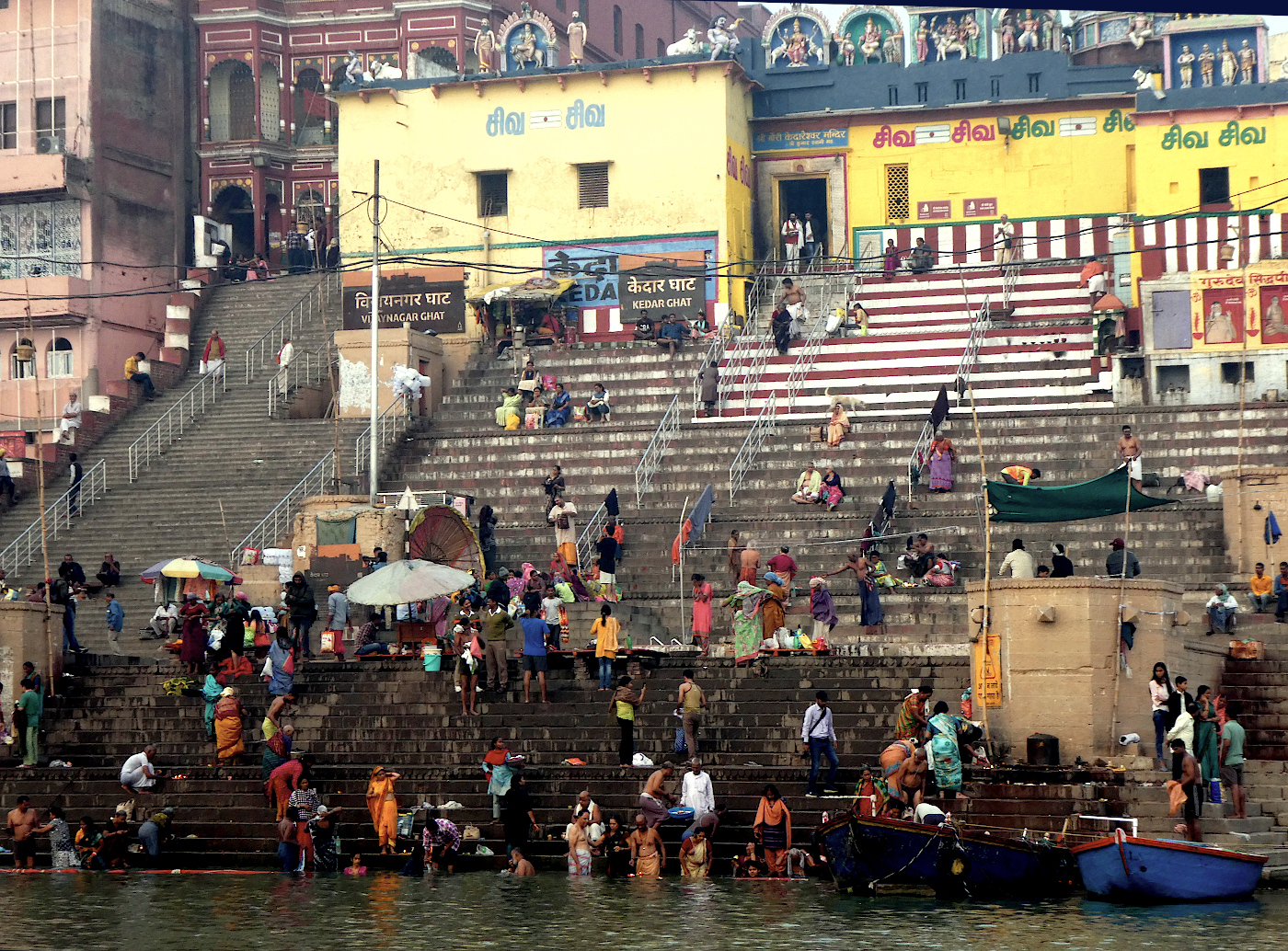
(My next jigsaw puzzle, I think.)
Day 15 continued... As we stroll down narrow lanes and alleyways lined with houses and shops, we pass cyclists, cows, and city denizens of all kinds. Returning to our hotel for breakfast, we have some time at leisure with lunch on our own before this afternoon’s visit to a private classical sitar performance.
Day 15 continued... We set out again, and visit a workshop where silk tapestries are woven.
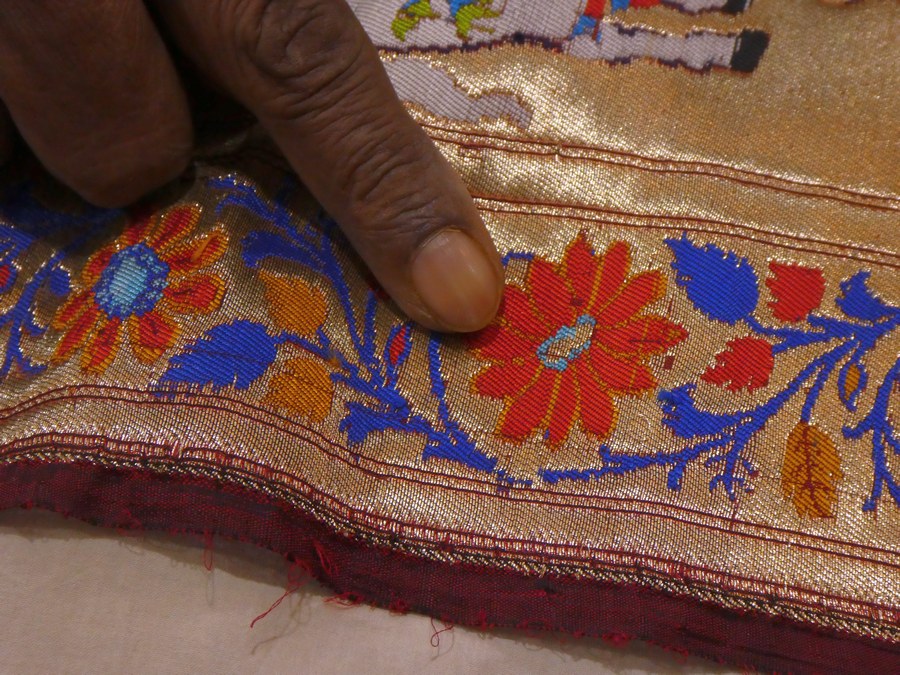
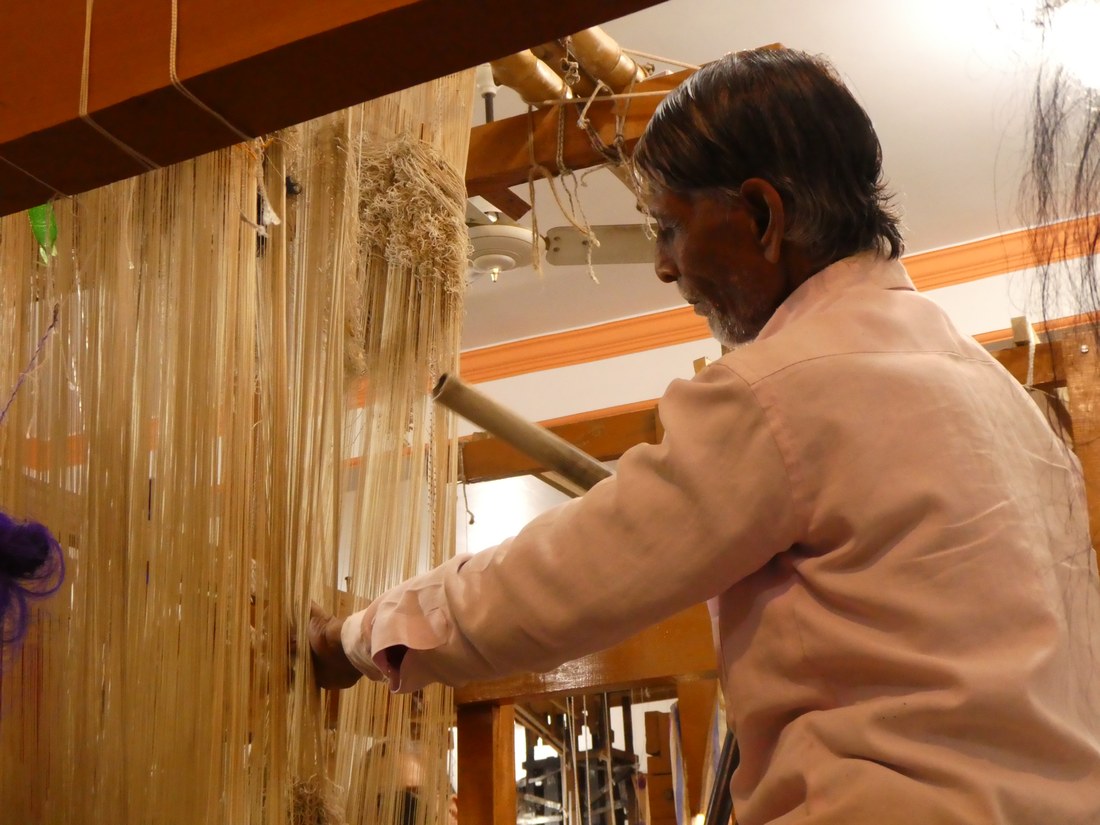
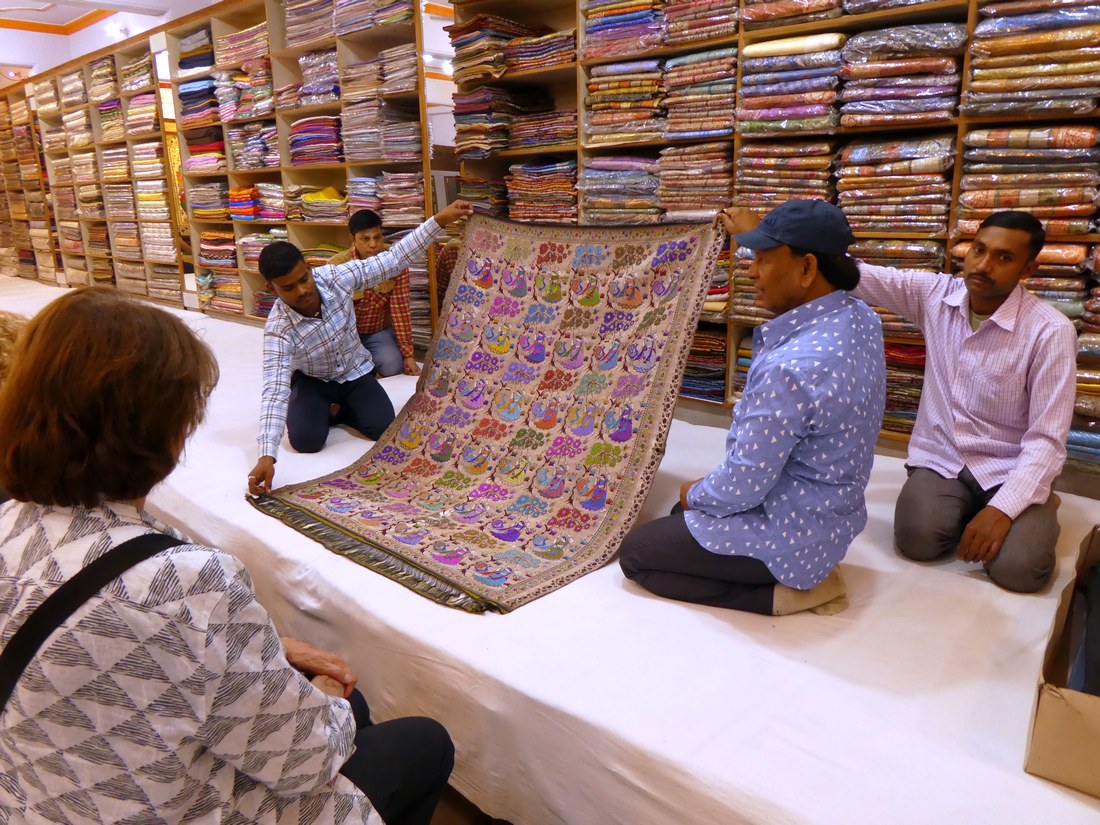
(The colors were not as garish as they may appear on your screen. I'm afraid I was disappointed by my efforts with my cameras on this trip. I will try to re-process some of the images in due course.
Day 15 continued... We arrive at the home of a famous sitar player where we enjoy a performance. The home is also a music school, and we may hear some students practicing. Tonight, we celebrate our journey at a farewell dinner with our fellow travelers.
Is there a "good" place for the next photo? Probably not. But to give a complete report on our trip, it is necessary to admit that India doesn't have all the answers.
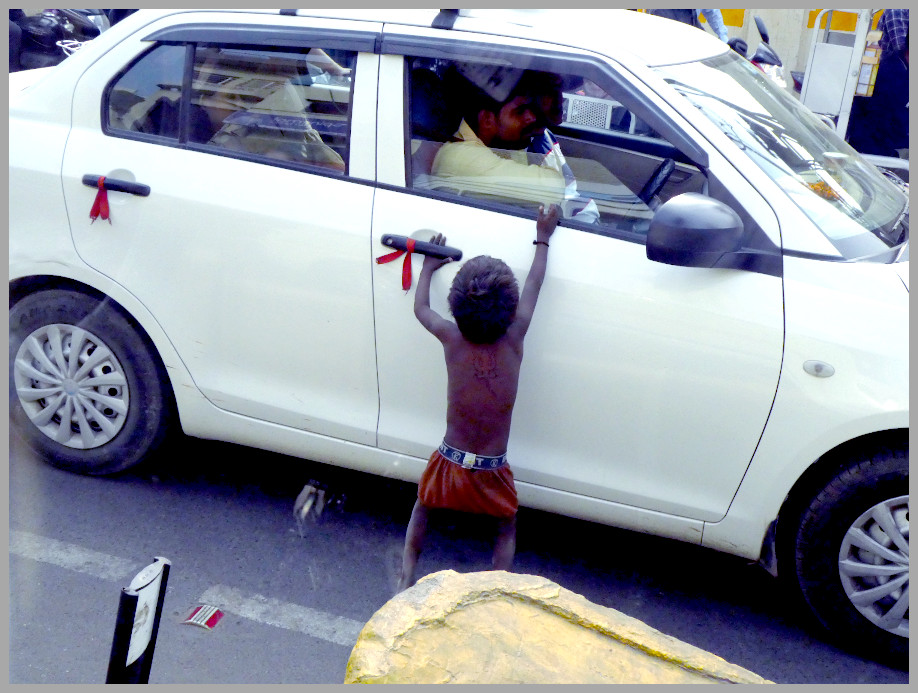
I put this photo here, because that is where seeing this child came in the sequence of our journey. He was just one example of things seen quite often.
Accommodations: Taj Ganges
Meals: Breakfast, Dinner7
==========================Friday, November 17 and Saturday the 18th, 2023

We all arose in Varanasi on the 17th and flew to Delhi.
At this point, the group, sadly, broke into those going home, and the two of us doing the Nepal extension... myself and the Connecticut friend who made me aware of this wonderful tour... spent the night at the airport hotel in Delhi, and on the 18th, arose Delhi, flew to Nepal.
The rest of our very convivial group flew home on the 17th or 18th.
DAY 16: Varanasi/Delhi- We fly to Delhi and then transfer to our hotel, which is conveniently located near the airport. Depending on flight times, we will have either the morning or afternoon at leisure today. We have the evening free as well, with dinner on our own.
Accommodations: Pullman New Delhi Aerocity
Meals: Breakfast
Saturday, November 18, 2023
DAY 17:
============
Saturday, November 18, 2023

Arose in Delhi (India), went to bed in Nagarkot (Nepal). Nagarkot is just a little east of Kathmandu, at the scale of the map. But, on the ground, we were completely beyond the urban sprawl in the valley, and up in glorious hills, with the big "hills", gloriously in front of us.
DAY 17: Delhi/Kathmandu/Nagarkot- Today we fly to Kathmandu, Nepal’s capital and largest city, high within the storied Himalayas.
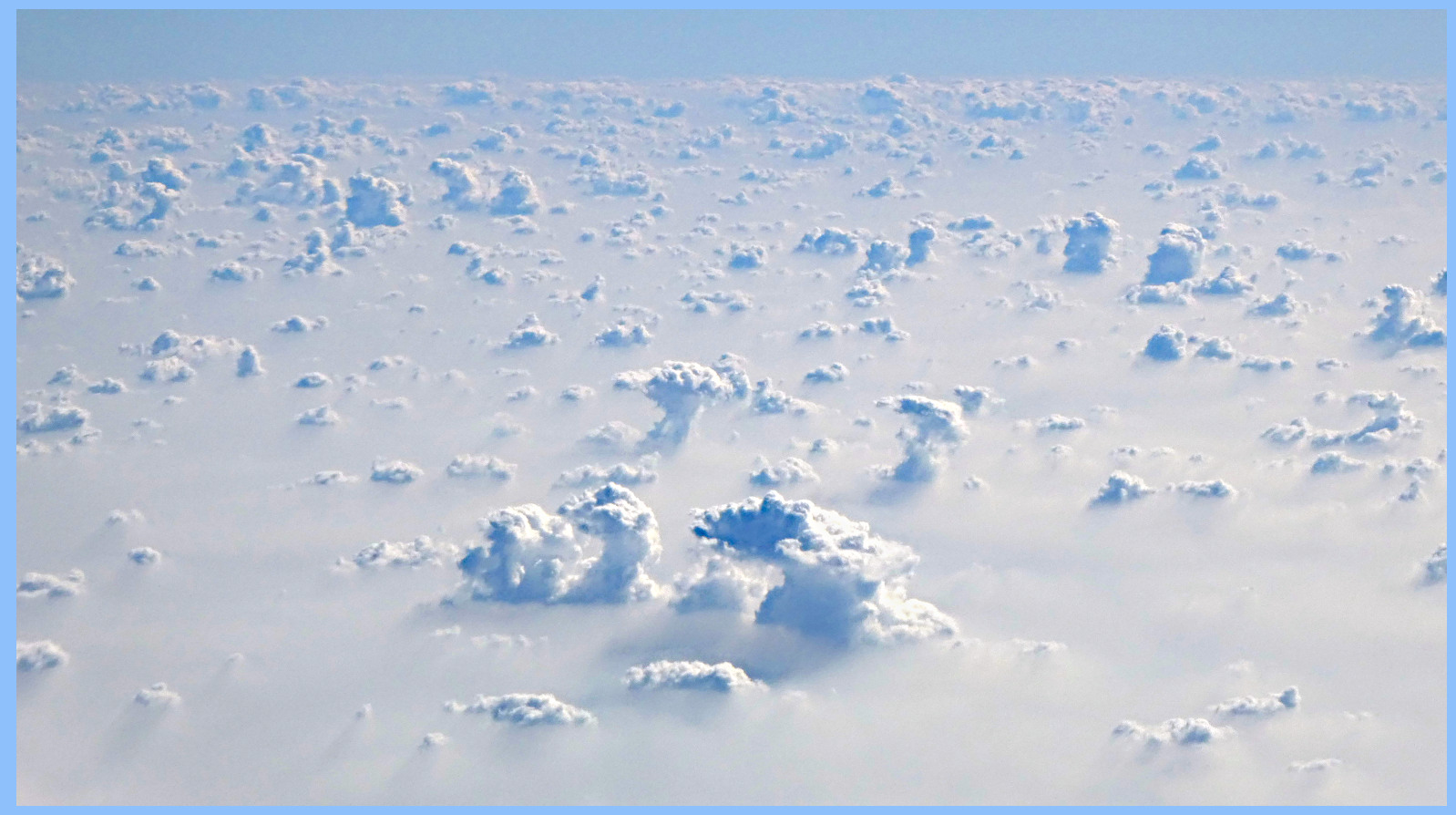
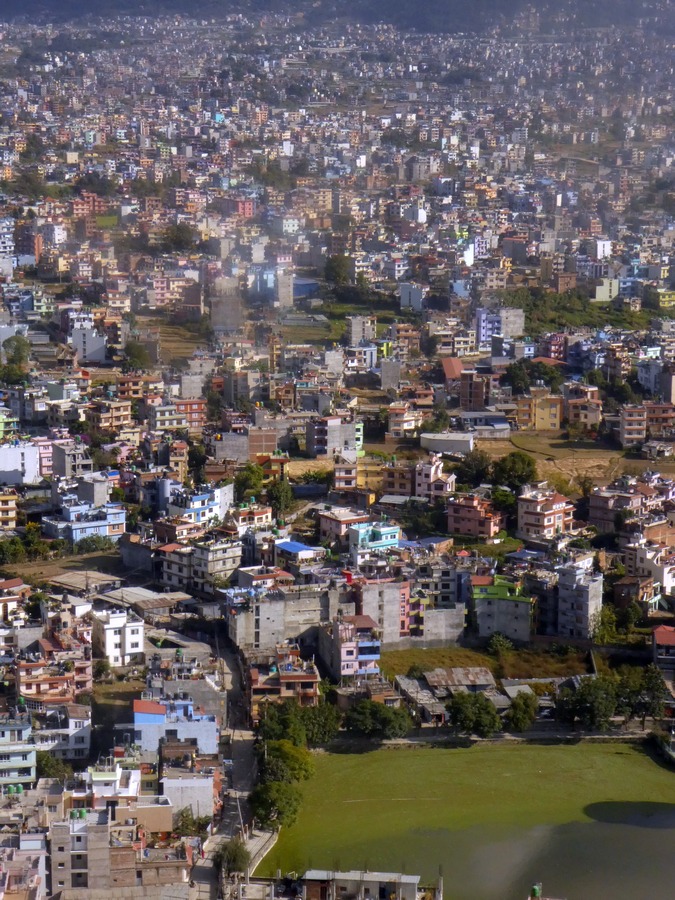
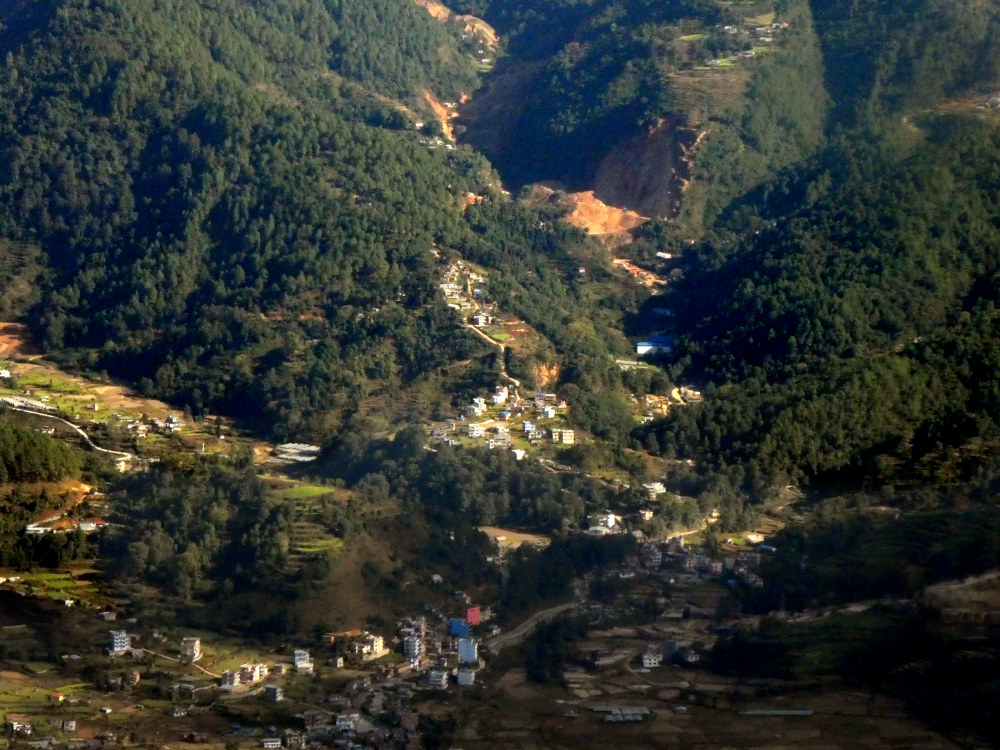
A word about spellings: If, like me, you were wondering about the "h" I've tried to include in Kathmandu, you are showing you age! Both versions of the name were used in books... but not very often!... from 1800 to 1940. At that point usage began to pick up, with Kathmandu outstiping the other version. The rise was meteoric in the 1960's.
How do I know this? books.google.com/ngrams is a fun tool.. and useful when you are wanting to conform to norms.
(A note about the Odysseys Unlimited itinerary notes: For the Nepal portion of the trip, I've started with the original itinerary, and then tweaked that to reflect what we in fact ended up doing. There were no significant omissions from the original plan, and, on the other hand, some excellent "extras" were added.)
Day 17 continued... Upon arrival, we meet our Nepalese tour director, and have lunch.
It was a very agreeable meal in a restaurant near the airport that was, for a welcome change, the sort of place everyday people might go, vs the top class places we often went. Our new tour director proved to be excellent.
Day 17 continued... We board a motorcoach for the ride to Nagarkot, a hilltop village commanding a spectacular vista of Nepal’s major Himalayan peaks.
As we travel from one city to the other, we are riding through truly significant territory: the three major cities of the Kathmandu Valley (Kathmandu, Patan, and Bhaktapur) boast seven UNESCO World Heritage Sites – the largest concentration of such riches in the world.
Day 17 continued... Upon arrival in Nagarkot, we may have the opportunity to see the sun set over the Himalayas, if the weather cooperates. Tonight, we are free for dinner on our own.
Our hotel was magnificent. It was perched high on a ridge, in its own grounds, in the Nagaracot district. The architect deserves an award for being sensitive to the site, and using it brilliantly. (I will have much more to say about this!) It had been built in stages, and parts were delightfully quirky. Our rooms were in a modern wing where things were fresh, new, stylish... but in keeping with the nature of our surrounding. Not all chrome and glass, in other words.
Odysseys Unlimited had secured the finest rooms in the place for us. (In our wing, all were similar in design, but the location of our rooms... apart from the trek to get to them!... made them "the best". (The trek was worth it!)
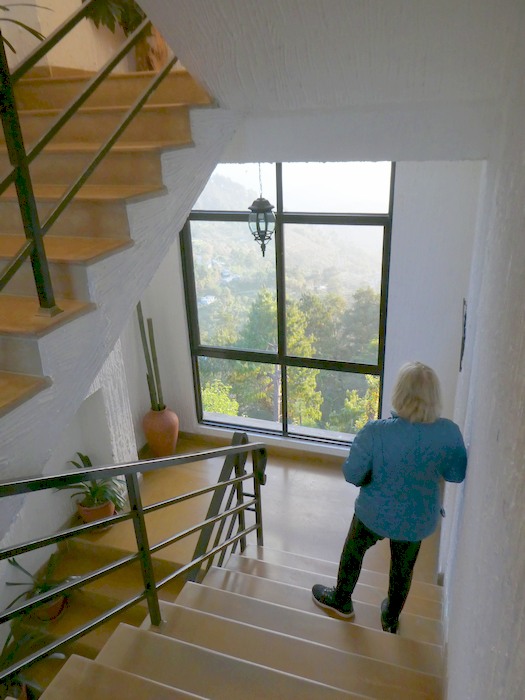
The central dining area reminded me of ski lodges I have visited... minus all the skiier's clobber!
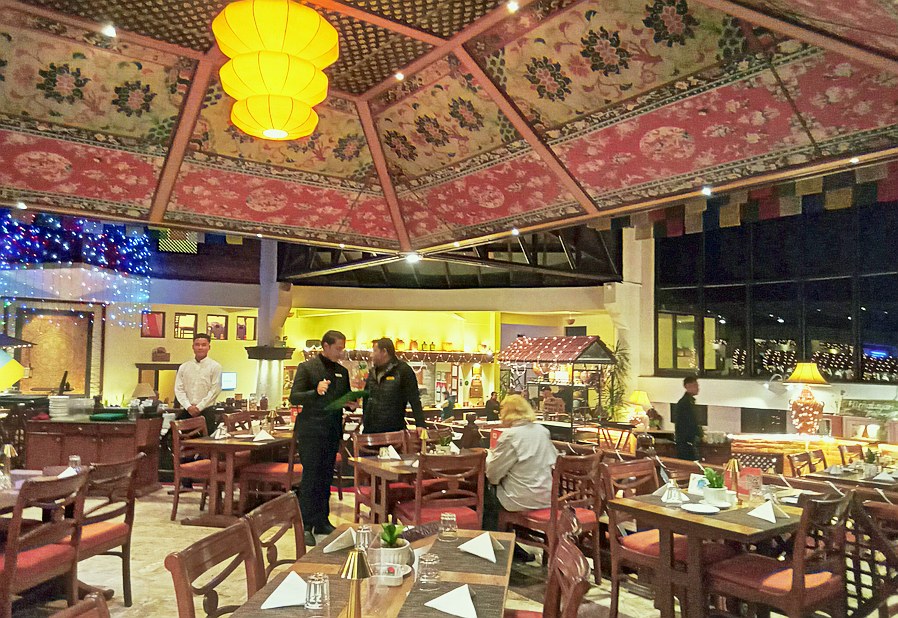
Our rooms were outstanding, with magnificent views of the big peaks across the valley from the ridge we were on.
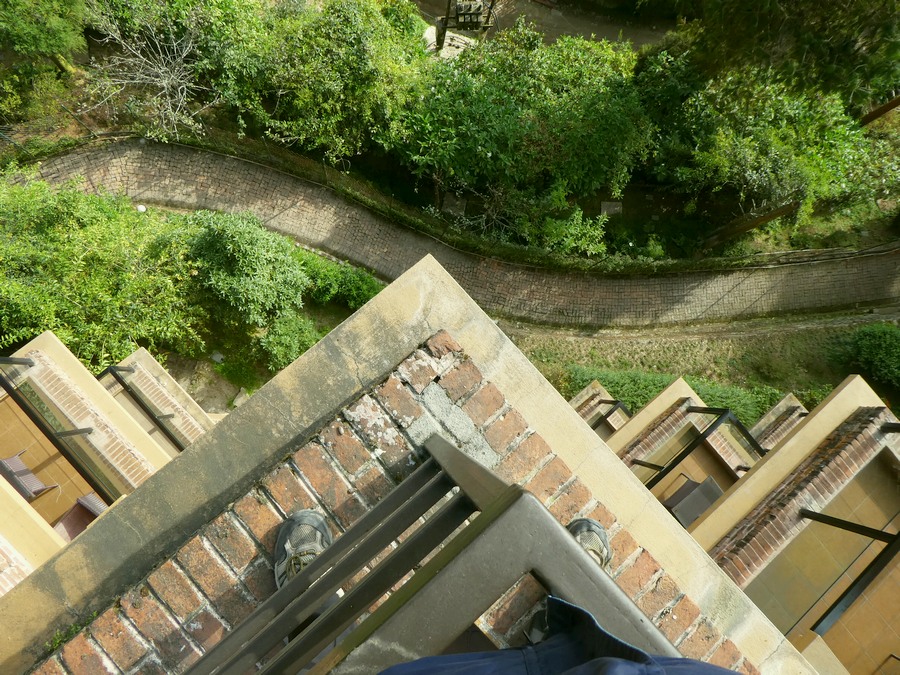
This was the view looking down from my balcony. Cleverly placed walls made each one quite private... I had to lean out to get this photo.
The rooftop was an extra place to enjoy the view in another way. In this image, the mist was hiding the huge peaks around us.
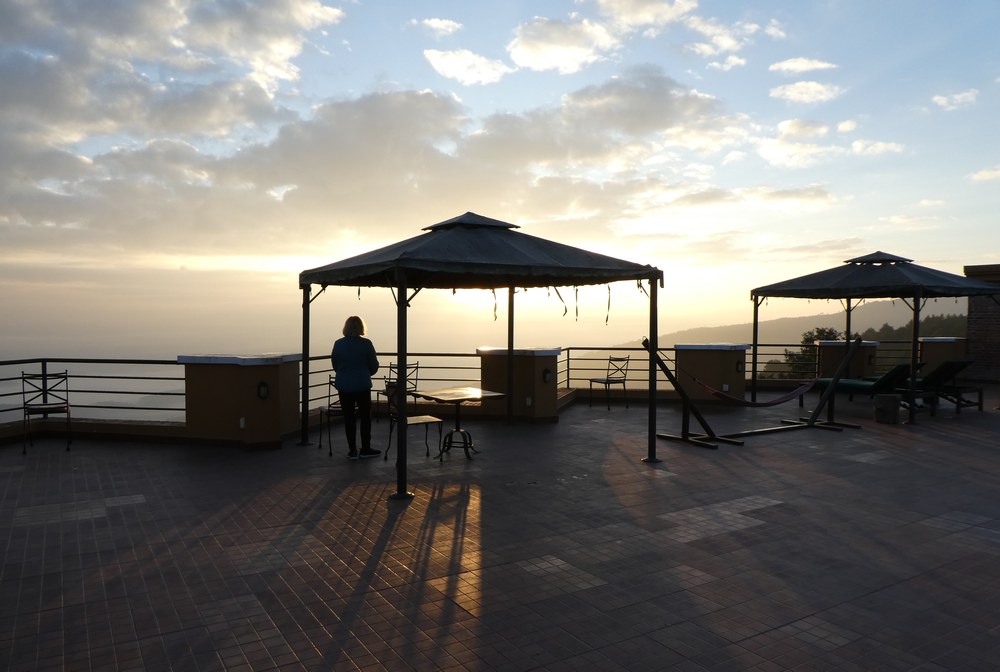
Accommodations: Club Himalaya Nagarkot
Meals: Breakfast, Lunch
Sunday, November 19, 2023
DAY 18: Nagarkot- Weather permitting, early this morning we have an opportunity for an unforgettable experience: watching the sun rise over the fabled Himalayas from our hotel’s rooftop observatory.
Located 20 miles outside Kathmandu, Nagarkot sits at an elevation of nearly a mile, making it one of the most scenic spots in Bhaktapur District. When Kathmandu Valley below is obscured by cloud cover, Nagarkot feels like an island amid an ocean of clouds, and from here, it’s possible to see imposing Mount Everest in the distance on clear days. In addition to Everest, the Himalayas also contain eight of the next nine highest peaks on Earth. Despite their enormous size, the Himalayas are actually one of the world’s youngest mountain ranges, formed some 40-50 million years ago when the tectonic plate containing the Indian landmass collided with Asia. Because the Indian subcontinent continues to slowly shift northward (moving underneath Asia at roughly 50 mm per year), the Himalayas are thrust upward, with an average height increase of 5 mm per year.
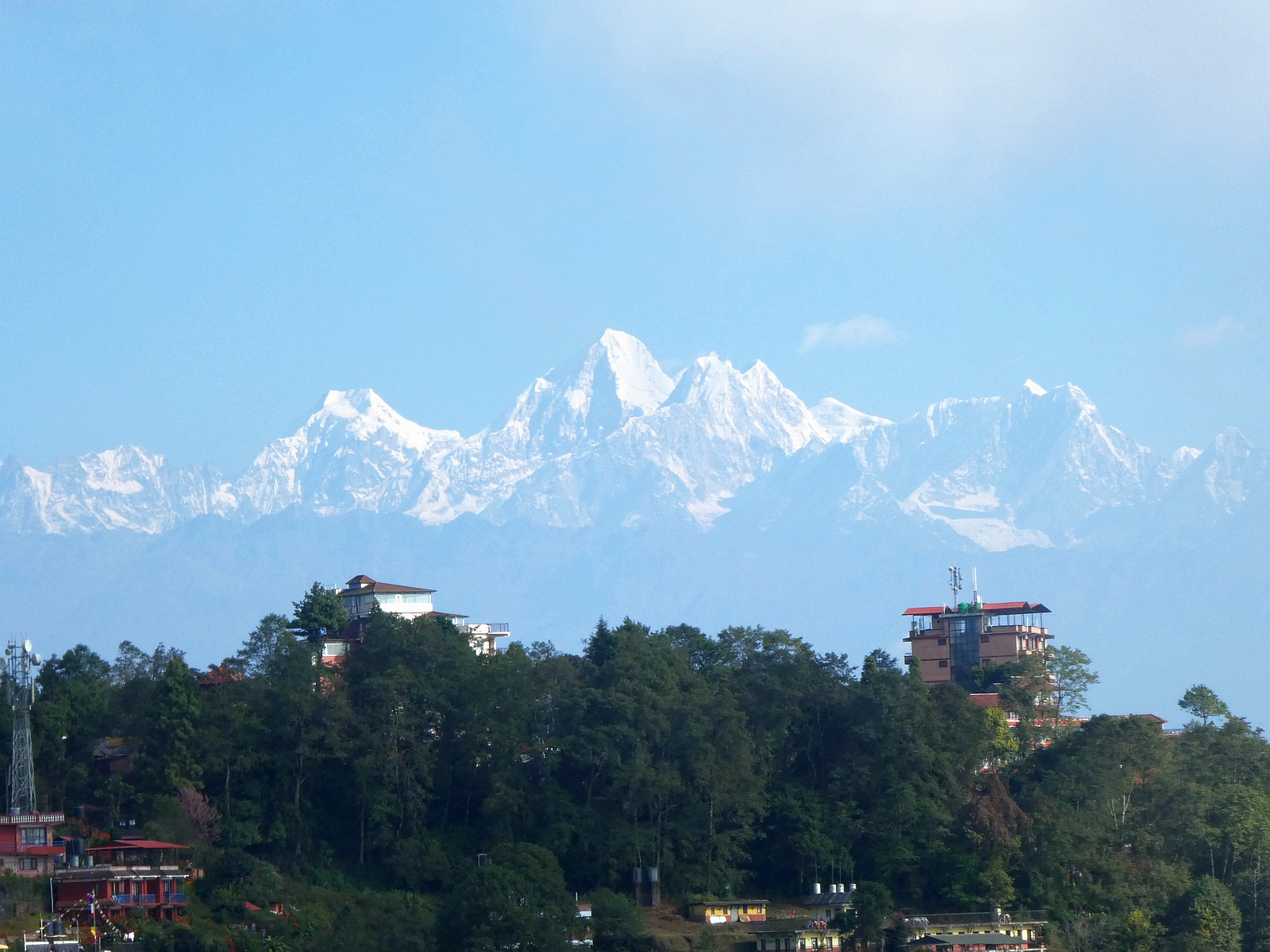
Day 18 continued... After breakfast at our hotel, we take a short drive to a place to start an easy walk around the village just below our hotel. We are likely to be able to meet local people on our walk.
What you see on the right is a rather ingenious still for turning beer/wine in to spirits. (It was not the only one cooking away as we toured the neighborhood!)
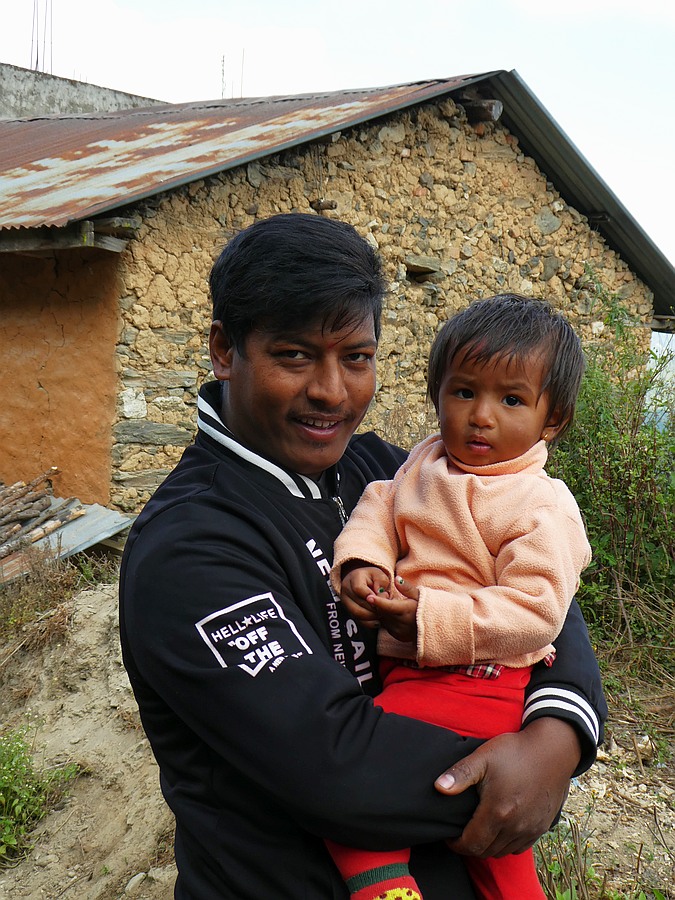
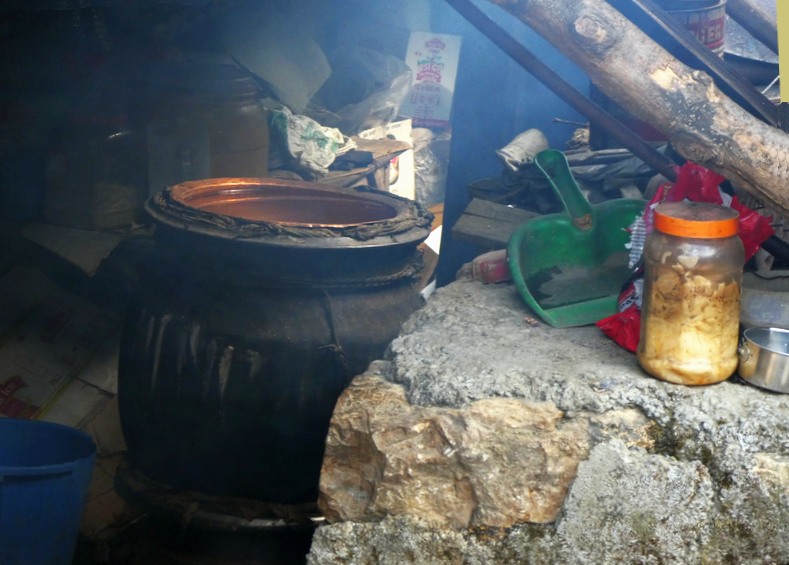
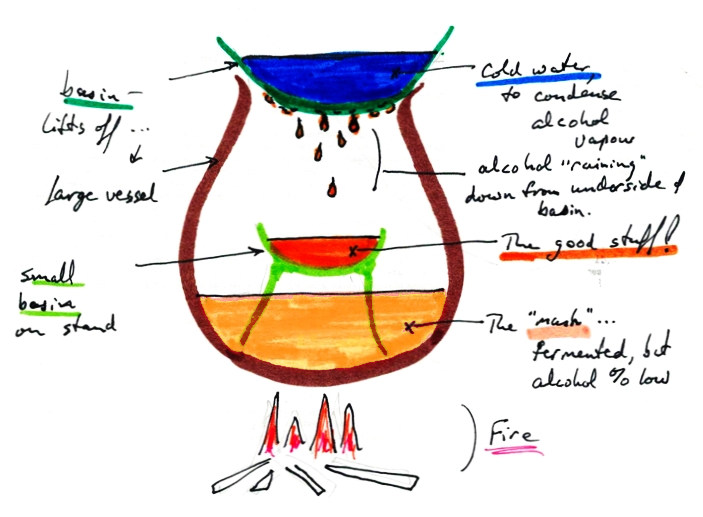
The still may be very simple... but, alas, it isn't very good. The Good Stuff is often contaminated by Bad Stuff... methanol. Do not try this at home.
The "official" itinerary said of the afternoon...
Day 18 continued... We have time for lunch on our own, and may also wish to take advantage of the hotel’s health and fitness resources, sit by the pool, or pass some quiet time in the library. The remainder of the day is at leisure amid the stunning Himalayan scenery.
But our splendid tour director gave up most of what could have been a quiet afternoon for him (or time to keep the show on the road... both this tour director, and the one who cared for us in India, must have had to "deal with things" from time to time... but I never noticed either of them doing it.) He arranged a vehicle for 3 pm, and took us along the ridge to a trig station. Which was very exciting for me... more to come on why!
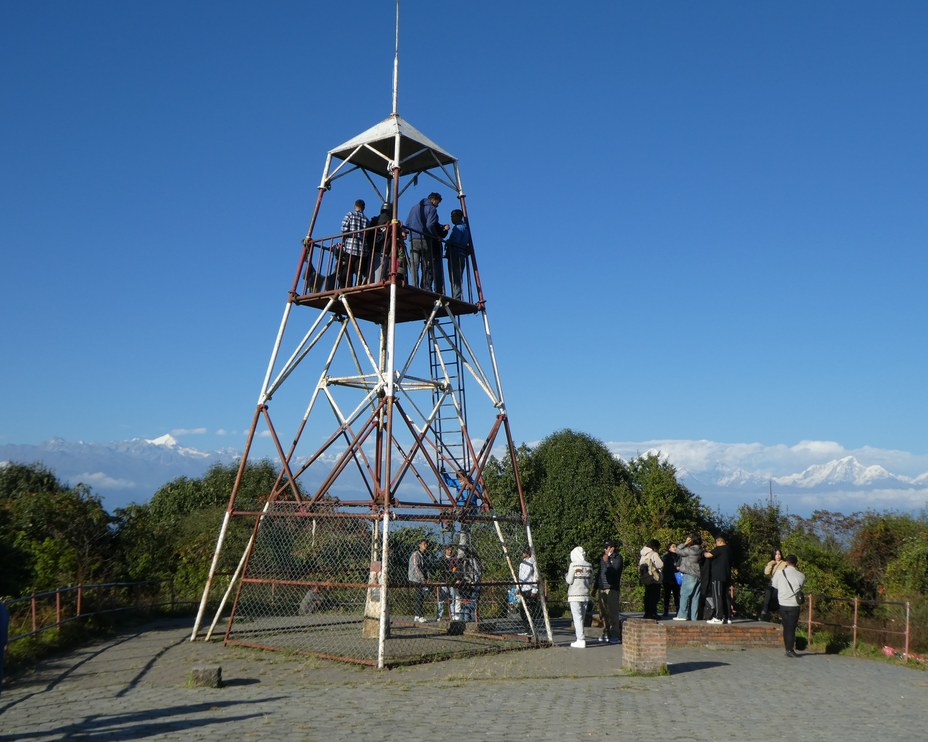
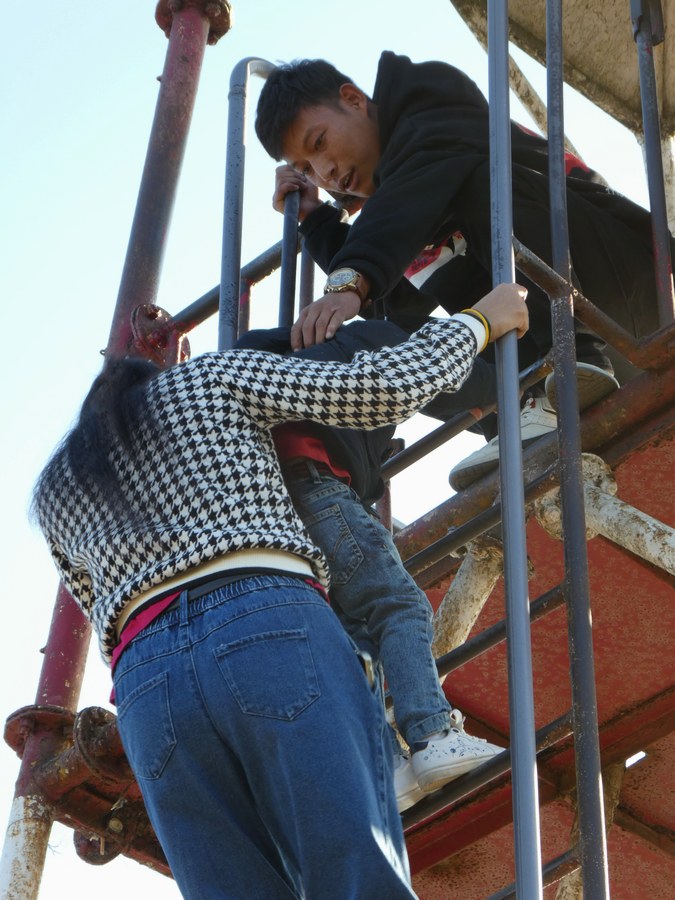
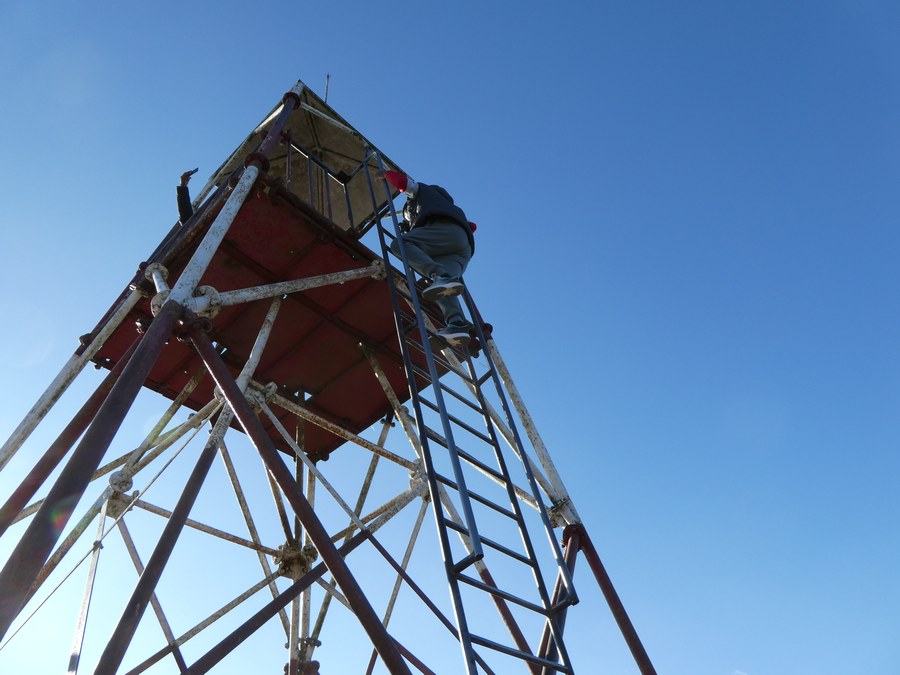
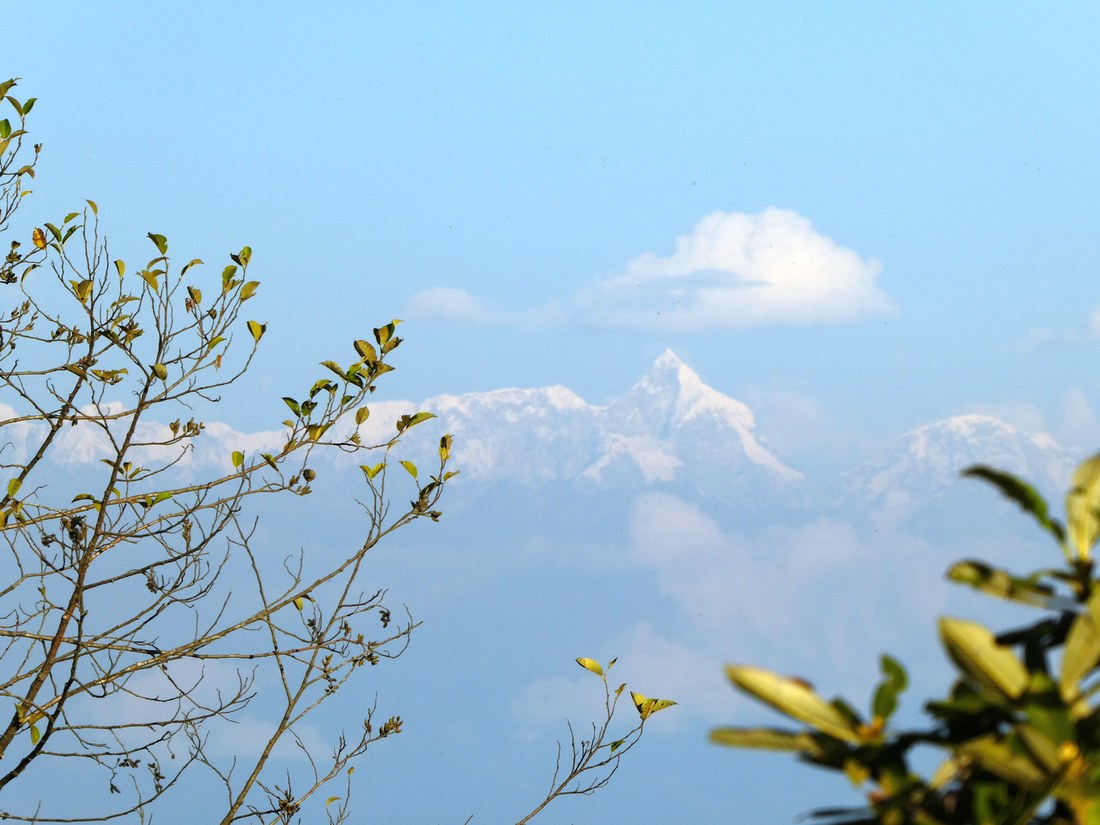
Everest might be the "smudge" just to the right of the very clearly visible "sharp tooth" peak in the image above. We never did "see Everest", as such. Having taught a great nephew of the man who inspired Europeans to call it Everest, I had an extra reason to hope to see it! Please consider visiting the page in my Flat Earth Academy which discusses the Great Trigonometrical Survey of India, and how geographers decided what was the highest mountain on earth... and measured that height.
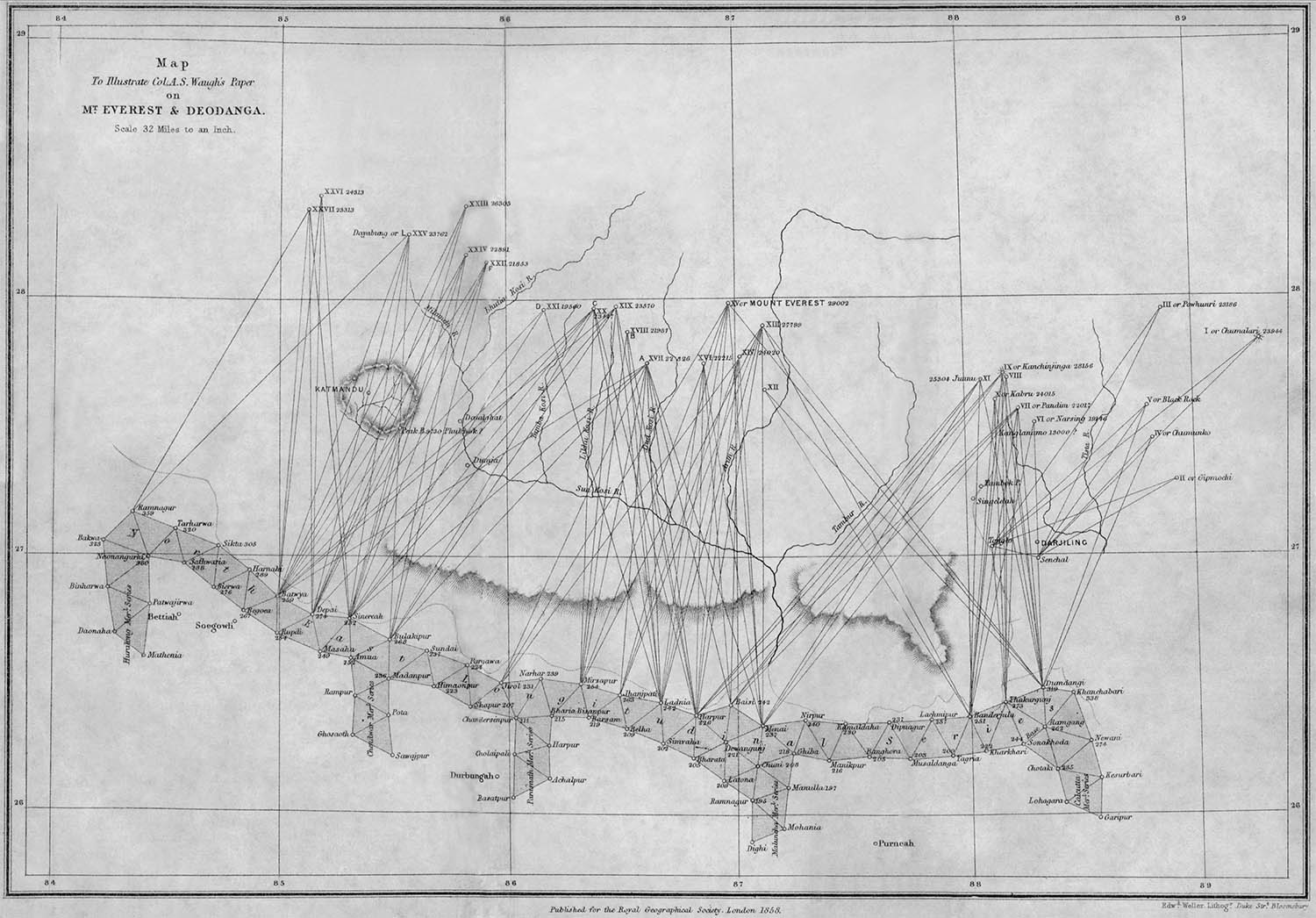
The map above was printed in 1862. See the page cited to learn how remarkable the story behind it is. Try to imagine the work involved in the project.
You can see "Katmandu" on the map- upper left. But Nepal was closed to the British at that time. Nagarkot is, at this scale, just a bit east of Kathmandu... on the "ring" of hills recorded on the old map, I thionk. (That "ring" is not as clear on a modern map!) Access to the excellent trig station location we visited would have been enormously helpful to the survey project.
There's an interesting discussion of "Can you see Everest from Nagarkot?" at Mark Horrell's blog. It has photos. And it reminded me of Peakfinder.org, which I'd stuggled (unsuccessfully) with via my smartphone in Nepal. But! In he UK, on a proper computer- SUCCESS. A FANTASTIC resource. And, for the moment, free to use!
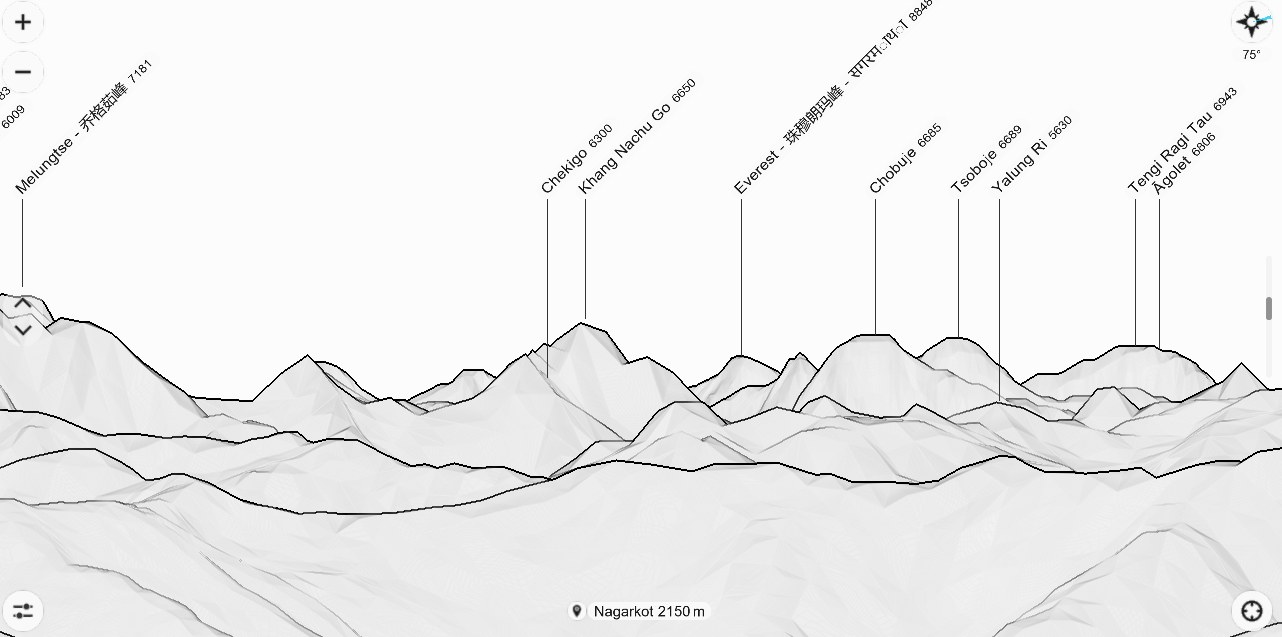

So! What do your think? Is my smudge Everest? I'm not to sure. I say "Everest was in a view I had of the Himalayas." Carefully different from "I saw Everest", alas. Maybe I need to go back? I think maybe my "sharp tooth peak" may have been Numberchuli... bearing 086° from Nagarkot. If so, I only needed to turn 10° to the left to look at Everest. Oh well. A nice example of why research before a trip can be so beneficial.

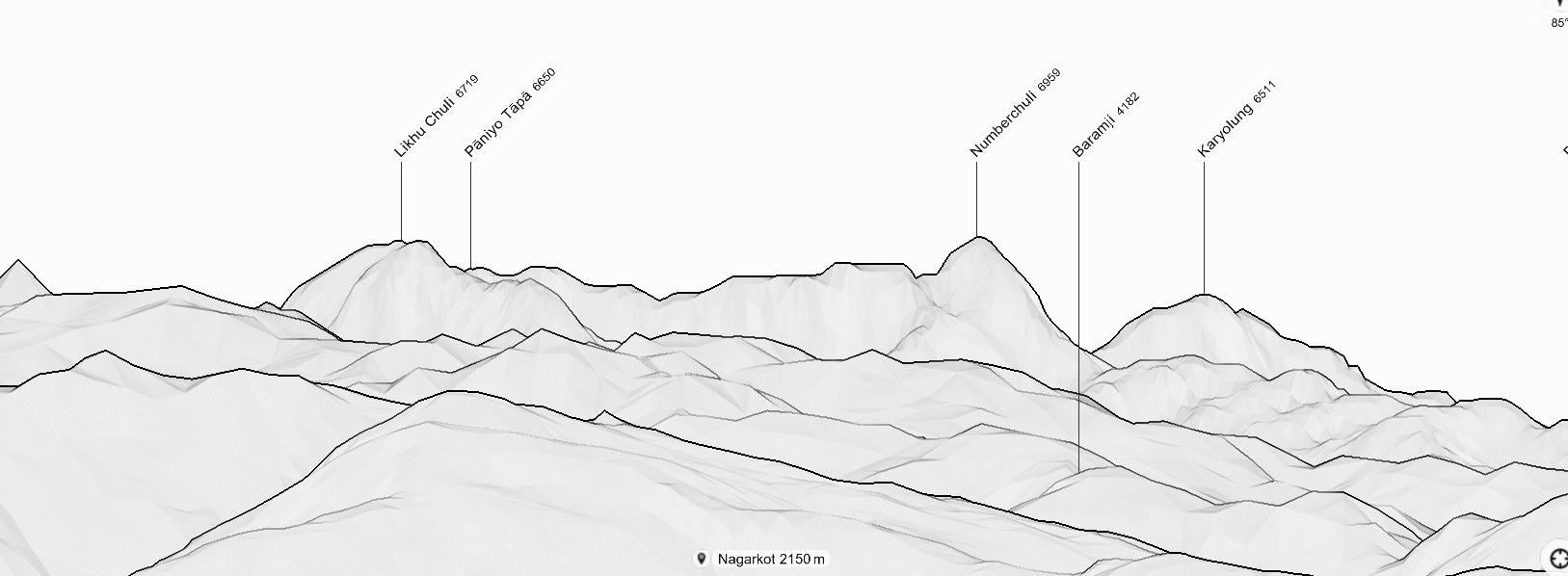
Oh dear... just one more... What you see below is what I grew up seeing when I looked West. Flat prairie to North, East and South... but this magnificence to the West. My family moved when I was 9, but I have never got over having mountains outside my window. (The two images below do not depict exactly the same arc of the Colorado front range. The diagram is exactly what I saw when I looked west.)
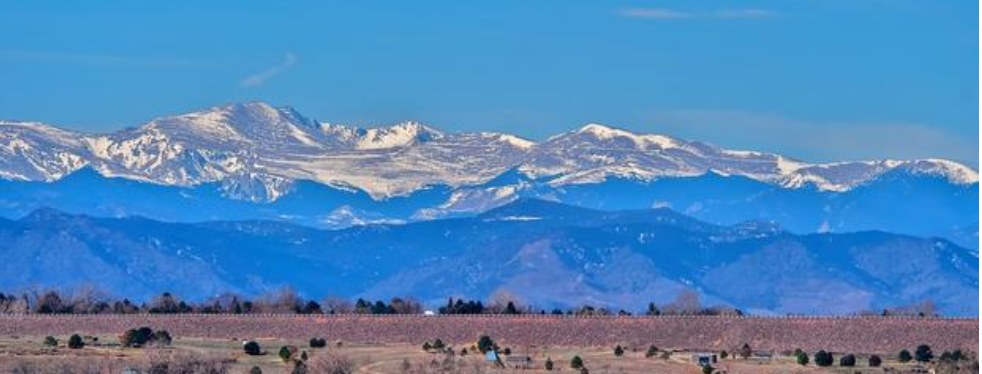
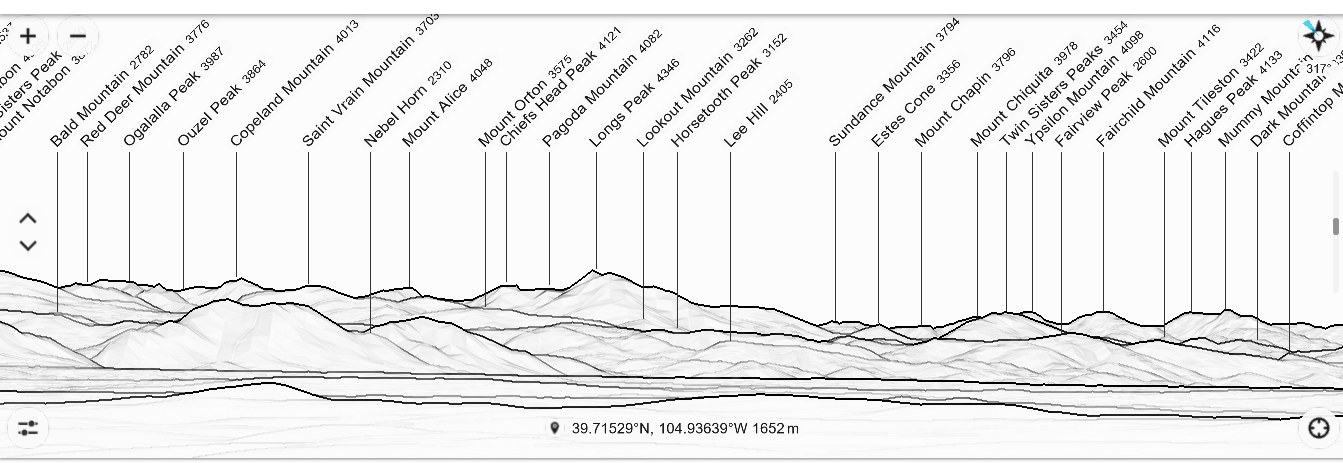
Day 18 continued... Tonight, we enjoy a Welcome Dinner together at our hotel.
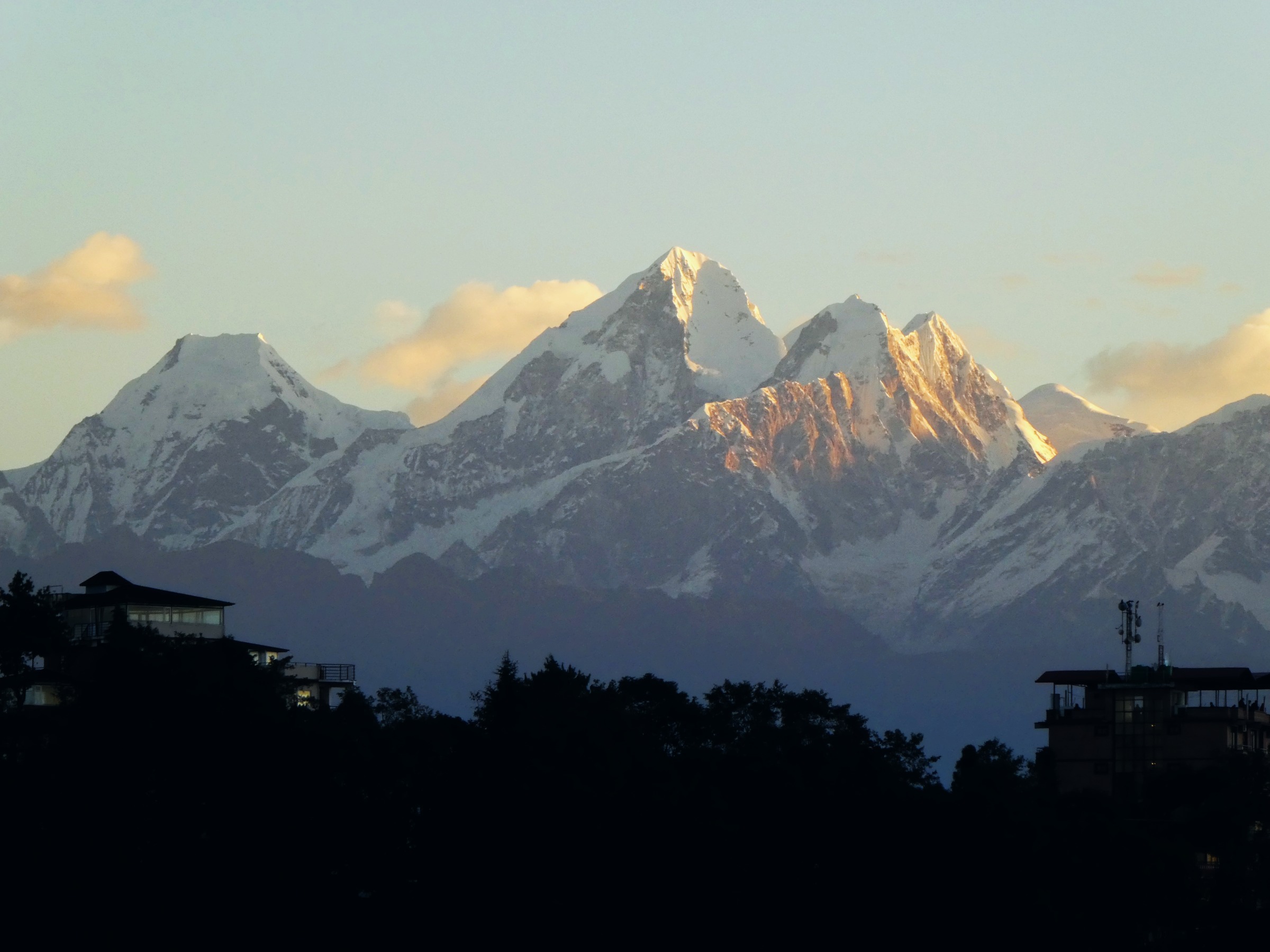
Accommodations: Club Himalaya Nagarkot
Meals: Breakfast, Dinner
==========Monday, November 20, 2023

Arose in Nagarkot, went to bed in Kathmandu. (Nagarkot is just a little east of Kathmandu, at the scale of the map.)
This section also covers final relocation from Kathmandu to Delhi (22nd), and flight back home (23rd).
DAY 19: Nagarkot/Kathmandu- After another chance, weather permitting, to enjoy the spectacular sunrise in the Himalayas, and breakfast, we leave Nagarkot, and travel toKathmandu, with a visit to Bhaktapur en route. Bhaktapur translates as “City of Devotees.”
Bhaktapur is the least developed of the valley’s three cities, and also ranks as a UNESCO World Heritage Site. The city’s unspoiled ancient square and warren of medieval streets make Bhaktapur virtually a living open-air museum, and the town is known for its fine artisans, abundant temples, colorful festivals, and traditional lifestyle, which we have the opportunity to see up close. A highlight here is our visit to the pottery square, where we watch local artisans craft their signature pieces.
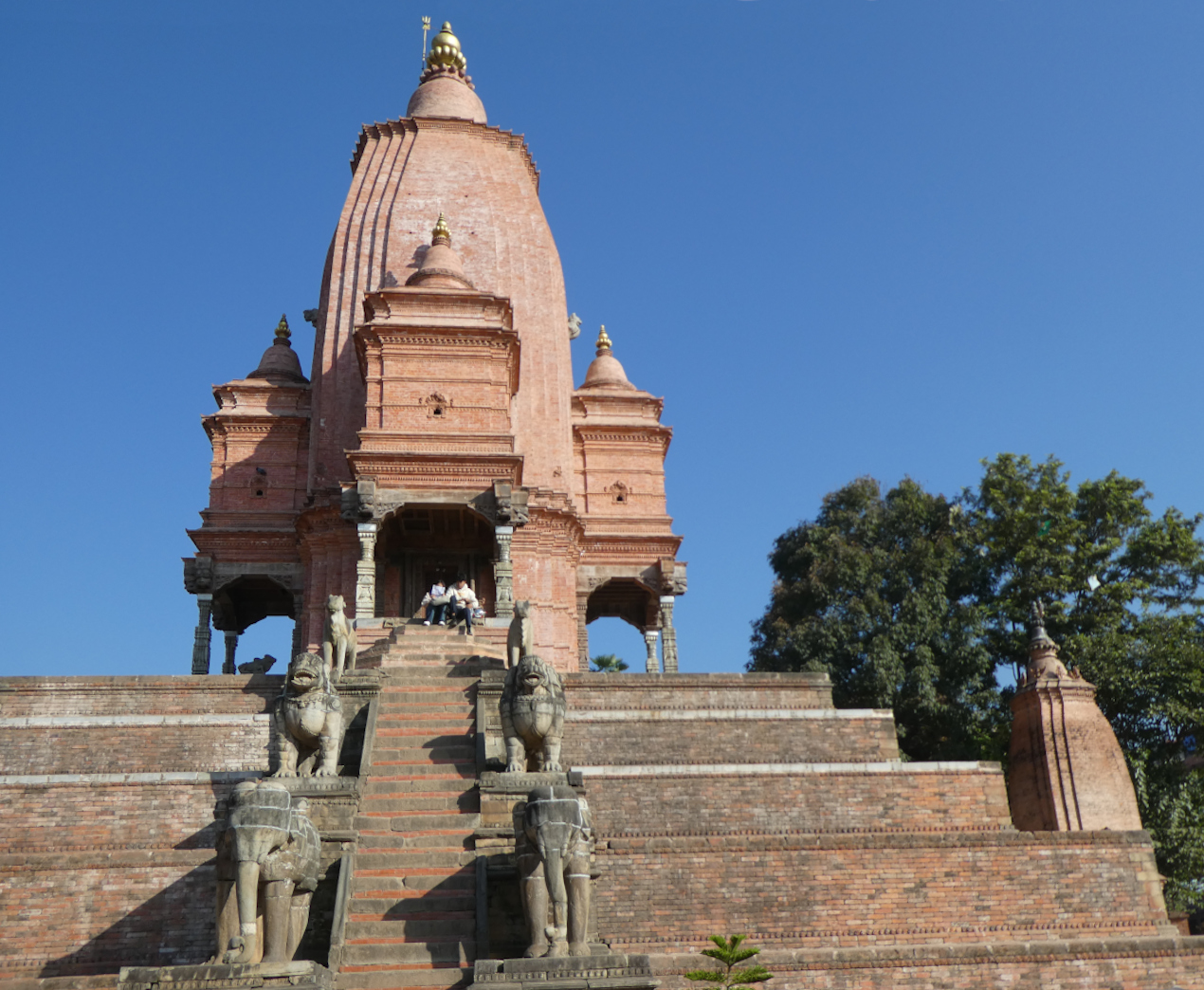
Note the people sitting at the top of the steps to appreciate the scale of this temple. The statues either side of the stairs are the temple guardians. (I can't promise you that this one is in Bhaktapur)
Day 19 continued... After lunch in Bhaktapur, we visit Boudhanath, Nepal’s largest and most important stupa. According to legend, Boudhanath is said to contain the mortal remains of Kassapa Buddha, the Buddha immediately preceding Siddhartha Gautama, on whose teachings Buddhism is founded. The actual date of the stupa’s construction has been lost to history, but some Nepalese chronicles trace its origins back to the early 5th century BCE.
This huge, white, dome-shaped monument boasts hundreds of colorful prayer flags fluttering in the wind; draws millions of religious devotees, seekers, and tourists annually; and serves as the religious center for the many Tibetan immigrants who now live in Nepal.
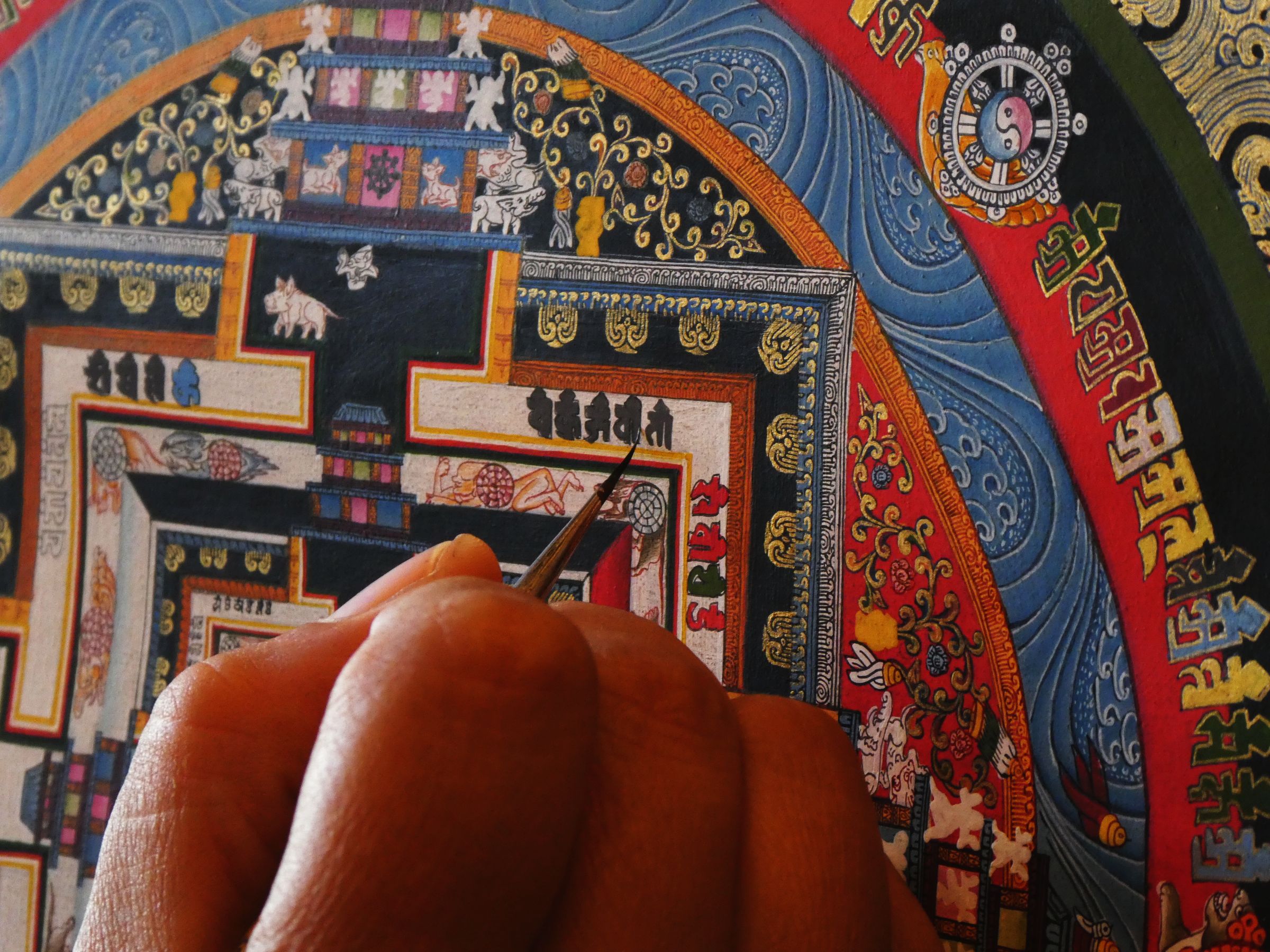
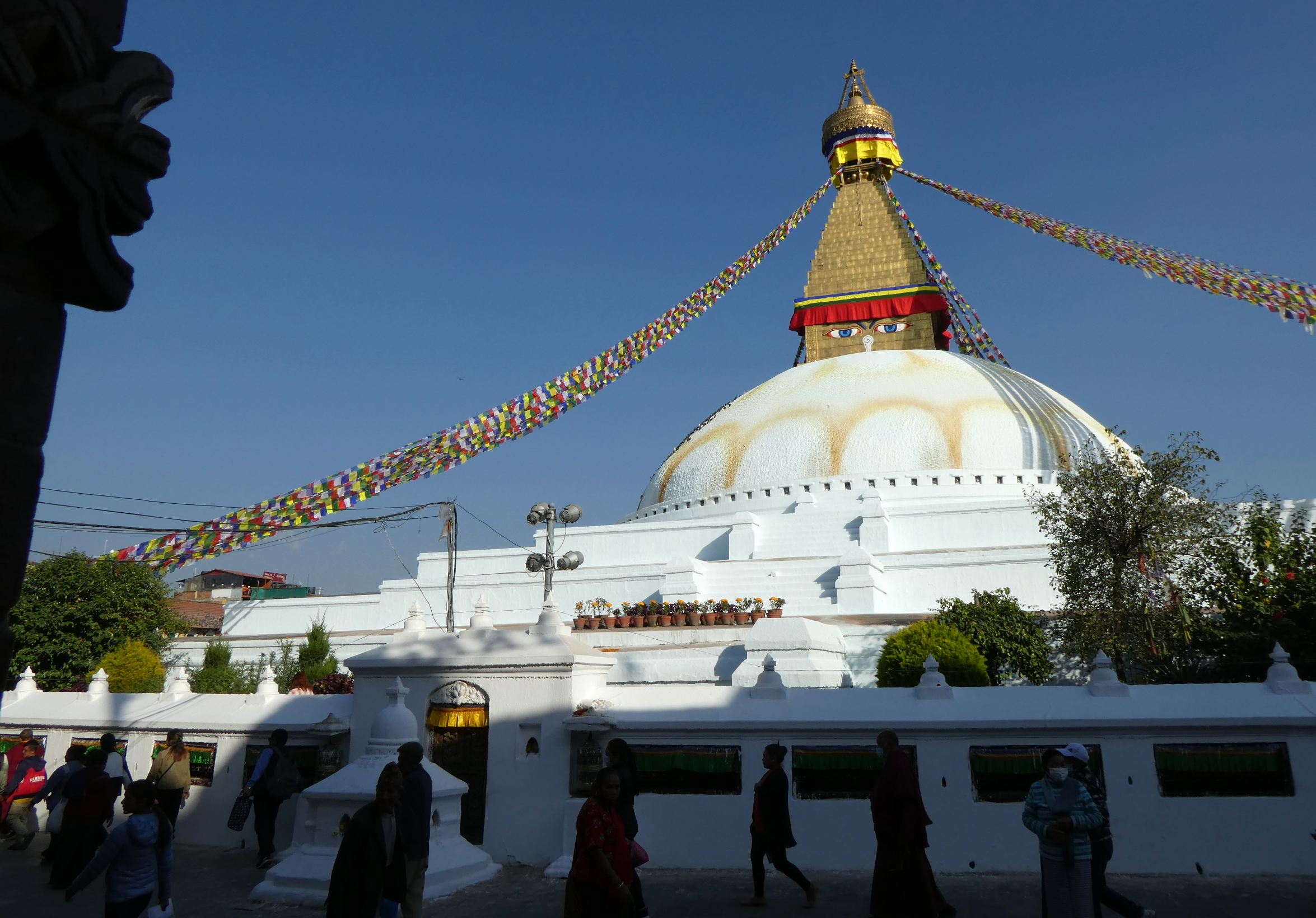
We visited many places where traditional industries are still carried on. I hope to write pages about several these. I have done (!) a page about the calligraphy school in Bhaktapur. Boudha Strupa Thanka Centre, Boudha-6, Kathmandu (https://bstcthanka.com)... and yes, you can order online!)The work of art being created in the illustration here is a mandela, a word I've heard used rather loosly. In precise usage I believe it refers to a representation of a stupa, seen from above. Given that the calligraphy studio's windows looked out on the Boudhanath (see note in Odysseys Unlimited description of day, above), it seemed an appropriate subject.
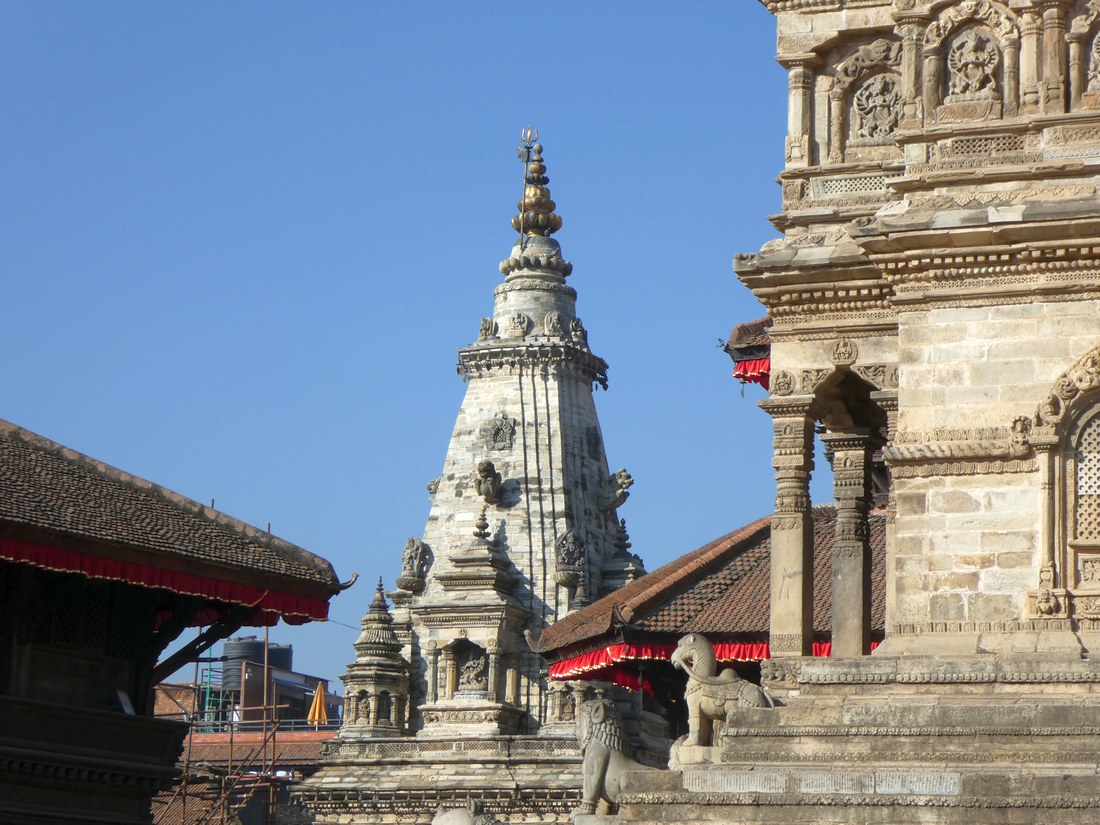
I'm afraid that I can't at the moment tell you exactly which building this is. But that didn't seem to warrant posting including it.
The feast of beautiful buildings, of many designs and tradition in the Kathmandu area was magnificent. And our tour director did a fabulous job of getting us to a splendid selection of them. It wasn't in our program, but when he learned of my interest in education, a visit to one was added to the program. Several times in the course of our time together, we encountered signs that our tour director was not "just" a tour director. The school visit was one of those times. It emerged that he was involved in the school's success.
This part of this page will, I very much hope, expand considerably in due course.
We didn't just see buildings. We saw a living god! (10 years old). All in a huge bowl surrounded by stunning mountains, and with beautiful people in great profusion around us. And the sense that all of this had been here for a very long time was also a factor.
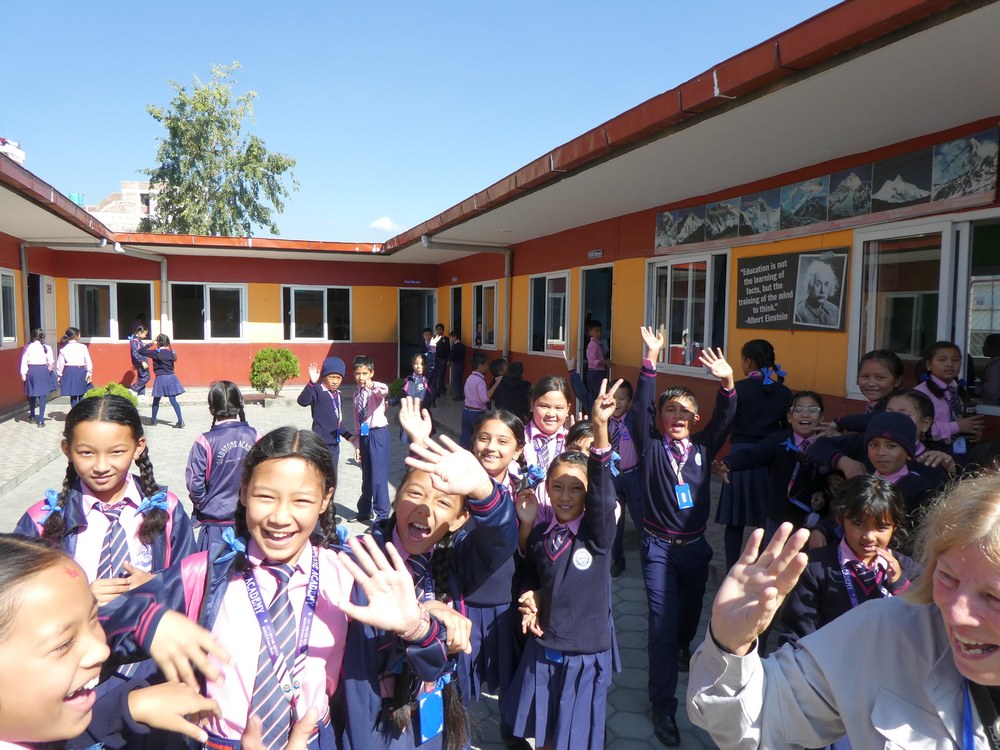
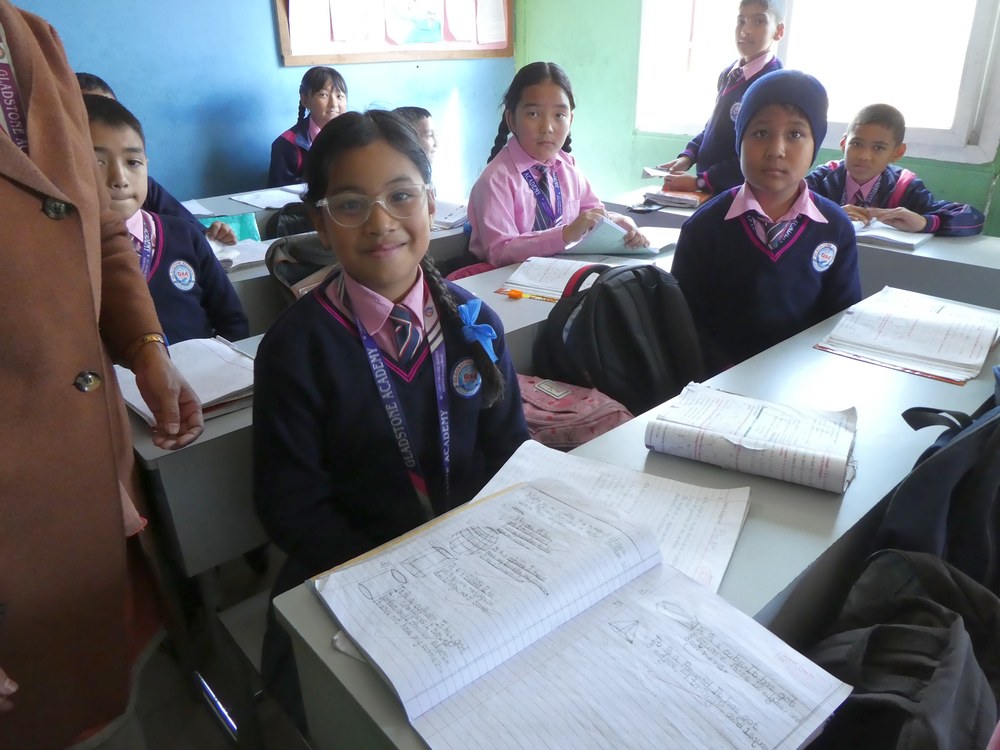
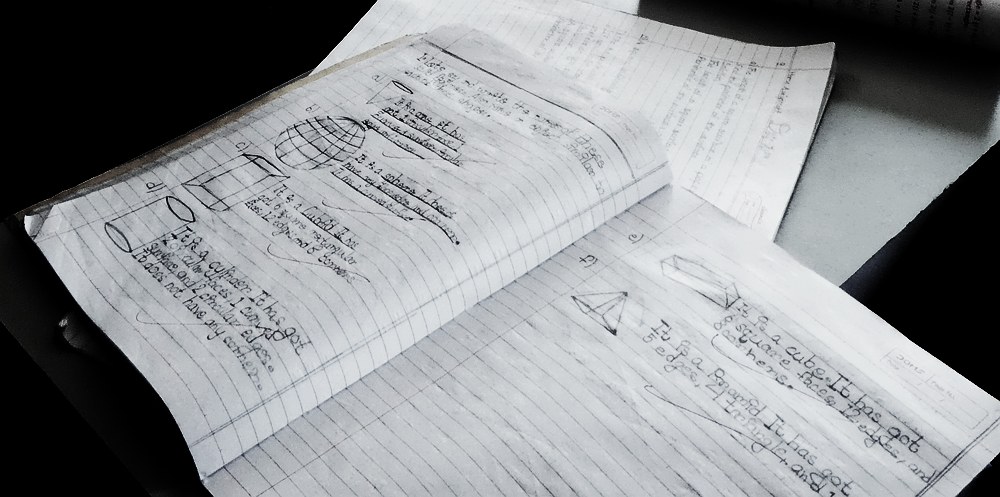
Day 19 continued... We move from Buddhism to Hinduism as we visit Nepal’s oldest and holiest Hindu shrine: the ornate Pashupatinath Temple. The temple is one of Nepal’s most revered buildings, as more than 80% of Nepalese consider themselves Hindus, the highest percentage of any nation on earth.
Here we see sadhus and sages who, in following the lifestyle of the Hindu god Shiva, wear loincloths and cover themselves with ash. A UNESCO World Heritage Site, the temple honors the manifestation of Lord Shiva, one of Hinduism’s three most important deities. Please note that as non-Hindus, we cannot enter the temple itself, but we can see the building and its compound from the riverbank on which it stands. After this full day of touring, we continue on to Kathmandu, where we check in at our hotel. We enjoy dinner together tonight at a local restaurant.
Accommodations: The Soaltee Kathmandu
Meals: Breakfast, Lunch, Dinner
Tuesday, November 21, 2023
DAY 20: Kathmandu- We start our touring today in Kathmandu, Nepal’s capital.First we visit to the Buddhist temple complex of Swayambhunath, situated high on a hilltop and dating to 500 CE.
This iconic site ranks second in importance in Nepal only to Boudhanath. A series of steps brings us to the sacred UNESCO stupa with its white dome symbolizing Nirvana, 13-tiered gilded spire, and the “all-seeing eyes” of the Buddha on each of its four sides. Though a Buddhist pilgrimage site, Swayambhunath is revered by Nepal’s Hindu majority as well. Then we wind through Kathmandu on foot, exploring its many alleyways, stepped temples, and elaborately carved murals on our way to visit the house of the Kumari Devi (Living Goddess), devoted to the tradition of worshipping young girls as a manifestation of the divine female energy.
Day 20 continued... Next, we visit to the Kathmandu Durbar Square, situated in the heart of the old part of the city in front of the former royal palace.
On the outside wall of Kathmandu Durbar, there is a curious great stone wiht an inscription. pp Wikipedia, it was set up (near here, but not as we see it today) in 1664. On it, there is an inscription to the goddess Kalika written in fifteen different languages, using various alphabets... an in among all of that, as you can see, are the words "Winter" and "L'Hiver".
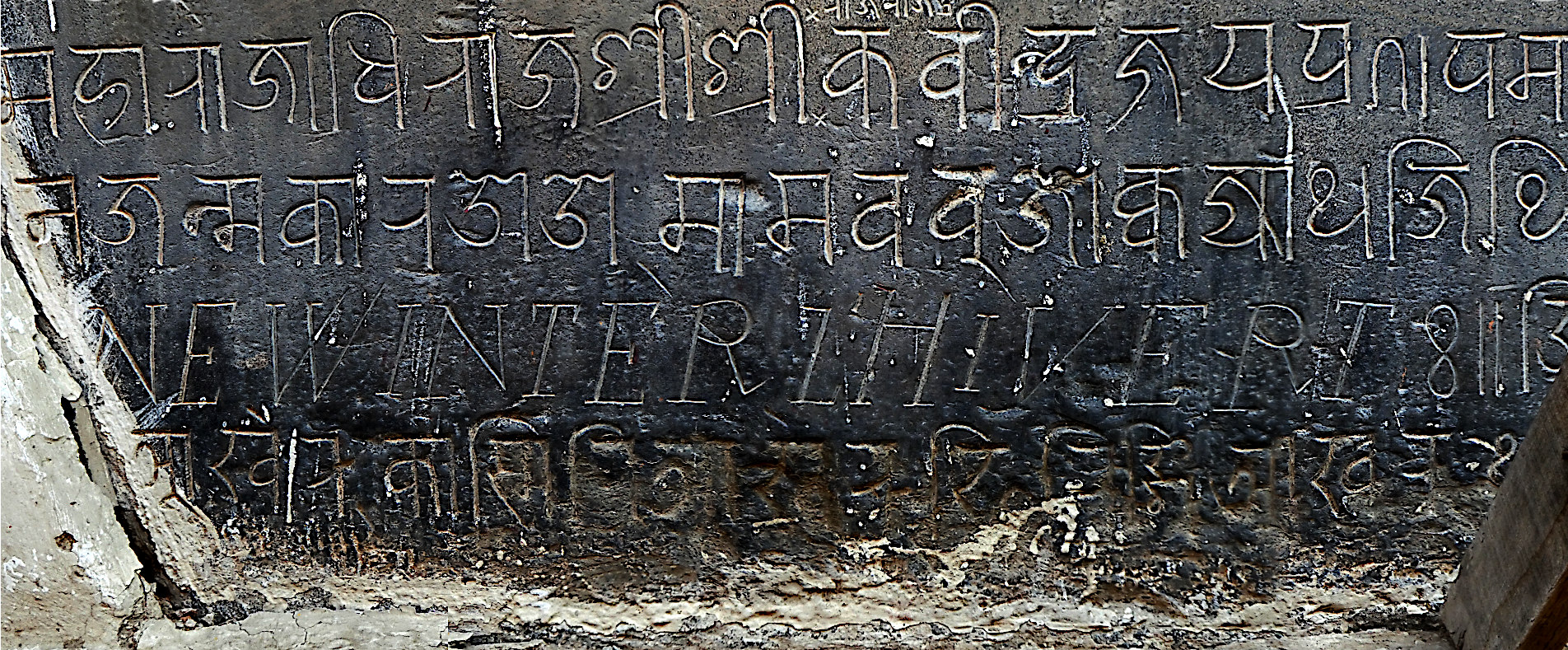
Wikipedia tells us of an account written at the end of eighteenth century which said...
In a wall of the royal palace of Kathmandu, which is built upon the court before the palace, there is a great stone of a single piece, which is about fifteen feet long, and four or five feet thick: on the top of this great stone there are four square holes at equal distances from each other. In the inside of the wall they pour water into the holes, and in the courtside, each hole having a closed canal, every person may draw water to drink. At the foot of the stone is a large ladder, by which people ascend to drink; but the curiosity of the stone consists in its being quite covered with characters of different languages cut upon it.
Some lines contain the characters of the language of the country; others the characters of Tibet, others Persia, others Greece, besides several others of different nations; and in the middle there is a line of Roman characters, which appears in this form AVTOMNE WINTER LHIVERT; but none of the inhabitants have any knowledge how they came there, nor do they know whether or not any European had ever been in Nepal before the missionaries, who arrived there only the beginning of the present century.
At the present time, parts of the inscription aren't visible... only the last two letters of "Automne" are exposed. I confess it took me a long time to figure out that the visible letters weren't saying "New Inter... something". And longer to figure out that it was an "L apostrophe" between Winter and Hivert Again from Wikipedia's notes, Automne and L'Hivert are the French names for autumn and winter. So why repeat winter in English? Also: the word "winter" could be German or Dutch, as they use that name for that season too!
Day 20 continued... We have some free time here for lunch on our own, then we head to Patan, Nepal’s third largest city known for its rich culture and artistic tradition. Also known as Lalitpur (“City of Fine Art”), Patan was constructed in the 3rd century BCE in a circular manner that resembles the Buddhist Wheel of Religion, with four stupas facing the four points of the compass.
Our walking tour here includes Patan Durbar Square, a UNESCO site of historic palaces, temples, and shrines. During our tour, we see some of the city’s many Buddhist monuments and Hindu temples, along with bronze gateways and intricate wood carvings reflecting the time-honored artisan traditions still practiced here today.
This evening, we toast our adventure with a farewell dinner together at our hotel.
Accommodations: The Soaltee Kathmandu
Meals: Breakfast, Dinner
Wednesday, November 22, 2023
DAY 21: Kathmandu/Delhi/Return home- This morning, we transfer to Kathmandu airport for our flight to New Delhi.
For the person who had come from the US, and went on the Nepal extension, this day "worked" well... upon arrival, luggage was claimed, and she (and I) went to the same airport hotel we'd used en route to Nepal. Where the excess bags it had been so helpfully kept for us, while we were in Nepal, were returned to us.
We were supposed to have day rooms reserved, but there was a bit of a mix up on that... the ONLY "swing and miss" in the WHOLE of a very complex tour, with many moving parts.
The person who'd come from the US was able easily to return to the airport that evening, head back to the US. I flew out to the UK at an easy hour the next morning.
Accommodations: Pullman New Delhi Aerocity
Meals: Breakfast
Coming home to landscapes like what's below did ease the pain of the trip being over...
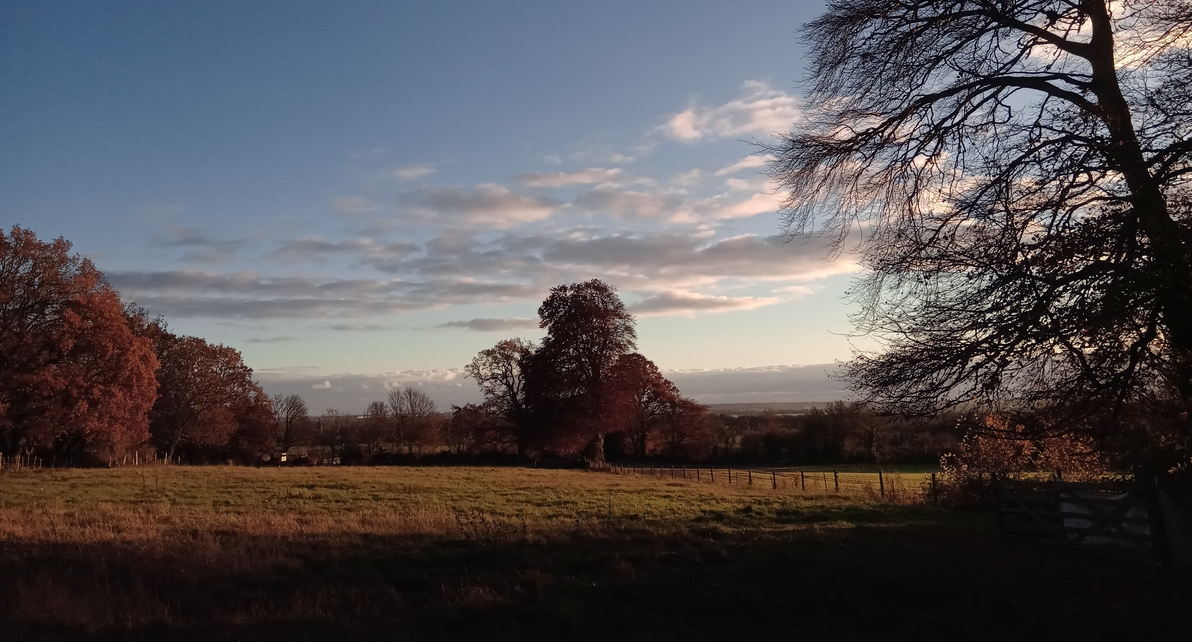
Search across all my sites with the Google search button at the top of the page the link will take you to.
Or...
Search SheepdogGuides.com site, including my trip reports...
|
What's New at the Site / / Advanced search
This search tool (free to me and to you) provided by FreeFind.com... whom I've used since 2002. I'm happy with them... obviously!
Unlike the clever Google search engine, FreeFind's merely looks for the words you type, so....
* Spell them properly.
* Don't bother with "How do I get rich?" That will merely return pages with "how", "do", "I"....
Disclosure: FreeFind tells me what people have searched for. It doesn't tell me your personal details. (If someone would "spy" on you, wouldn't they also feel free to lie in a "privacy statement"? Not to say I'm not lying... how can you tell?... but to say "What are privacy statements worth?".
I have other sites. The Freefind search will not include them. They have their own search buttons.
My SheepdogSoftware.co.uk site.
My "wywtk.com" site...WhatYouWantToKnow
And there are links from those pages to pages at my SheepdogGuides.com, Arduserver.com and Flat-Earth-Academy.com sites.
My oldest-still-going site is at http://www.arunet.co.uk/tkboyd/index2.htm but that does not accept httpS access. An image of most of it is also available at https://skywoof.com/aru/index2.htm
--Click here to visit editor's freeware, shareware page.--
This page's editor, Tom Boyd, will be pleased if you get in touch by email. Suggestions welcomed! Please cite "SheGui/tr/india23/itin-summ.htm".
Page has been tested for compliance with INDUSTRY (not MS-only) standards, using the free, publicly accessible validator at validator.w3.org. It passes in some important ways, but still needs work to fully meet HTML 5 expectations.
. . . . . P a g e . . . E n d s . . . . .